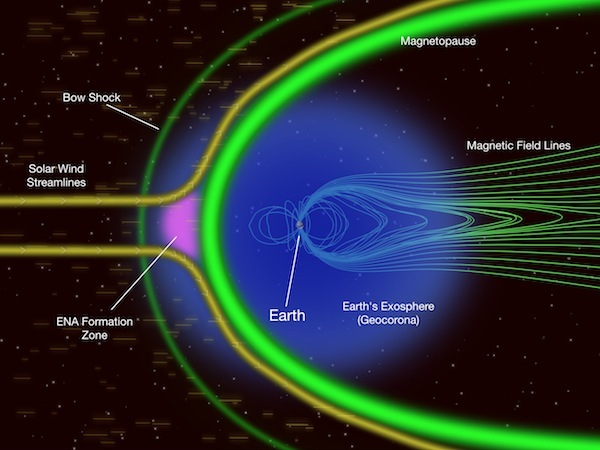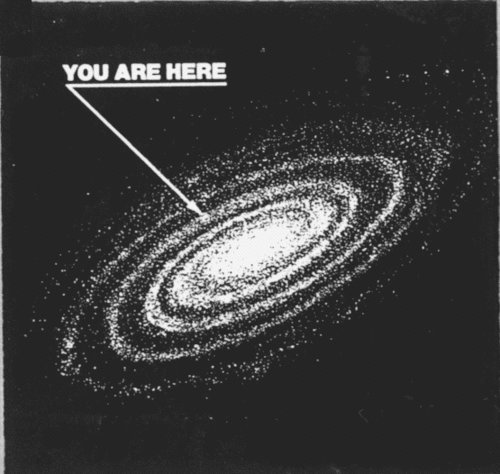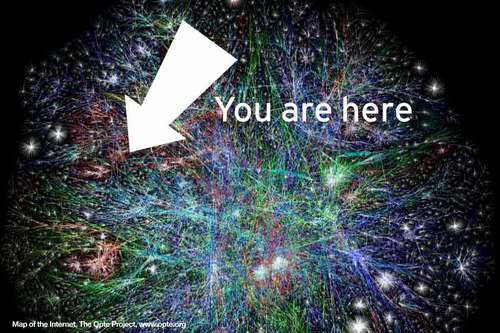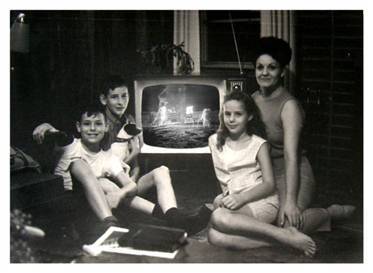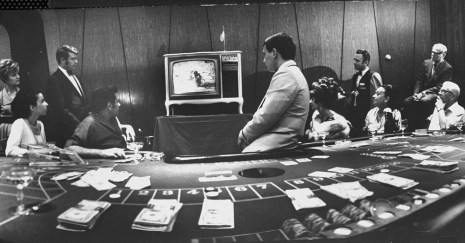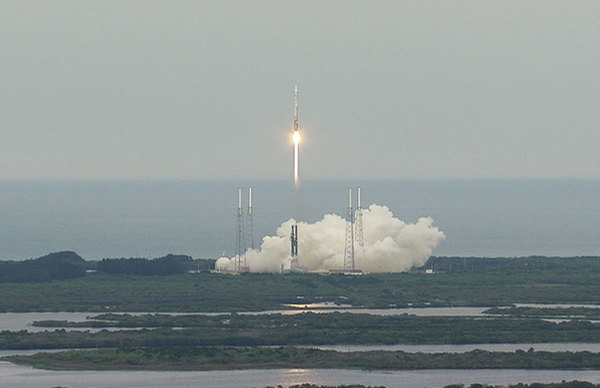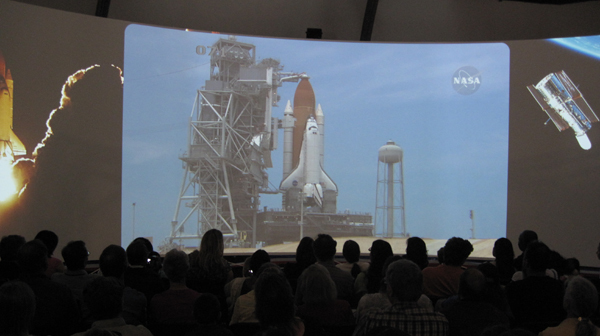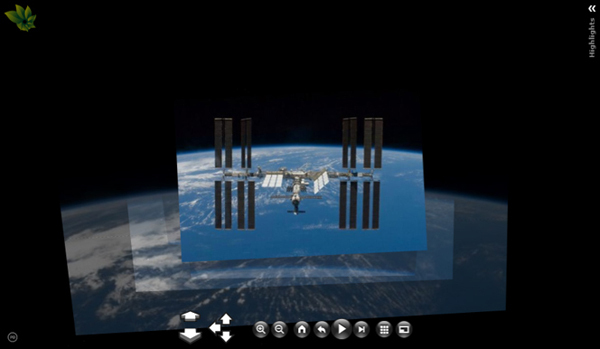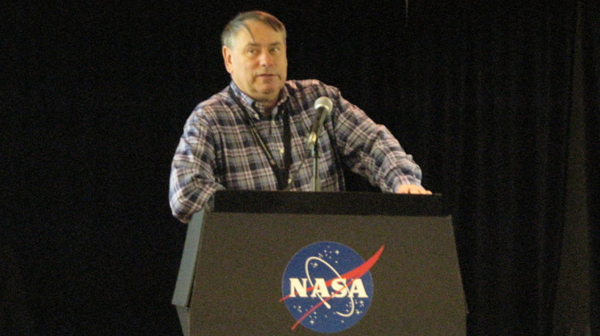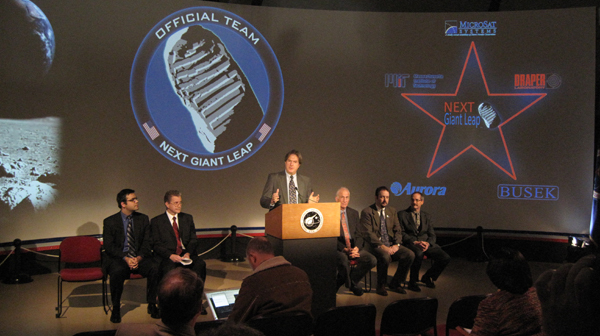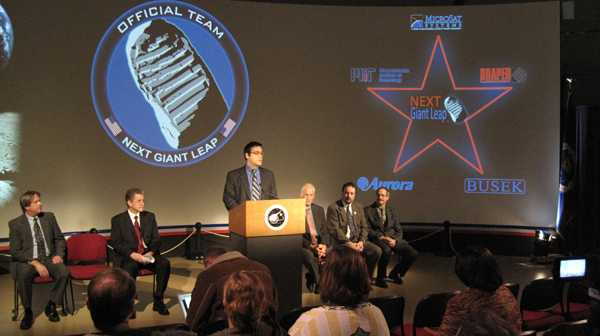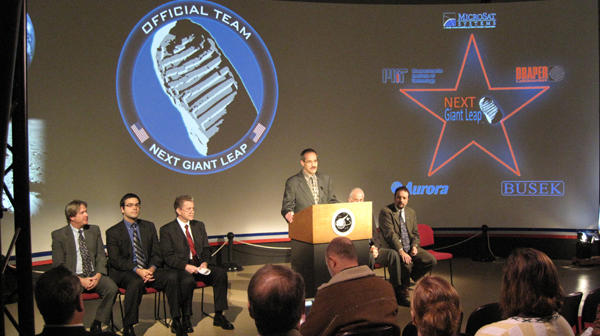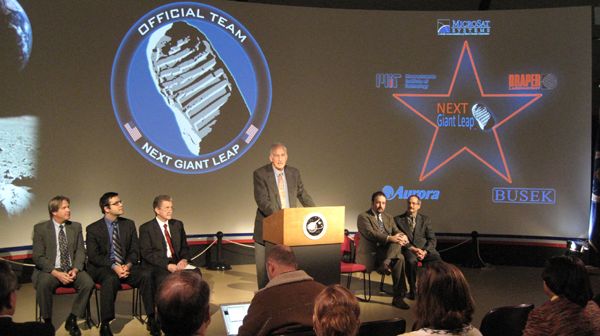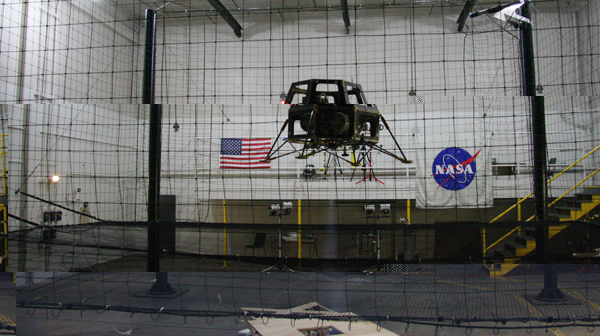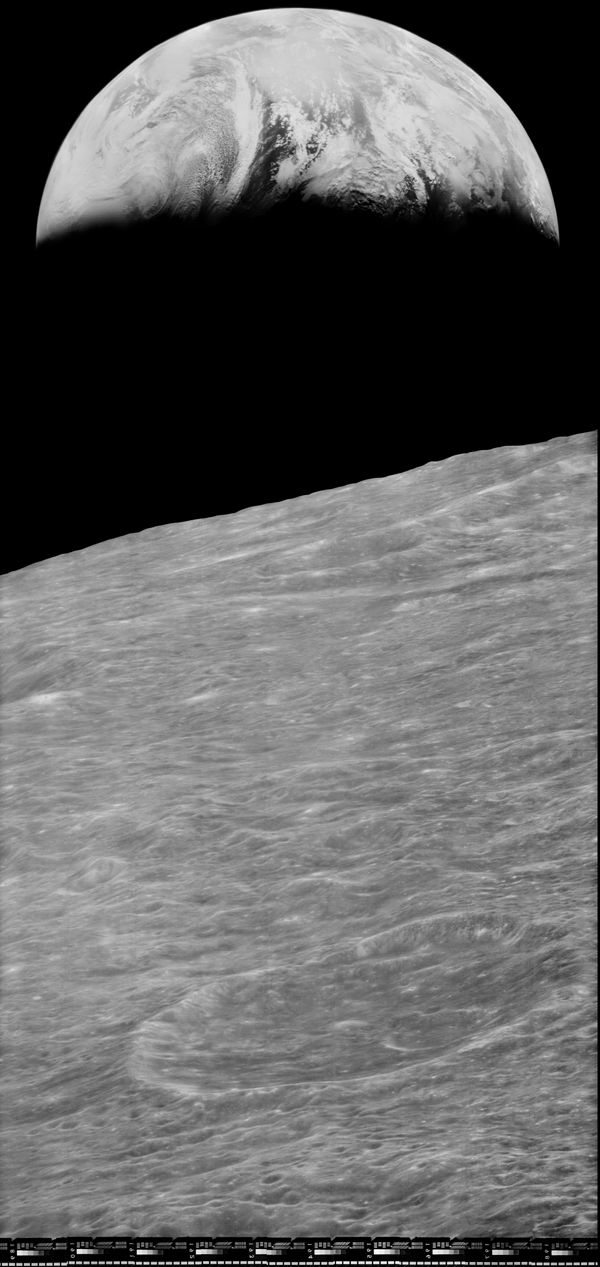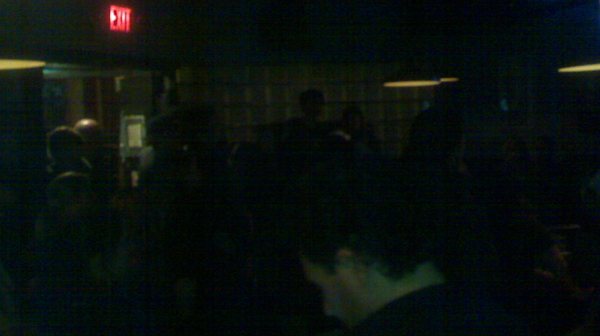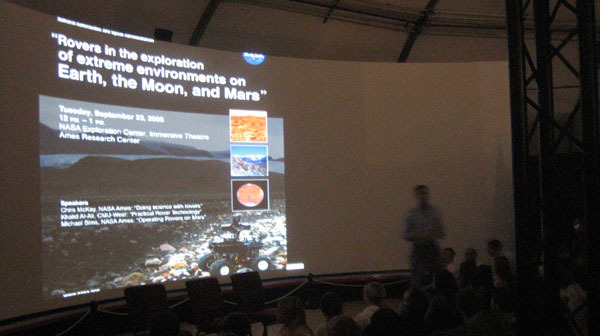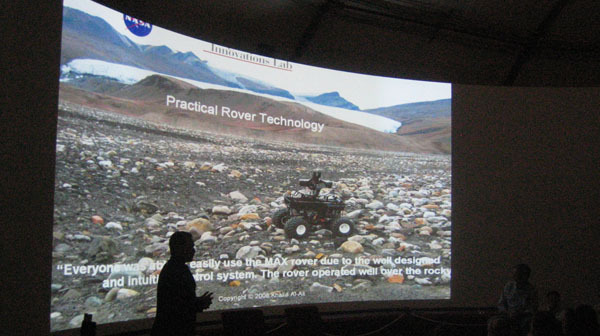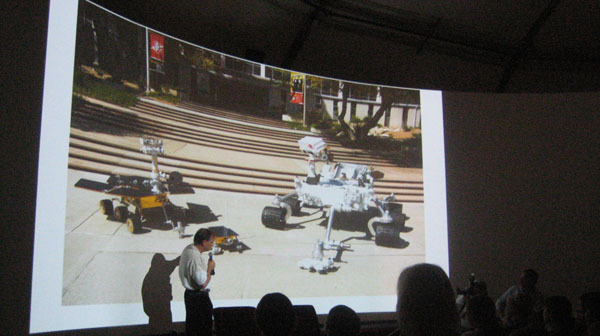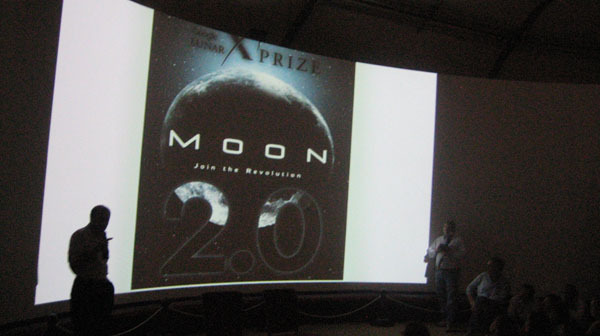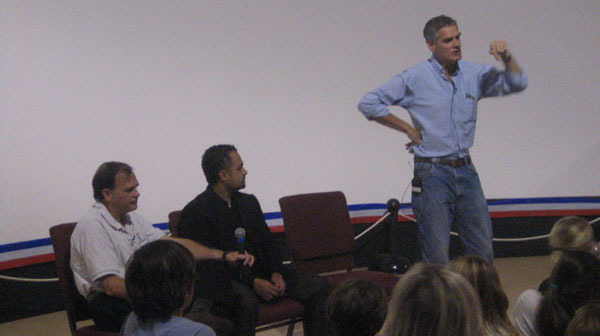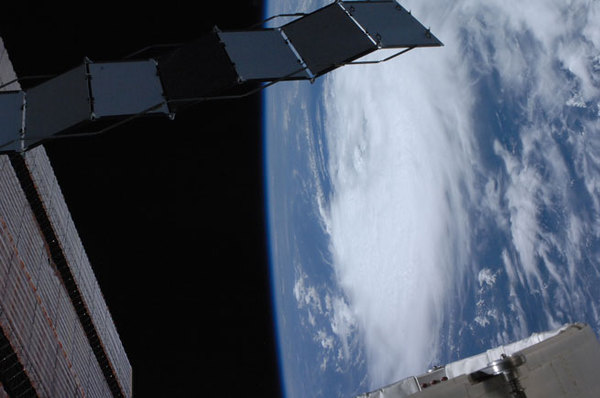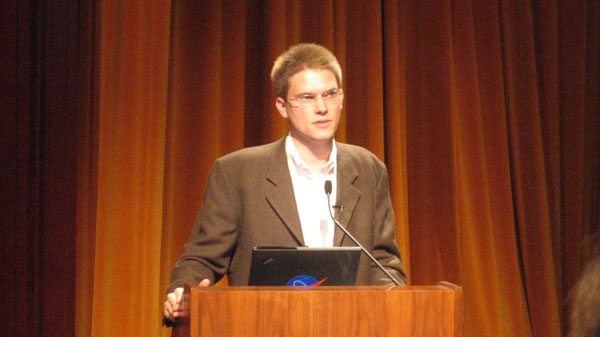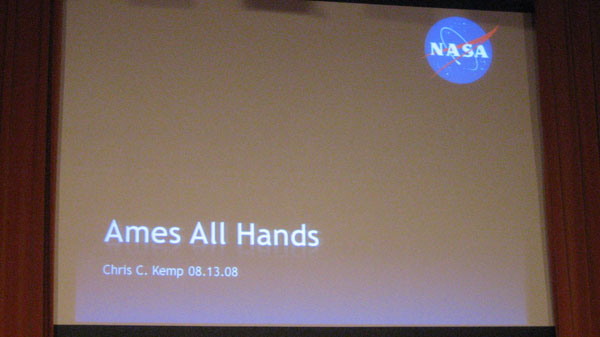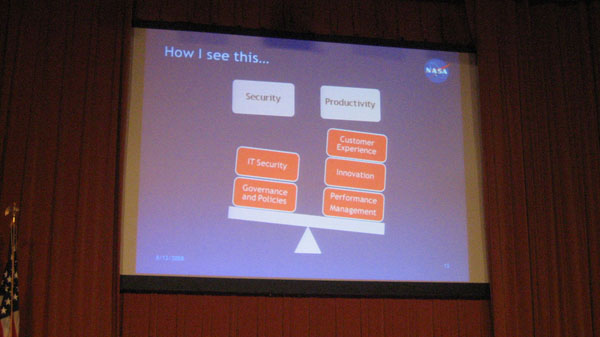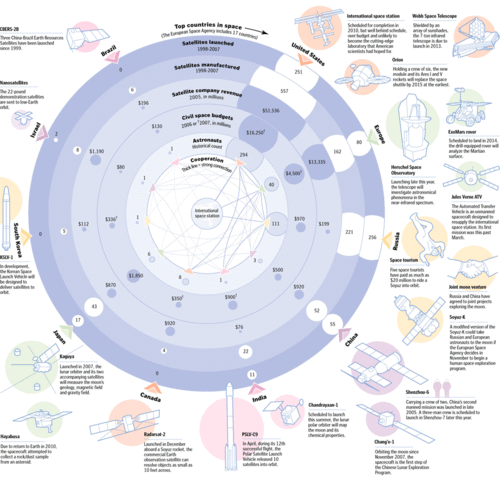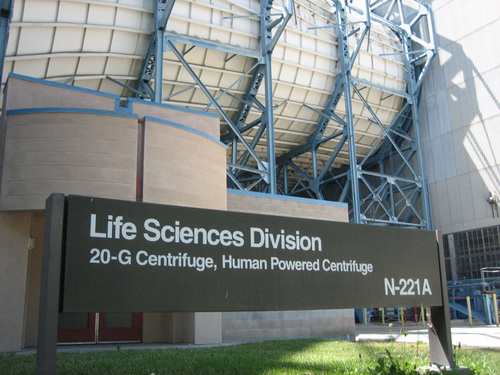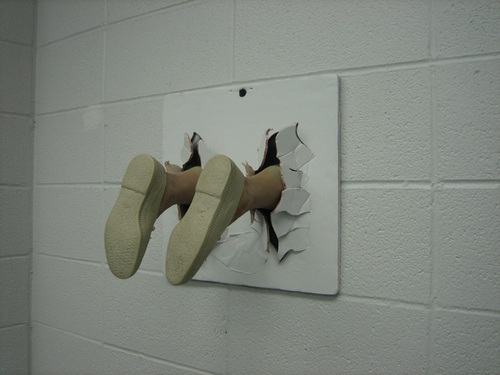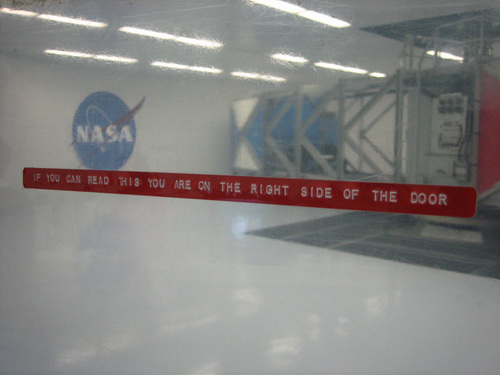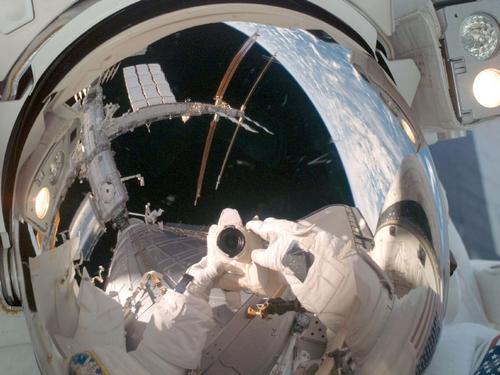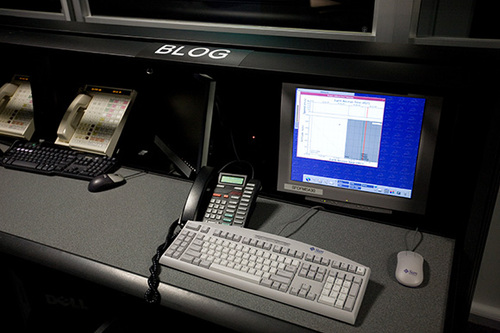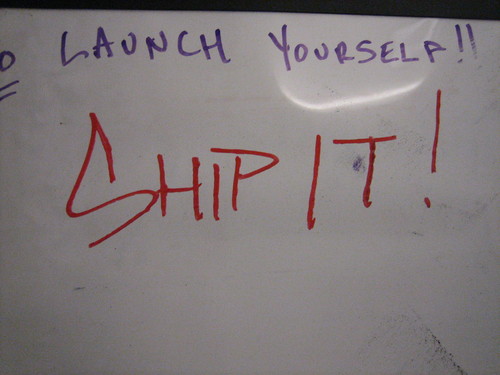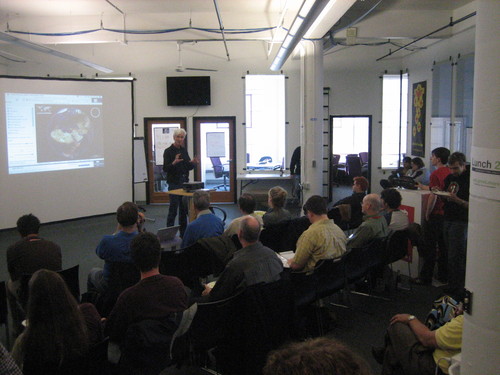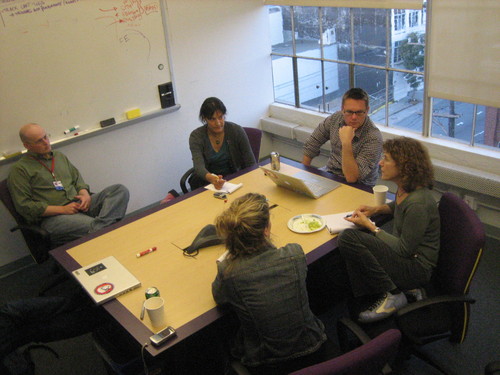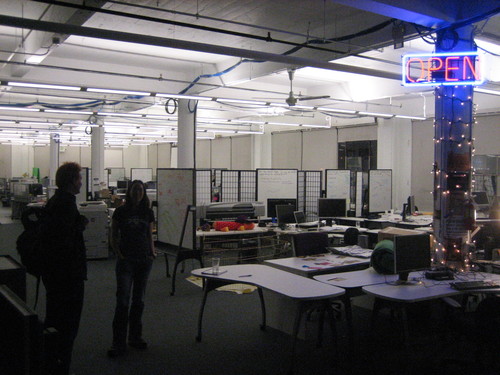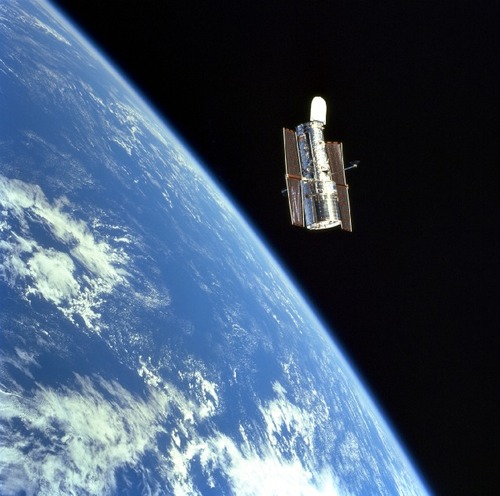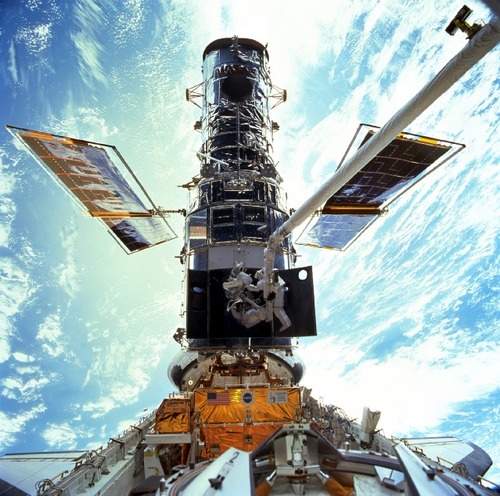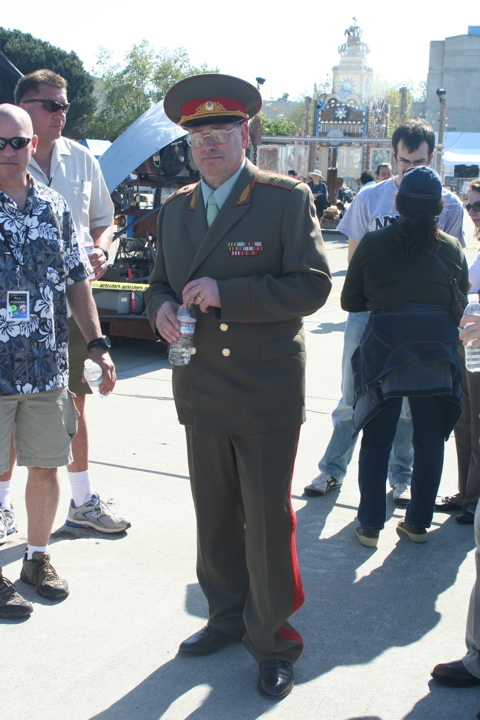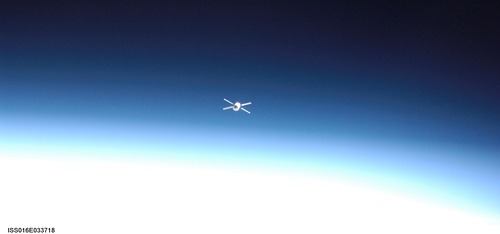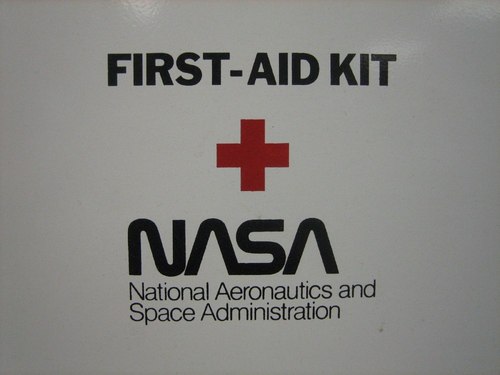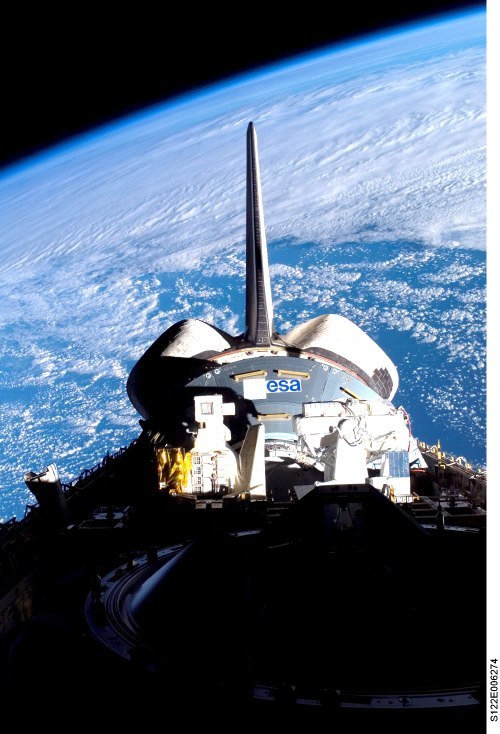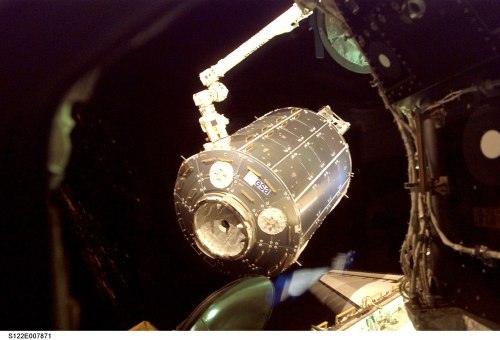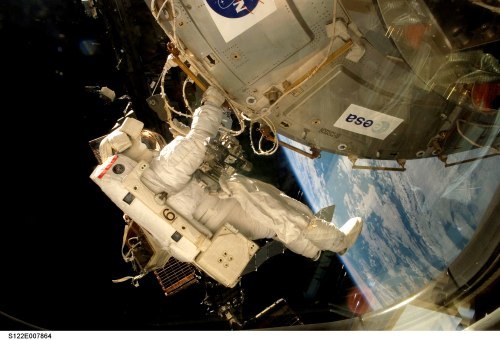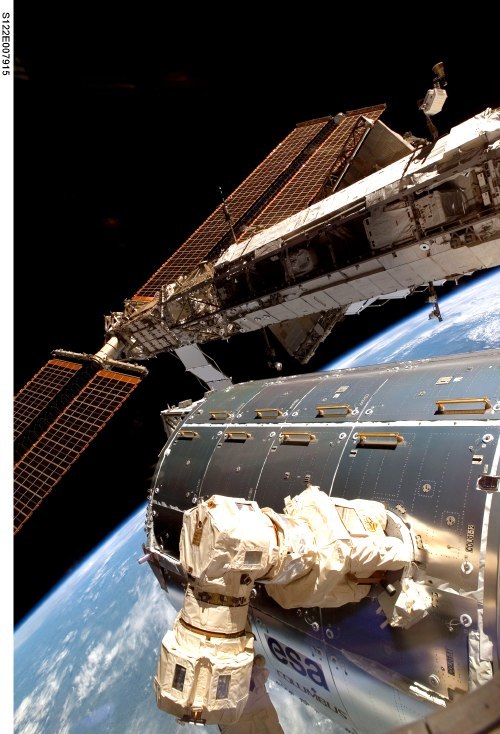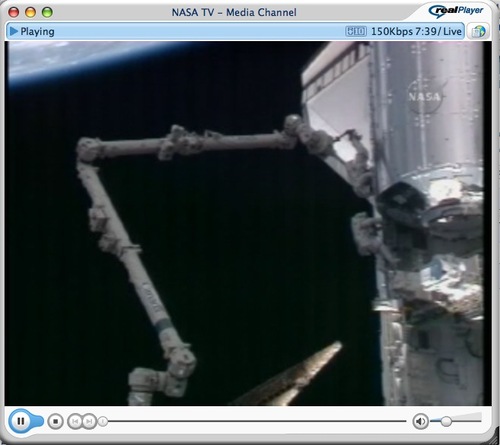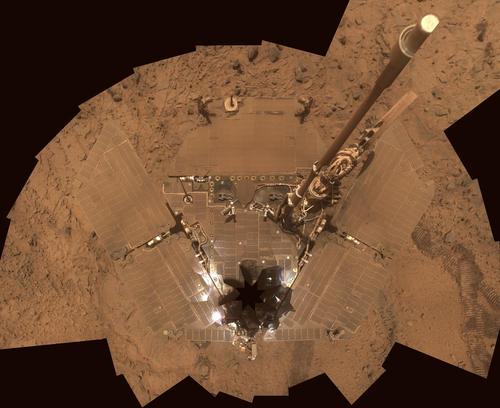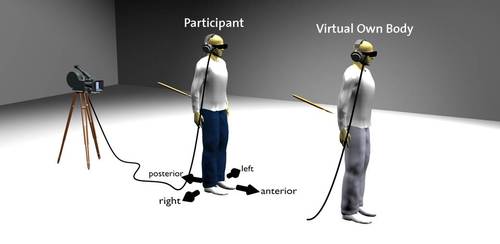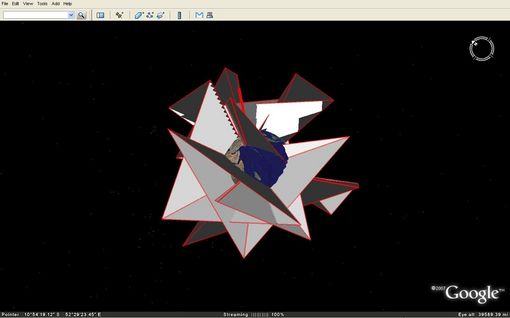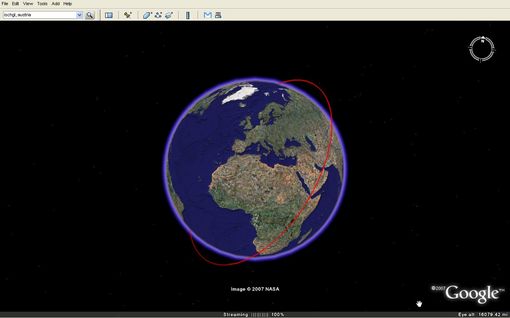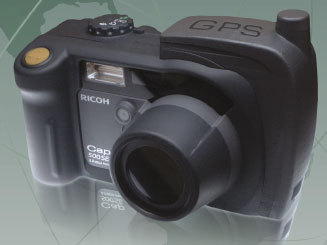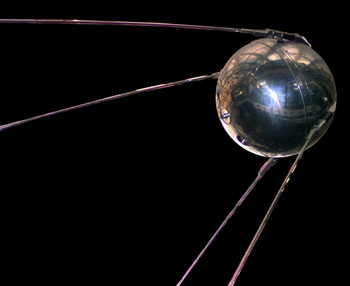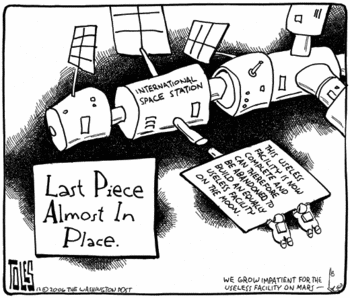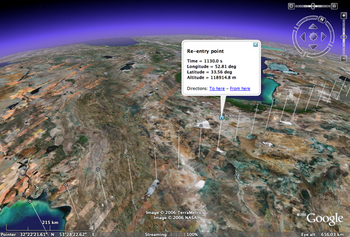This is the Space archive | Back to Main
tobearchived after 6 years
Posted on Monday, September 17, 2012
After exactly 6 years (first post) its time to archive this blog. I've had a great time keeping a trail of my online journeys over these past 6 years and it served me well in my worldly travels, but its time for a new itinerary. I will keep the content up for the Google but I won't be posting here anymore. If you're interested in staying connected, follow me on Twitter @tobedetermined until I find a new home to share my current and future travels.
Sketches of zero-g
Posted on Saturday, November 5, 2011
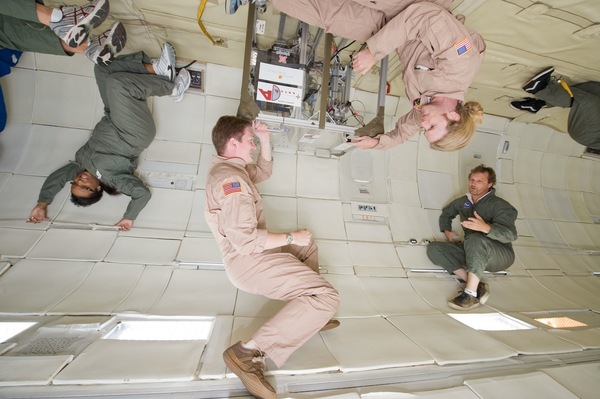
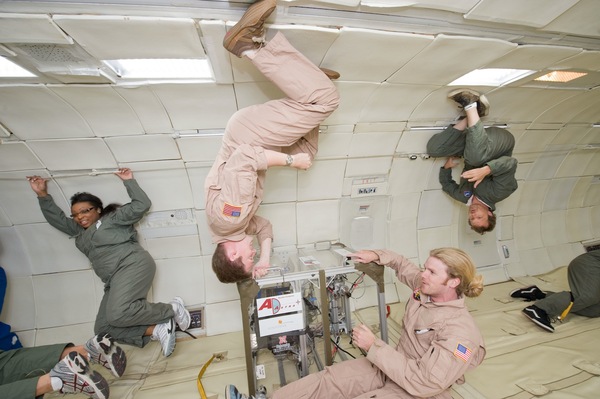
Its been a crazy summer organizing 3 parabolic campaigns out of Ellington Field (go Flight Opportunities). But it was fun for all...
A loss
Posted on Tuesday, March 15, 2011
NASA CTO for IT Chris C. Kemp today announced he's leaving the Agency. Sad story. Given he was the one who convinced me to come over to the Bay Area from Amsterdam, The Netherlands 3 years ago. Meanwhile, the public gets pictures like this:
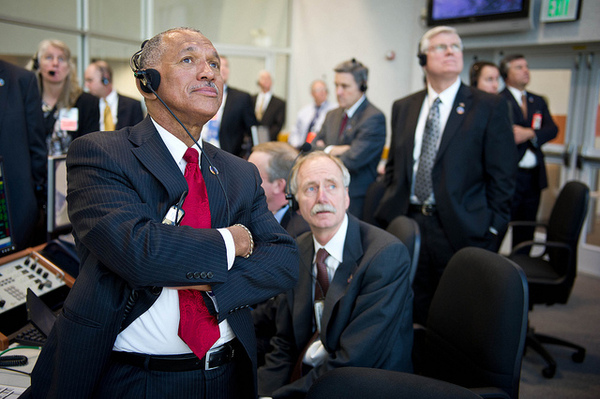
Those views
Posted on Monday, November 8, 2010
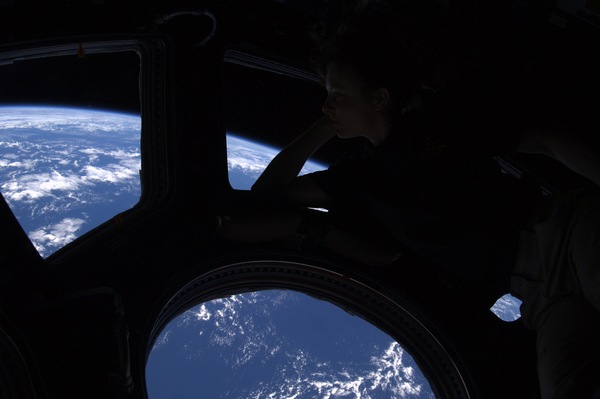
(via NASAWatch)
More intruiging images by the same photographer
Operations Centers
Posted on Saturday, August 21, 2010
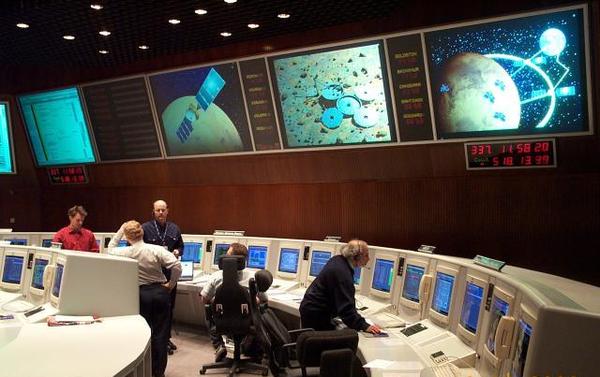
European Space Operations Center (ESA/ESOC)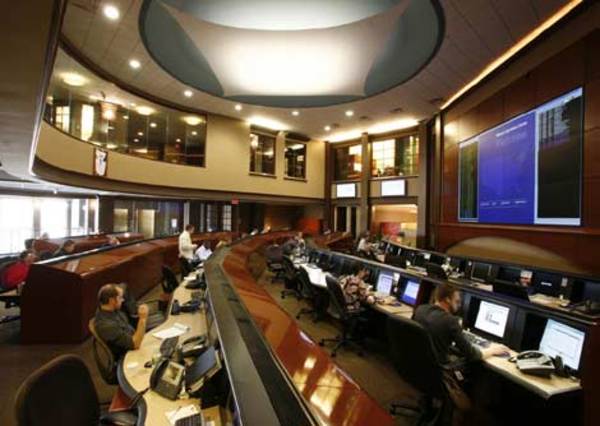
PAETEC Network Operations Center
Satellites as Social Objects
Posted on Wednesday, January 27, 2010
Thanks to my colleagues, and continuing my new found blogging paradigm 'write-until-you-publish' of 2 weeks ago, I am back at writing an ephemeral post to bring online some thoughts I see passing through my conciousness these last few days. No word smithing here, just off the bat words on paper. Like, there is so much conversation and noise about NASA and its future, I don't have much to add, except that I like what I read so far.
I'm having mexican in an obscure taqueria in South San Francisco on my way back up to the city from NASA Ames where I stayed over to watch the SOTU (State Of The Union). And watching it made me realise its very different watching these types of speeches as an outsider, because it makes you realise the 'tribal' nature of these events.
Satellites as social objects? Its a conversation I had at work earlier this week. If youtube can build a platform around video as social objects, Flickr can build a platform around photos as social objects, and Linkedin can do the same around resumes, what would be NASA's most interesting objects to build a platform around?
This week's link, also as a reminder to self: Edge question 2010: How Has The Internet Changed The Way You Think?
Exploring the Future of Space Exploration
Posted on Thursday, May 14, 2009
I'm curious if any of you ever asks that question? And if so, what comes to mind first? For me, its media. Call it New Media, call it Old Media, call it Media2.0, or call it Medea (which actually is an excellent movie by Pier Paolo Pasolini). We might not all get a chance to get up there, but using 21st century technology, we can get pretty close (take that, Hollywood yawn inspiring Star Trek remake).
Here at NASA Ames, in the heart of Silicon Valley (aka New Media Valley), we're surrounded by the New Media vibe. Media evolve with technology, and with Google, Yahoo, Microsoft and alike only a stone throw away, the merger of outer space and cyberspace (sic) seems to be an obvious one.
Yes, there are slow days in the Valley, but there are also these days (and weeks) when everything seems to come together. The Future of Space Exploration? Well, its Low Earth Orbit still, but the ability to personally experience the STS125 mission to Hubble is quite impressive. Its the first time I actually witnessed a mediated launch of a Space Shuttle while being in the US. Standing in the NASA Ames Exploration Center, physically experiencing the low vibrations of the wind blowing at KSC just before launch with the voice over of Mission Control made it a memorable moment.
Last year I worked with a group of people here at NASA Ames to develop a simulation of the STS125 spacewalks (yes, windows only for now). Looking at the real thing today, the feeling of having been there before, in person, is quite profound. If only NASATV would allow me to subscribe to a pinging service that would alert me when the astronauts come out of the airlock for another spacewalk, I wouldn't have to miss any of it.
Also this week (well, last week really), NASA released a new set of Photosynths. Of the International Space Station (ISS) this time. Try it for yourself and dive into the high res images and get a feel of what its like to be onboard and circling the ISS. Its New Media research avant la lettre: how to leverage New Media to get you up there. And as our CIO here at Ames Chris C Kemp says: There seems to be a healty appetite for more innovation in this space.
On top of all that, today we are celebrating three fantastic years of Pete Worden's leadership at Ames! Looking forward for an additional 3+ years of his leadership of NASA's research center at the heart of the New Media (r)evolution.
tobedetermined
Posted on Monday, April 27, 2009
It has been a long while since I last posted anything on this blog. Its not that I have been on holiday or anything, but given the pace of the web these days, blogging seems so...20th century...Twitter is definitely the new blogging. But anyway, lots of good stuff has happened over the last few weeks. Our NASA Ames CIO Chris C. Kemp launched a blog with a pretty inspiring message, Kepler is doing fine, Ames is getting its awards, and frankly, the web is still leading the way towards the stars. NASA is still without a new administrator, but given the dire circumstances here in the US, i can't blame him. And to be honest, NASA does need a bit of a rethink, so the fact that no one has been named so far (I hear its imminent) doesn't strike me as too uncomfortable. So where are we with bringing outer space onto the web? Interesting developments are cooking here at Ames, of which I can't tell much at the moment, but once they are ready to go, i'll be sure to post them here. ps. At least its comforting to see Obama's portrait in building 200 (aka center management building)...
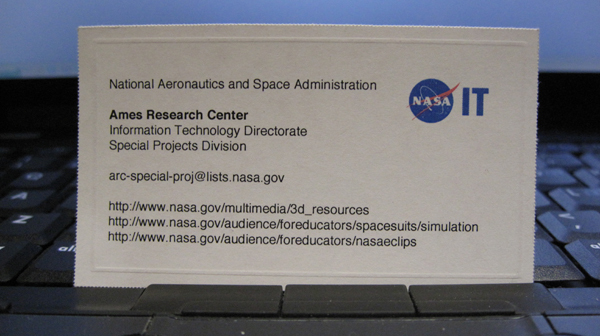
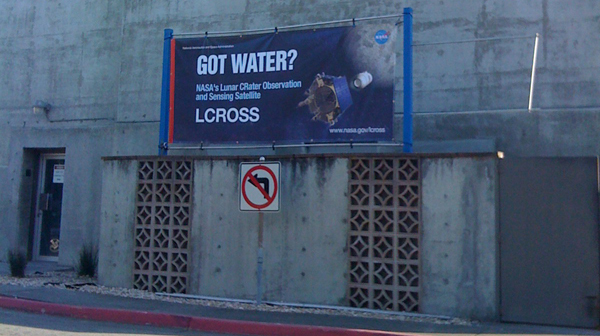
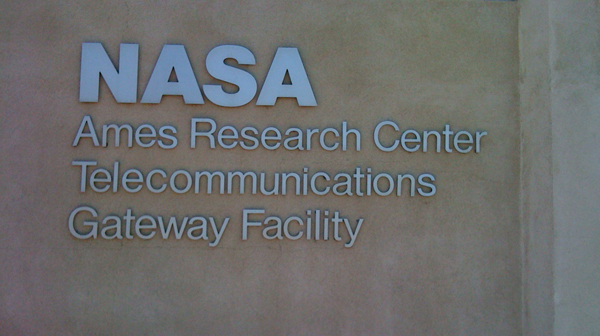
Go Kepler
Posted on Saturday, March 7, 2009
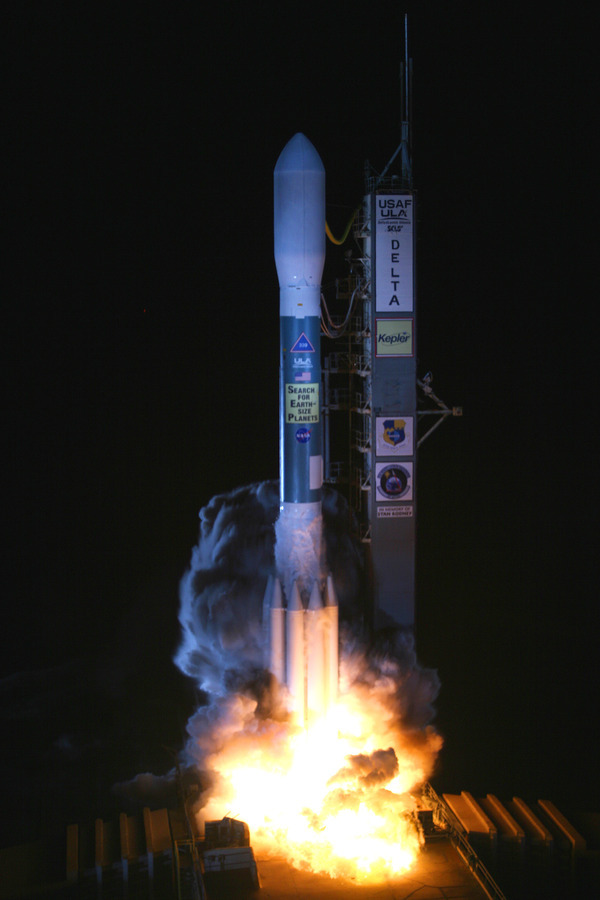
Apparently this is a real image. More at the spacecraft's twitter feed.
Space Definitely Was A Place Once
Posted on Friday, February 6, 2009
On my way to Amsterdam I ran into the excellent exhibition "Out Of This World" at the San Francisco Airport (SFO):
Few people today can recall how fantastic the dreams of outer space were prior to its exploration. The knowledge gained from repeated trips into space has largely eclipsed the wild conjecture about the strange planets existing beyond our atmosphere, the beings we would encounter, and the spacecraft that would take us there. But before space was explored, it had to be imagined. The inspired ideas of space exploration and future technologies are vividly reflected in the related toys and household products that permeated American popular culture in the early to mid-twentieth century.
The accompanying brochure is available here. Some more personal impressions @ flickr.
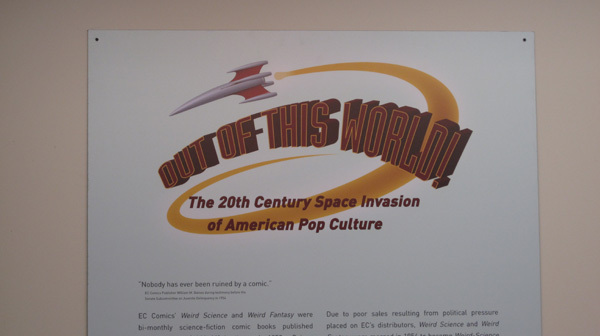
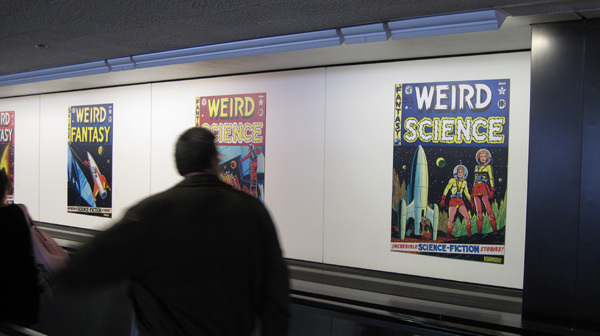

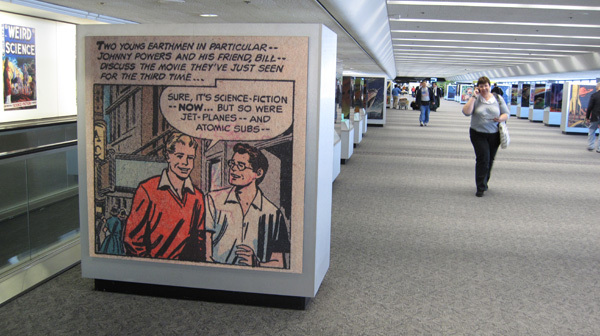
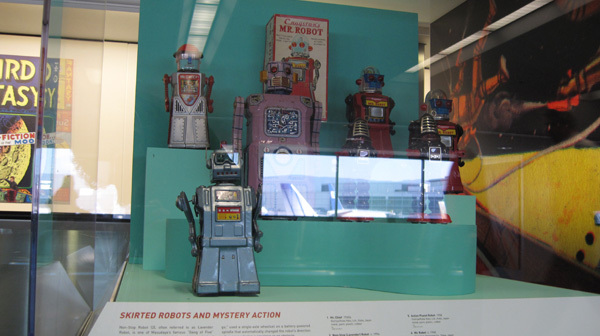
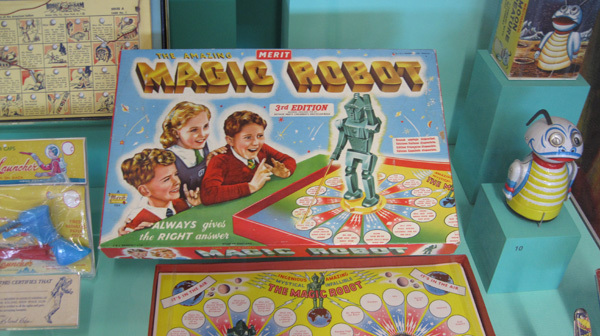
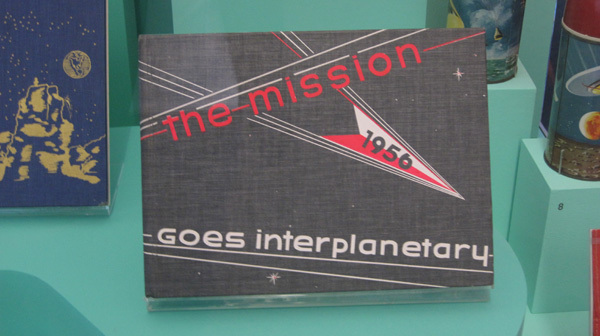

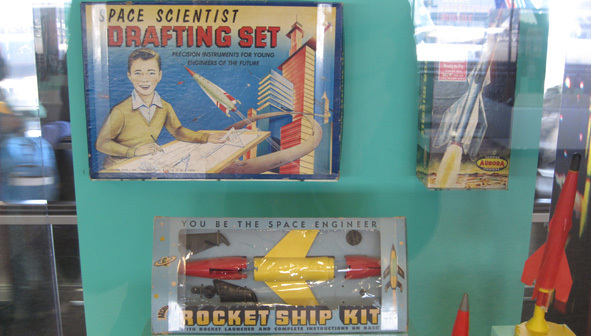
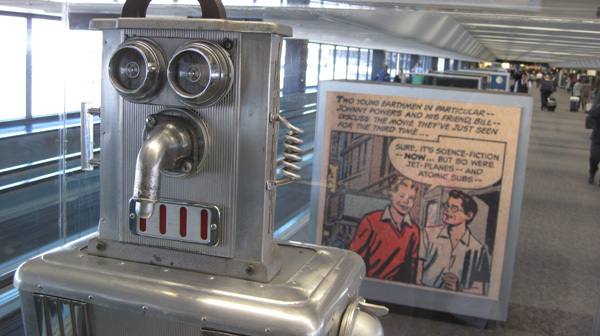
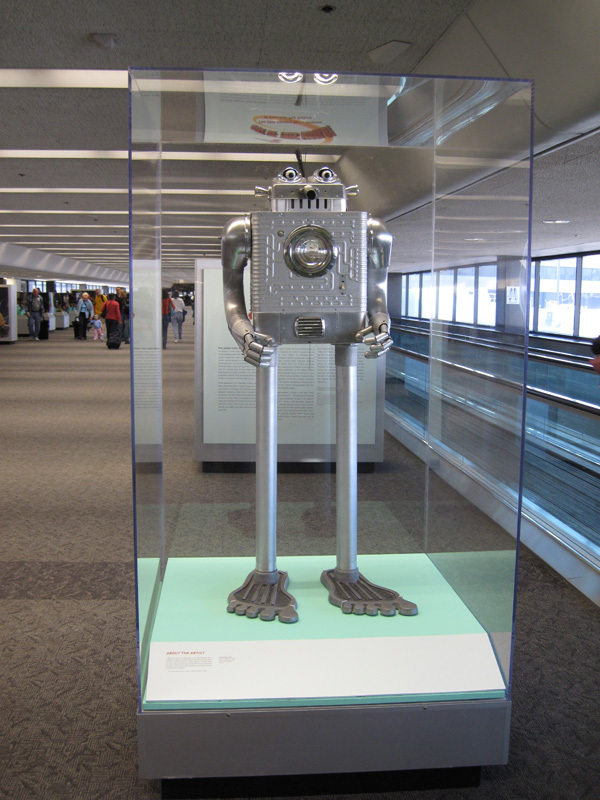

Eating Your Own Dogfood
Posted on Thursday, January 15, 2009

Its a question that has stuck with me for a while: how to get NASA to eat its own dogfood. (((and what would that actually mean in the context of a space agency?)))
(((btw, the 3 ((( thingie I stole from Bruce Sterling's Beyond the Beyond blog. Its like meta discussing your own blogpost...)))
There are different takes on this, and not having had the time to think things completely through sofar (and suspicious whether I'll have it in the near term), i'll just post some thoughts here and plan to come back to it at a later stage and possibly in a different shape and form. (((FYI, I find my twitter updates these days greatly outnumber the number of blogposts I manage to write and am happy about actually going live (there is an increasing number of unfinished blog posts in my movabletype blog webapp), so for all you ~50 readers of this blog, if you're really interested in my irregular updates and ramblings, why don't you take the red pill and subscribe to my twitter feeds on tobedetermined and NASA_Ames_Web because that's where you'll find an up-to-date and engaged research record of implementing the ideas that have been floating around on this blog since 2006, i.e. moving towards a merger of outer space and cyberspace...because make no mistake: its happening, and its happening right here, at NASA Ames Research Center.)))
Part I: eating your own dogfood is a term commonly used in the sofware business when employees of a company use their own tools and thereby create a feedback loop wherein the builders of tools also get to be the users of those same tools, leading to a much faster iterative usability loop and a very efficient way to speed up the evolution of a tool. From what I heard, Google even uses the term 'dogfood' for their internal products. In the case of NASA, one tool in case that would greatly benefit from people eating their own dogfood is its web publishing and communication tool, commonly known as The CMS.
Part II: Following a talk on synthetic biology a month or so ago at the Long Now series, I finally managed to get a tour of the labs here at Ames where scientists work on the future of space exploration. In particular, John Cumbers, Graduate student synthetic biology from Brown University, showed me and Delia Santiago around at his office and labs where he works on cultivating and studying organisms for potential application in space exploration (think: biological fuel generation, etc). The underlying objective here is that space exploration will not get anywhere if we stay stuck in the paradigm of carrying everything we need from the Earth. Launch costs are prohibitively expensive if we need to prepare for a trip by taking every bit of consumable with us upon embarking on the trip (((the Columbus metaphor comes to mind but I am going to skilfully navigate around this outdated metaphor))).
John is particularly interested in applying synthetic biology in realising Biological In Situ Resource Utilization (BISRU), something that has the potential to get us to places where we can build on our own consumables "off the land". One example he gave was testing it out on a comet 2 years away from Earth, with a 2 year return cycle. The labs here at Ames are fascinating, GATTACA comes to mind but in a different context.
The field of synthetic biology is still so new there are no good text books on the subject (((here's a good primer))). They do have conferences about it though.
Below are some images I made while following John around (more at Flickr). Most interesting, the book with the yellow dots is actually a real-life catalogue of genetic building blocks, called the 'Registry of Standard Biological Parts'. Whoever is building genetically engineered organisms can use a piece of pre-fab genetic code from this catalogue by dipping a pipet on the yellow spot, thereby subtracting some specific DNA sample. Its like LEGO, but the biological version of it. Welcome to the future...
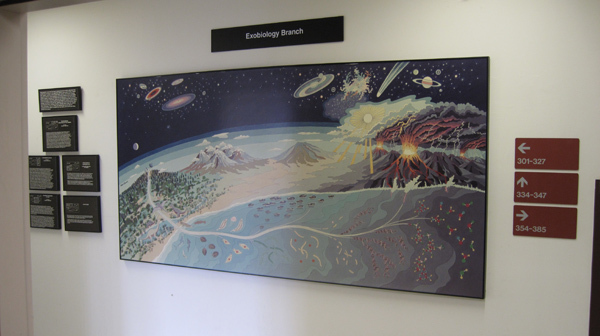
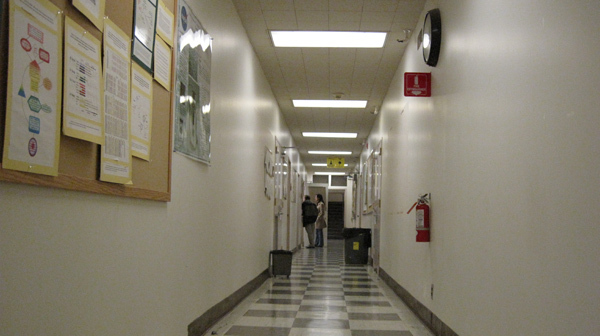
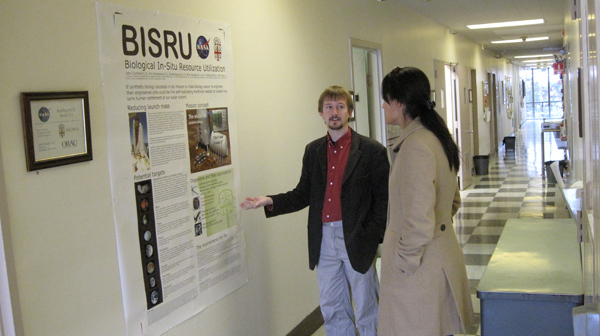
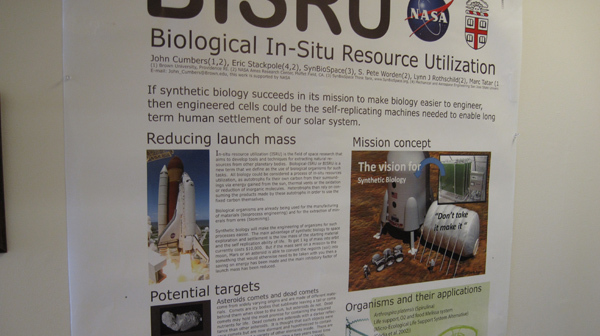
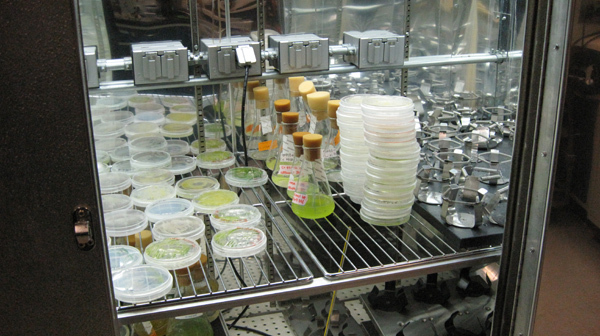
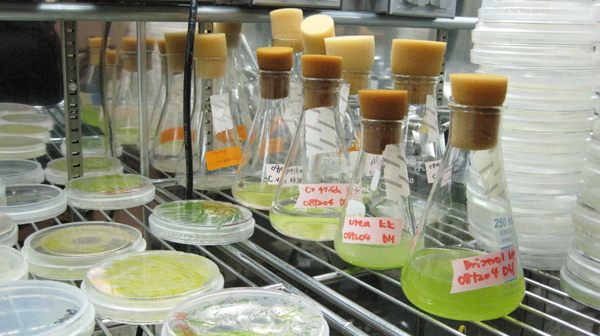
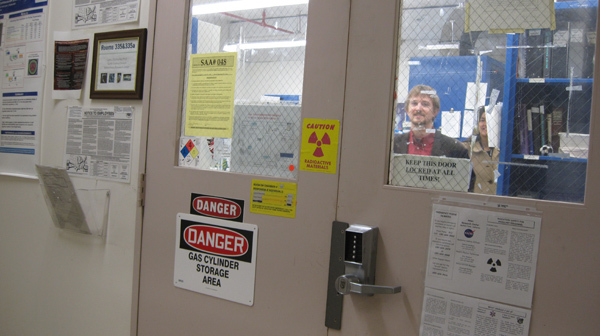
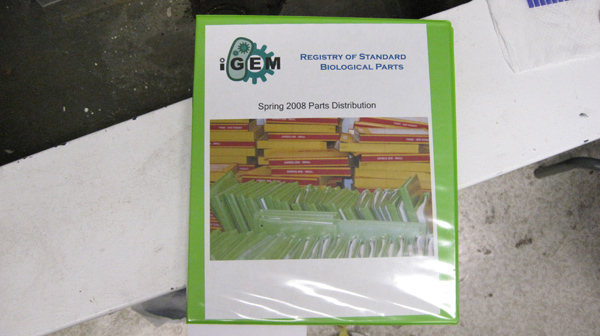
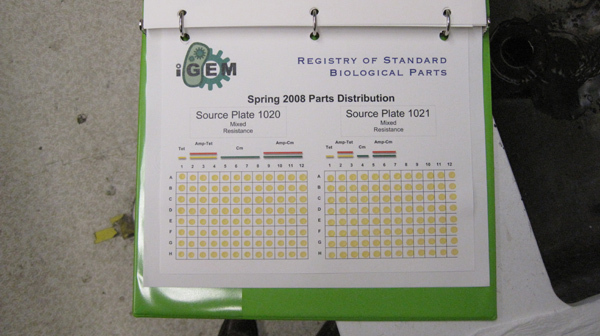
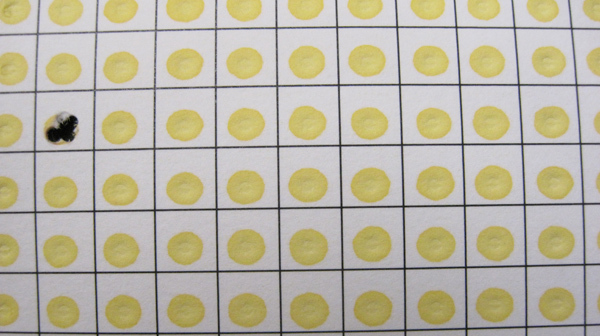
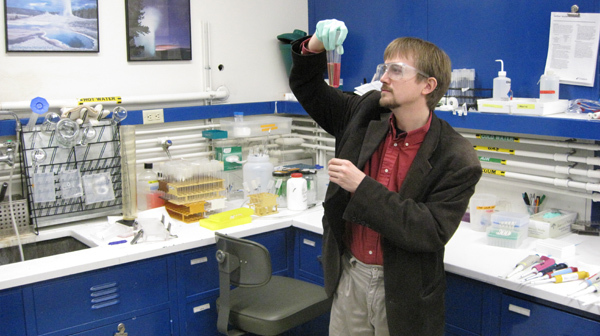

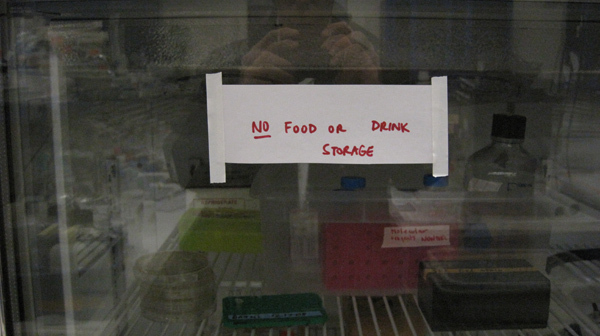
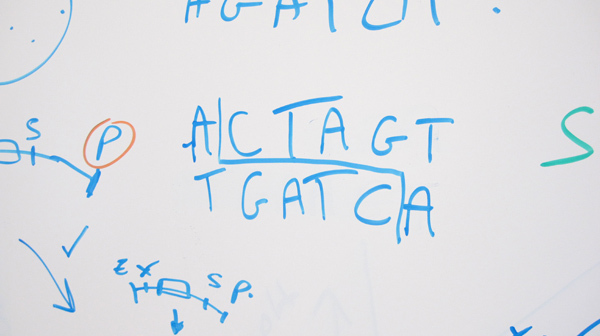
The Future of Human Spaceflight
Posted on Sunday, December 28, 2008
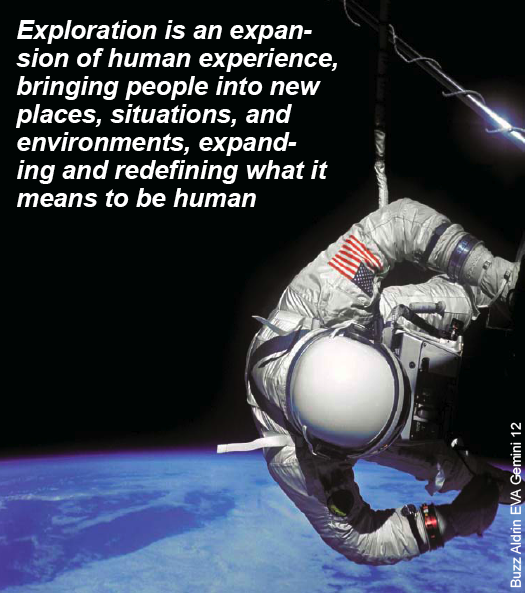
Screendump from report
The title of a white paper recently issued by the 'Space, Policy, and Society Research Group' based at MIT. Some quotes from this (worth reading) 15-page report:
This report addresses the future of human spaceflight, that is physically placing humans in space and on other planetary bodies.
A primary objective of human spaceflight has been, and should be, exploration. Exploration, of course, is a keyword in the Bush vision and in NASA’s own terminology. Yet while the word is often used, it is rarely specified beyond lofty rhetoric and allusions to curiosity and frontiers. What is exploration, and why explore?
First, it is worth considering what exploration is not. Some argue that “exploration is in our DNA,” that some fundamental, even genetic, human trait compels us as individuals and as nations to seek out new territory. The civilization that fails to expand geographically, the argument goes, will enter a state of permanent decline, always to be exceeded by other nations with more compelling wanderlust. We reject these arguments about essential qualities of human nature. No historical evidence, no social science evidence, and no genetic evidence prove that human beings have an innate, universal compulsion to explore. In fact, space exploration is radically different from the kinds of geographical expansion that have marked human history because of its high degree of technical difficulty, the environments’ extreme hostility to human life, and the total lack of encounters with other human cultures.
We define exploration as an expansion of the realm of human experience, bringing people into new places, situations, and environments, expanding and redefining what it means to be human.
Space continues to attract broad public interest, although it must compete for attention in an increasingly diverse, overheated, and unstable media environment. Young Americans increasingly see remote and virtual presence as equivalent to physical presence and may not accept older arguments about the importance of “being there.” Exploration in other realms, notably the deep ocean, faces a similar set of questions as engineers, scientists, and policy makers debate the appropriate mix of human and remote presence in our digital world.
GLXP Mystery Team Reveals Itself at NASA Ames
Posted on Wednesday, December 17, 2008
Earlier this morning, the GLXP Mystery Team revealed its identity here at the NASA Ames Research Center. From top to bottom its Gary Martin (Director of NASA Ames' New Ventures and Communications Directorate [aka Code V]), Will Pomerantz (X PRIZE Senior Director of Space Projects), MSI president John Roth Michael Joyce (Leading the now-not-a-mystery-team-anymore-but-called-Next-Giant-Leap team), and one of my favorite NASA astronauts Jeffrey Hoffman. More on the unveiling at CNET and more on the team's partners at the NGL website.
Web Meets Out-Of-This-World
Posted on Thursday, December 4, 2008
2 days ago I watched another two 30min. videos from last month's Web2.0 Summit 'Web Meets World'. One an interview with Al Gore, the other one an interview with Michael Pollan. Given this year's theme 'Web Meets World', both interviews revolved around discussions on how best practices and business models from the web and software world could be applied to re-invent and/or re-invigorate other industries 'in the real world': the outdated energy industry in Al's talk, the dysfunctional food industry in Michael's talk.
Reading a book on the Django Web Application Framework last night, I realised this question just as much applies to the space industry. Its something I remember Pete Worden (our current NASA Ames Center Director) being pretty vocal about back in 2006. Teaching at the ISU Summer Session in Strasbourg, he made a strong case for the need for standards to facilitate innovation in the space industry. Standards for the data coming back from space, standards for the telecommunication protocols used in space, standards in launch and operational systems. And since he's been here at NASA Ames, he spearheaded an initiative to implement that kind of modular thinking in the actual physical design of a spacecraft, the Modular Common Spacecraft Bus (image above). Its an ubergizmo-worthy system design that can be used both for orbiter missions as well as for lander missions and that was recently selected by Odyssey Moon as their preferred platform to take a shot at the Google Lunar X-Prize.
I can see down the road a satellite gathering data somewhere in the Solar System is conceptually not that different from say a network of smartphones tied into a sensor network, or a webcam streaming images live on the web. Read for example what the Google Lunar X prize has in its competition guidelines in order to win the Grand Prize:
MOONCAST: The Mooncast consists of digital data that must be collected and transmitted to the Earth composed of the following:
High resolution 360º panoramic photographs taken on the surface of the Moon;
Self portraits of the rover taken on the surface of the Moon;
Near-real time videos showing the craft’s journey along the lunar surface;
High Definition (HD) video;
Transmission of a cached set of data, loaded on the craft before launch (e.g. first email from the Moon).
Teams will be required to send a Mooncast detailing their arrival on the lunar surface, and a second Mooncast that provides imagery and video of their journey roaming the lunar surface. All told, the Mooncasts will represent approximately a Gigabyte of stunning content returned to the Earth.
In the end, its all the same. Input devices (in this case: satellites) feed into the web, the web as platform extracts (collective) intelligence out of this data (if you're lucky), the network delivers the data/media to its users/consumers, and voila: Web Meets Out-Of-This-World. Its already happening (yes, it is). Or as one of my favorite quotes from William Gibson goes:
The Future is here, its just not evenly distributed yet.
A Google For Government
Posted on Friday, November 14, 2008
A Google for Government? Ha! Why not a Google for Galaxy?
First Images of the Earth from Chyandrayaan-1
Posted on Monday, November 3, 2008
And quite exquisite ones as well (see earlier post). Click the images for full res. More from the Indian Space Research Organisation (ISRO) at this Press Release from last friday 31st October 2008. More on Chyandrayaan-1 at its own website. (all links via)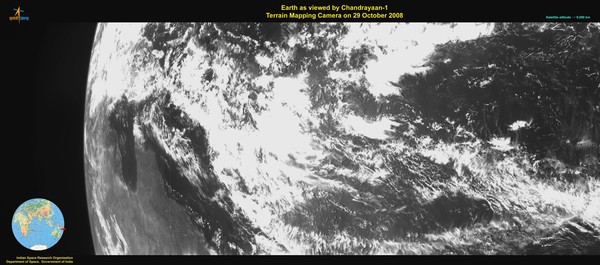
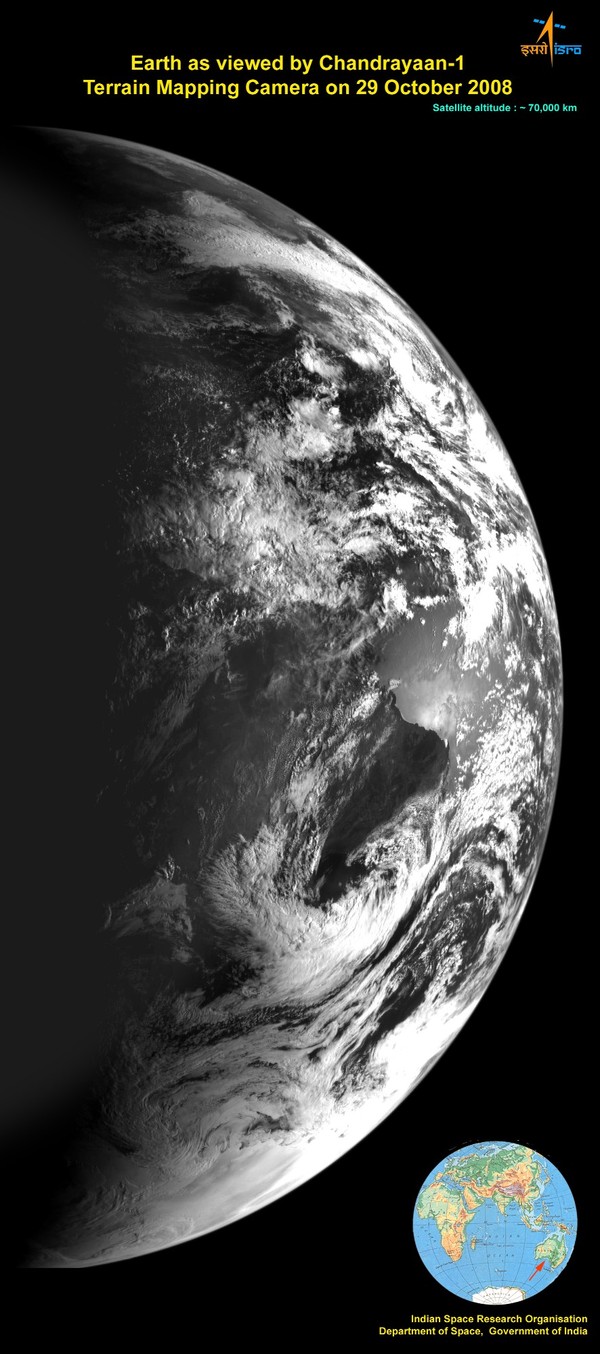
India On Its Way To The Moon
Posted on Tuesday, October 21, 2008
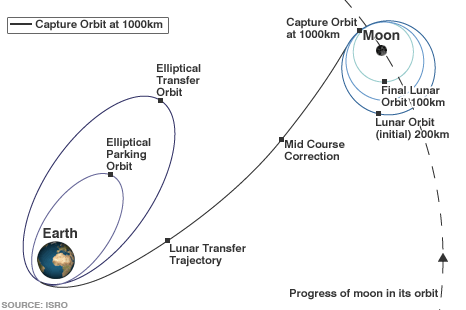
Will be curious to see when the first images from the spacecraft start appearing in cyberspace. I read here that they only switch the cameras on once they arrive in Lunar orbit...seems such a waste to have these valuable 'eyes in space' in hybernation mode while going from the Earth to the Moon. More at BBC.
International Committee on the 'Cultural Utilisation of Space' Launched
Posted on Friday, October 17, 2008
Reblogging Arts Catalyst:
The new IAF (International Astronautical Federation) Technical Activities Committee for the Cultural Utilisation of Space (ITACCUS) was announced during the Less Remote symposium. ITACCUS has been set up to promote and facilitate the innovative utilisation of space by the cultural sectors of society internationally. The term 'utilisation' is used often by the space community. In a cultural context, it may include cultural production, cultural preservation, cultural representation, cultural education and cultural development.The launch speakers were ITACCUS co-chairs Roger Malina, Director, L'Observatoire Astronomique Marseille, and Nicola Triscott, Director of The Arts Catalyst, and committee members Ciro Arevelo, Chairman of the United Nations Commitee on the Peaceful Uses of Outer Space, who welcomed the ITACCUS initiative for the contribution that the cultural sector could make to space and society's engagement with it, Mario Hernandez from UNESCO, who explained the work of UNESCO in using space surveillance systems to monitor world heritage sites, Bernard Foing from the European Space Agency and Spanish astronaut Pedro Duque.
ITACCUS will report on its activities online, and will submit a report annually on cultural utilisation of space to the UN Committee on the Peaceful Uses of Outer Space. It is developing a webspace, which will be linked from its page on the IAF website at www.iafastro.com.
Building The Interface To the Planetary Sensor Web
Posted on Thursday, October 16, 2008
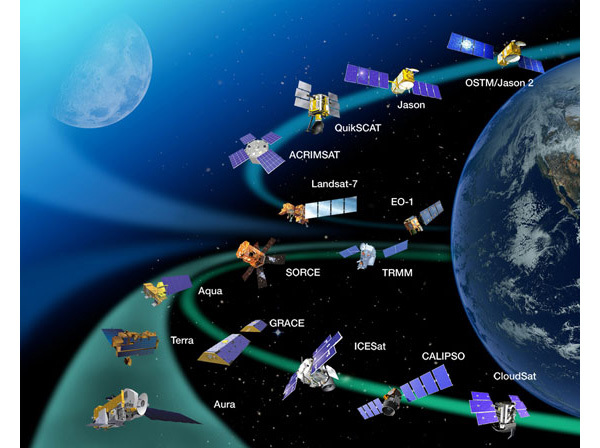
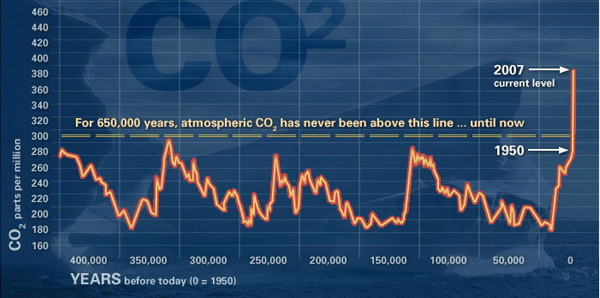
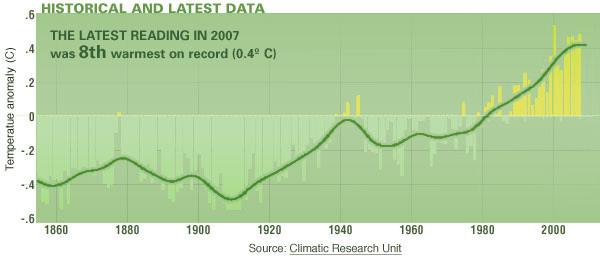
JPL launched it newly designed website today, including a dedicated site on global climate change with the telling subtitle 'NASA's Eyes on the Earth' (CNN has more). In these times of endless stock exchange graphs, stats and scares, its great to see a similar data vis design pattern emerge with the early steps towards a planetary sensor web user interface (if only we could swap the trend in above graphs with the NYSE). Sofar it seems satellite data is not really fed real-time (at least not in an all encompassing & comprehensive way) but I'm sure we'll get there, including open API's for everyone to leverage the sea of space based sensor data about the state of our planet (and beyond). On a related note, O'Reilly just released a Radar report on Where2.0 with a great introduction by Tim O'Reilly.
Fly Me To The Moon
Posted on Sunday, October 12, 2008
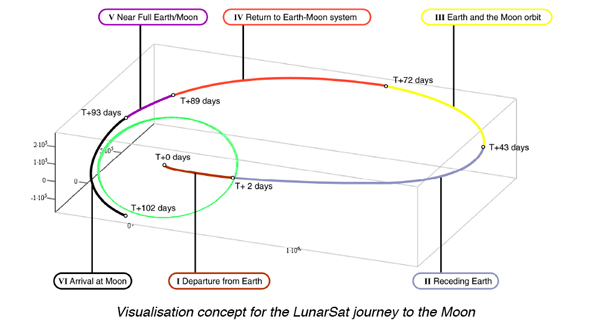
Just finished reading a great book written by Edward Belbruno on his design of advanced trajectories called "Weak Stability Boundary Trajectories". Trajectories that helped save several spacecraft stuck in Low Earth Orbit, like the Japanese Hiten spacecraft. He gives a beautiful description of how a theoretical mathematician enters the space industry (at JPL) and comes up with a highly innovative way to think about trajectory design and gravitational fields. Basically, it comes down to using the gravitational fields of the Earth and Moon to have a "ballistic capture" into Lunar orbit. One of the metaphors he uses is the wave surfer. Be too slow, and the wave passes you by. Be too fast, and the wave won't catch up with you. In Belbruno's case, he is talking about gravitational attraction (not exactly waves [at least, not it his case], but the metaphor still works to explain the idea). Brings back memories of 10 years ago when I was working as part of my thesis on a mission that was planned to take one of these fuel-efficient trajectories to the Moon (image above was my script to use onboard cameras to film the Earth during the 90-day Lunar transfer based on trajectory design by Robin Biesbroek, the green circle is the moon's orbit around the Earth). Beautiful to read how innovation in space exploration happens. And he even manages to bring Vincent van Gogh's Starry Night into his conceptual framework (podcast with Belbruno at The Edge).
Nova Spivack Talks about Role of Media in Future Global Brain
Posted on Friday, October 10, 2008
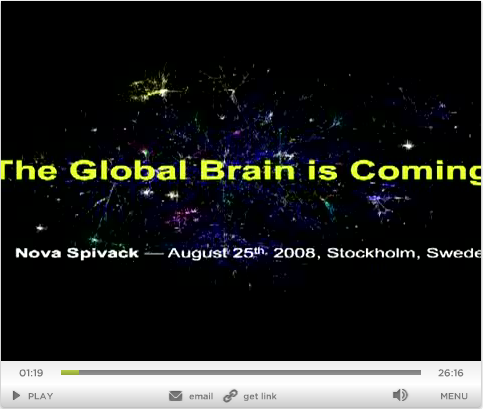
In reference to my previous post, this is what I call an INSPIRING start of a 3-day weekend ;-). Nova basically calls it my favorite talk out of all the talks I have given (more videos from GRID08). I hope whoever gets to decide on where to spend the money for SEC. 407 408 of the NASA Authorization Act 2008 takes the time to listen to his insights:
SEC. 407. PARTICIPATORY EXPLORATION.(a) In General- The Administrator shall develop a technology plan to enable dissemination of information to the public to allow the public to experience missions to the Moon, Mars, or other bodies within our solar system by leveraging advanced exploration technologies. The plan shall identify opportunities to leverage technologies in NASA's Constellation systems that deliver a rich, multi-media experience to the public, and that facilitate participation by the public, the private sector, and international partners. Technologies for collecting high-definition video, 3-dimensional images, and scientific data, along with the means to rapidly deliver this content through extended high bandwidth communications networks shall be considered as part of this plan. It shall include a review of high bandwidth radio and laser communications, high-definition video, stereo imagery, 3-dimensional scene cameras, and Internet routers in space, from orbit, and on the lunar surface. The plan shall also consider secondary cargo capability for technology validation and science mission opportunities. In addition, the plan shall identify opportunities to develop and demonstrate these technologies on the International Space Station and robotic missions to the Moon.
(b) Report- Not later than 270 days after the date of enactment of this Act, the Administrator shall submit the plan to the Committee on Science and Technology of the House of Representatives and the Committee on Commerce, Science, and Transportation of the Senate.
Software, The Final Endless Frontier
Posted on Tuesday, October 7, 2008
From a post by Vint Cerf in the series on Google's 10th anniversary:
A box of washing machine soap will become part of a service as Internet-enabled washing machines are managed by Web-based services that can configure and activate your washing machine. Scientific measurements and experimental results will be blogged and automatically entered into common data archives to facilitate the distribution, sharing and reproduction of experimental results. One might even imagine that scientific instruments could generate their own data blogs.I wonder when small sats finally turn into soap boxes. Vint continues:
These are but a few examples of the way in which the Internet will continue to surround and serve us in the future. The flexibility we have seen in the Internet is a consequence of one simple observation: the Internet is essentially a software artifact. As we have learned in the past several decades, software is an endless frontier. There is no limit to what can be programmed. If we can imagine it, there's a good chance it can be programmed. The Internet of the future will be suffused with software, information, data archives, and populated with devices, appliances, and people who are interacting with and through this rich fabric.Read the whole post here.
Artists get involved in defining the Aims and Missions of a Space Agency
Posted on Wednesday, October 1, 2008
The IAC is on this week. Too bad I am missing it. Would they possibly think of recording the sessions and putting them online like Techcrunch did with their Techcrunch50?. There's good stuff happening, like the side conference Less Remote, which includes discussions on Cultural Utilisation of Space as blogged by Nicola Triscott at the Arts Catalyst blog:
Yesterday evening, we had some excellent examples presented of 'cultural utilisation' of space, notably Marko Peljhan reported on the development of the Slovenian Space Agency, with artists contributing directly to the formulation of its aims and missions.This morning, we have had cracking presentations from Andrew Stones, Iain Bolton, Frank Pietronigro and Hans-Arthur Marsiske. Artist Andrew Stones challenged any notion of ‘objectivity’ in deciding space priorities and reflected on how space is influenced by the cultural imaginary and by dominant and privileged interests. Iain Bolton examined the influence of political culture in the area of national space policy, particularly in the US which differs from the space policies of other nations because of its explicit goal of remaining ‘the leader’ in space exploration. Frank Pietronigro joined us by video link from San Francisco to propose the potential contribution of queer culture to the evolution of future space exploration. Hans-Arthur Marsiske reflected on the darker aspects of the legacy of Christopher Columbus (after whom the new ESA ISS laboratory is named) and what this might imply for future encounters with alien cultures.
Hello World
Posted on Tuesday, September 30, 2008
I kinda missed the excitement of the Chinese EVA the other day (NYT).
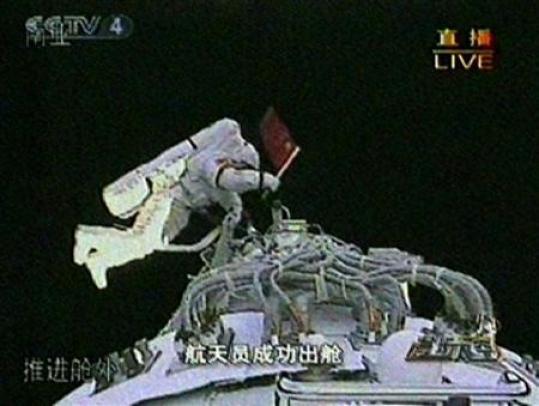

(via & via)
Up or Down?
Posted on Tuesday, September 30, 2008
Update: this video of the breakup is just in @ ESA. It was made by colleagues here at NASA Ames who flew out to Tahiti to record the breakup. To bad the ESA blog doesn't allow for embedding...
While ATV re-enters the atmosphere, SpaceX succesfully launches Falcon-1 into Earth orbit. Impressive feat for a commercial space company. Actually a first in history from what I understand.
Google's TechTalks Inspire NASA Ames
Posted on Sunday, September 28, 2008
Chris McKay (Planetary Scientist @ NASA Ames), Khalid Al Ali (Director of Research at Carnegie Mellon University (CMU) West), and Michael Sims (Research Scientist @ NASA Ames) came together in the NASA Ames Exploration Center last wednesday to talk about the latest developments in robotic surface exploration. Fascinating talk and photos. From what I hear, an audio(?) recording is forthcoming. I hope we get to see more of these talks down the road (and hopefully also the videos integral on the web, in the same spirit as the above mentioned TechTalks).
Space Agencies and Golf Courses (today's pitstop #4)
Posted on Friday, September 26, 2008
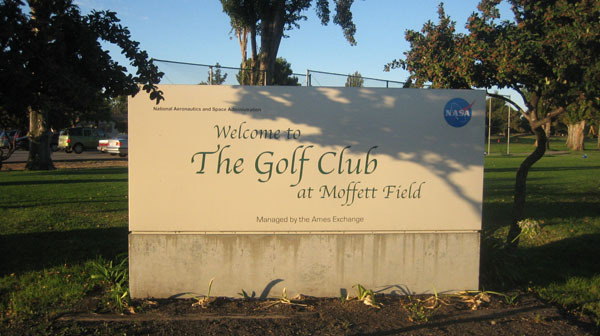
There's something about space agencies and golf courses. Haven't quite figured it out but might have something to do with the average age of the workforce ;-) Its surprising to see how similar in setup the golf courses at ESA/ESTEC and NASA Ames are. Both have a bar, both are a favorite after hours hangout (at Ames, happy hour at the t-1 is on thursdays), both seem to have a core group of regulars (and both are behind the security gate). At ESA/ESTEC, the bar and golf course are better embedded inside the center layout though, making it a more easily accessible place whereas at Ames, you have to drive all around the airfield to get to the bar. Below are the maps of the centers and their golfcourses.
View Larger Map
View Larger Map
10 Bucks Well Spend
Posted on Wednesday, September 24, 2008
Following on from yesterday's syndication of Tim O'Reilly's keynote at the NY Web2.0, I just finished watching the documentary he has been pointing out on several of his keynotes: A Crude Awakening: The Oil Crash. Buy it on itunes from their website and have a peak into the future of post cheap oil society. Quite informative...
Tim O'Reilly's Call to Action
Posted on Tuesday, September 23, 2008
And it ain't throwing sheeps. From last week's Web 2.0 Expo in New York entitled "Web Meets World".
(via)
Yahoo Hackday 2008 (today's pitstop #3)
Posted on Saturday, September 13, 2008
My First Yahoo Hackday. Not much hacking myself, mainly getting a glimpse of Yahoo hackculture at this stage, but Ames was well represented by NASA's Planetary Content hackers Matt Hancher (left) and collegue.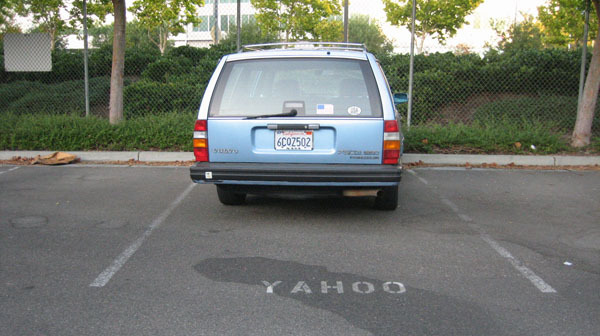
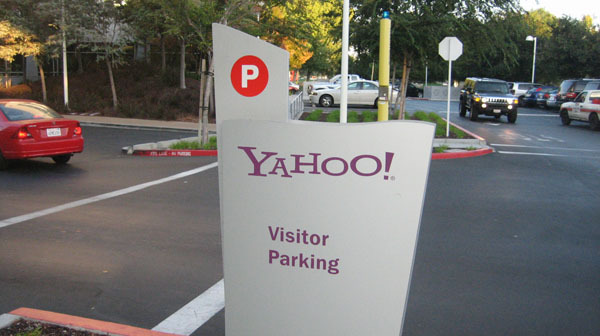
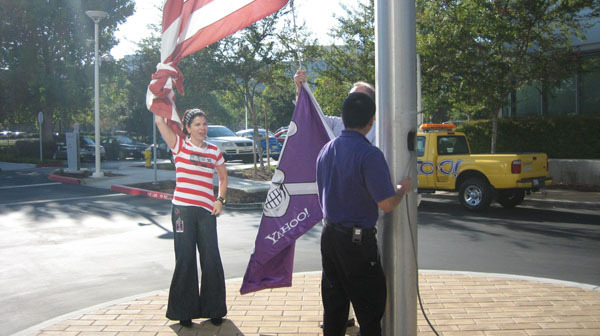

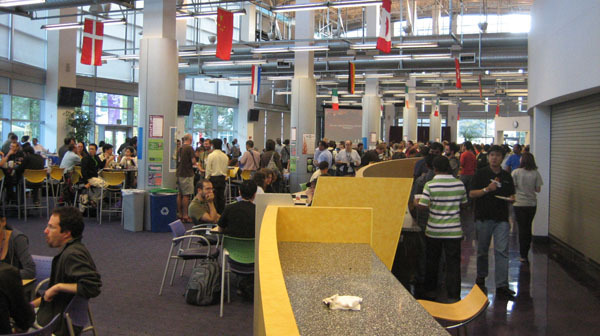
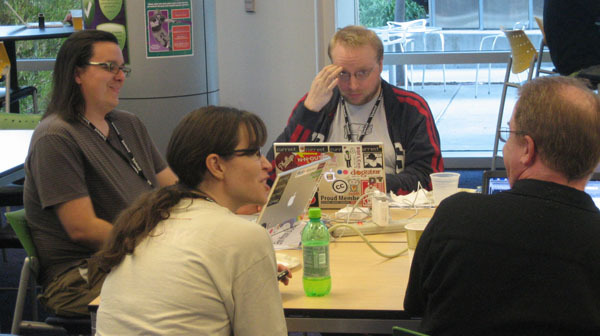
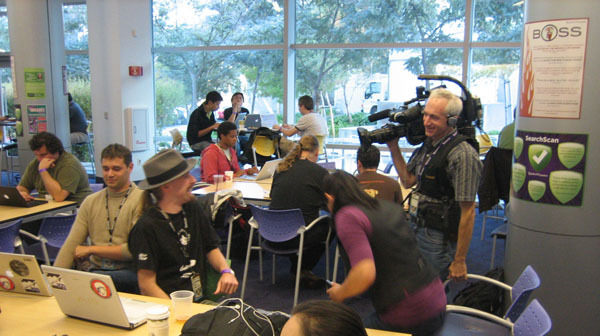
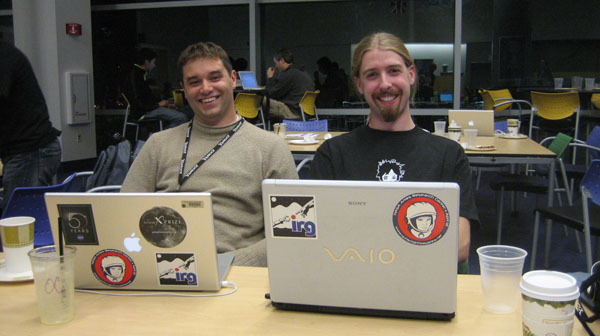
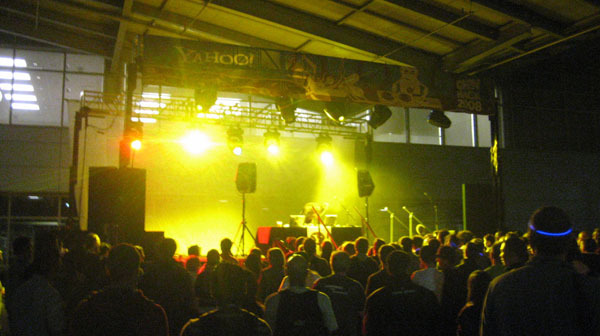
tobedetermined.org Extended Credo
Posted on Monday, September 1, 2008
Update: A post over at O'Reilly Radar by Nat Torkington reminds me of another quote I've used in the earlier days of this blog. It's a (famous) quote from William Gibson: The future is here, its just not evenly distributed yet. In his post, Nat refers to another quote from Gibson that brings the overarching point home:
One of the things our grandchildren will find quaintest about us is that we distinguish the digital from the real, the virtual from the real. In the future, that will become literally impossible. The distinction between cyberspace and that which isn't cyberspace is going to be unimaginable. When I wrote Neuromancer in 1984, cyberspace already existed for some people, but they didn't spend all their time there. So cyberspace was there, and we were here. Now cyberspace is here for a lot of us, and there has become any state of relative nonconnectivity. There is where they don't have Wi-Fi.
Having a 3-day weekend does have its benefits (like in: having an extra evening behind your computer?). Think I just stumbled upon something like an extended credo for this blog (beyond tobedetermined.org: A blog about outer space, cyberspace, their common future and all that is leading up to it... ). I started gathering some quotes that resonated with me over the years and ended up with this list (read from top to bottom, in that order):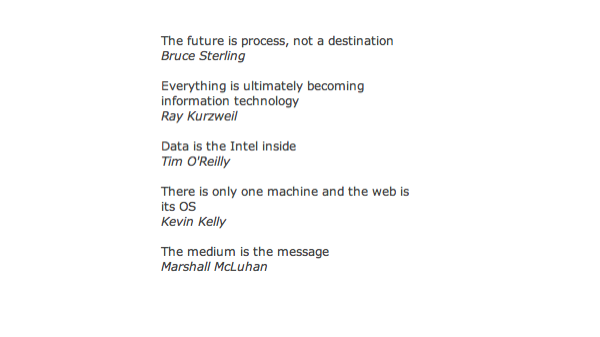
I am sure there are more out there that would fit this list, so if you have any suggestions pls let me know.
ESA runs a webcam...around Mars
Posted on Sunday, August 31, 2008
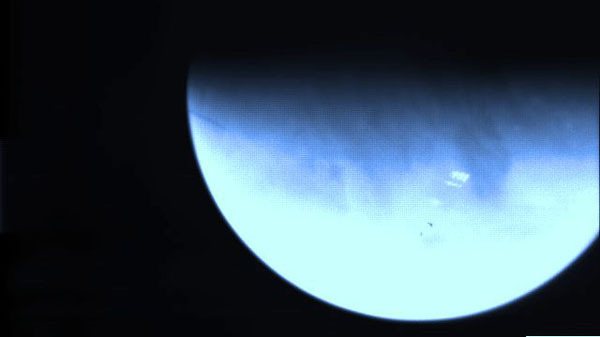
And they invite the public to participate in processing the images. See for more @ ESA's VMC website. Nice job by VMC team coordinator Thomas Ormston, Mars Express Spacecraft Operations Engineer.
Trading Routes 2.0
Posted on Thursday, August 28, 2008
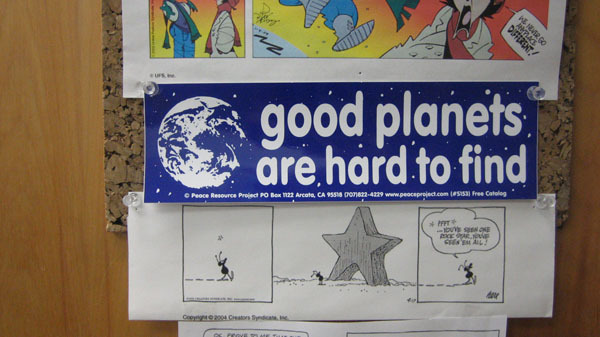
Haven't been very active with blogging recently. Partially this is due to my other backchannel recently opened on twitter where I every now and then post URLs I would otherwise probably post here (even more are at my del.icio.us or my FriendFeed). Anyway, life at NASA Ames continues at an ever speeding pace, moving ahead with our mission to properly weave space into the fabric of our digital "global brain". One link that stayed with me over the weekend is this GigaOM article talking about how new cables carrying internet traffic are indicators of future economic activity (how is that for a comparison to the stale 'Columbus' metaphor to space exploration):
This leads me to my conclusion: Building new cables is the equivalent to adding new roads, new shipping lanes, or flights. The undersea fibers of today are what sea trading routes were in the past—an indicator of future economic activity and a subsequent boom.
Welcome, Interplanetary Internet. Oh, and the image above? Well, there is a planet-finding mission called Kepler of which the Science Operations Center will be based here at Ames. This was on the door of their Deputy Principal Investigator David Koch.
The Economist on Space
Posted on Thursday, August 21, 2008
Since reading the excellent 'Nasa at 50' in the Economist earlier this summer, I am considering them a valuable voice in the (online) space debate, so I am glad to see 3 new space articles in the 21st August edition (via):
On Rocks and Clouds
Posted on Thursday, August 21, 2008
Auw! Everything that can go wrong, will go wrong...
Posted on Wednesday, August 20, 2008
But hey, that's what tests are for. Glad to see NASA releases this stuff, although it does take some convincing from certain individuals.
A shuttle Delta-2 launch from 30000 feet
Posted on Thursday, August 14, 2008
(via)
Correction:
"This is the launch of a Delta 2, most likely GPS 2R-18 on December 20th. The YouTube original was posted "seven months ago" according to the tag. You can see the first set of SRBs burn out and the other ignite at 55 seconds into the video." from nasawatch(thanks Jur)
Chris Kemp kicked of Code I (IT Directorate) here at Ames. This is going to be good!
Posted on Wednesday, August 13, 2008
In other news:
- A good interview with Jeff Stibel on the 'perceived' parallels between the Internet and the brain
- Cyber attacks preceeded bombs in Georgia. Which makes me want to go back to a commercial I saw one of the first weeks I arrived in the US: Airforce: Air : Space : Cyberspace. This completely brings home the topic of this blog. Moving up from Air into Space and beyond, you enter...Cyberspace. If you want a challenge: be a cyber warrior.
- Google Maps didn't have any info on Georgia (I noticed that myself as well, and wondered what was up). Now Google is saying they just didn't have data there.
- Is Google a media company? Many seem to think so, including Tom Foremski:
For the past four years I've been saying that Google, Yahoo and many other large Internet companies such as AOL, and eBay are media companies. They publish pages of content with advertising around it.The fact of owning or not owning the content is a red herring. Either way, Google publishes pages of content with advertising around it. How is that not a media company?
GOOG is not a technology company. What technology can you buy from Google? I can buy a database from Oracle--that's a technology company. I can buy microprocessors from Intel--that's a technology company. What technology can you buy from Google?
Google is a technology-enabled media company. It won't create its own content. It mostly scrapes its content from the Internet, or collects it from users of Youtube, etc, and sells advertising around it. How it gets its content is not important, it is still a media company.
How to syndicate SOHO's realtime images?
Posted on Monday, August 11, 2008
Redesigning my blog's look & feel, I wonder why I can't embed this realtime stream of SOHO images into my blog? Why is there no readily available embed option like the one below for the Colbert Report? Serious, how difficult would that be to implement? Btw, if you wonder what the CCD bakeout overlay means, this is from their website:
And what about EIT's CCD bakeout?
Over time, many types of CCDs (Charge-Coupled Devices) used to detect EUV radiation are degraded by contamination of heavy ions from cosmic/solar particle radiation (interfering with the doping of the chip), deposits and polymerisation of deposits on the surface and, finally, trapped charges (again interfering with the doping of the substrate). These forms of degradation reduce the sensitivity of the detector. Fortunately, by heating the CCD over an extended time period, some of these effects can be reduced. Heating the CCD to improve its performance is called "baking out" the CCD. Since EIT would be unable to do "business as usual" during keyholes, they schedule their bakeouts during periods when data loss is inevitable.

Buzz Aldrin at the Colbert Report (US Only)
Posted on Monday, August 11, 2008
Summer 2008
Posted on Friday, August 1, 2008
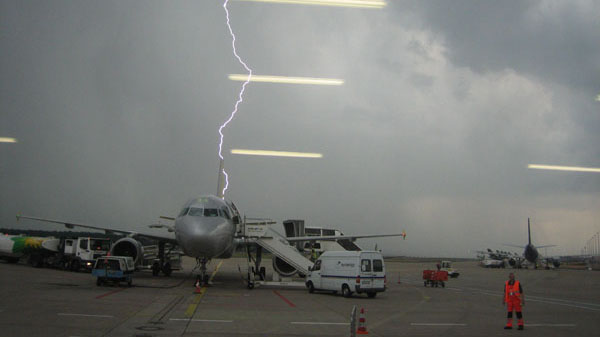
Back from a week of Internetless holiday on the island of Korcula (above photo was at Koln airport just before we were told we could board the plane ;-). Catching up here are a few relevant tidbits:
- The Economist's commentary on NASA's 50th anniversary provides a sharp dissection of NASA's past, present and future. Its the most sensible story on space and NASA I've read in a long while. As always, the comments are worth reading too, if only to see how space proponents bring their arguments into gear to downplay the article's 'hammer on the nail' analysis
- Sanfran article of the week about twitter, relationships, and the bay area working spirit
- Missed OSCON, but here's a 37min intro and Tim Oreilly's comments
- A great discovery: this TED video by kevin kelly. I especially like his McLuhan Reversal analogy. Have to watch it again.
S3 Outage Effects
Posted on Tuesday, July 22, 2008
Interesting. S3 goes out, and suddenly all over the web you'll see images disappearing, avatars evaporating and webshops go down.
Btw,for those who have the time to follow twitter feeds, and/or(?) are interested how we are gonna re-vamp NASA Ames' presence on the web (starting with the Ames page in the nasa.gov portal) we just added a new fly on the wall.
Twittering from LSI conference
Posted on Monday, July 21, 2008
Just got into the LSI Moon conference here at Ames. Follow my twitter on it here. Alternatively you can see what Keith Cowing is up to here. Or check out the program here. More as it comes in...
The Stone Age Didn't End Because of a Shortage of Stones
Posted on Sunday, July 20, 2008
Bruce Sterling comments inline on this passionate call by Al Gore for the US to become carbon fuel independent in 10 years.
Time to put some solar panels on my roof here in Palo Alto. Or wait, wasn't I first gonna spend 2 weeks flying around Europe for my holiday, buy the iPhone and upgrade my car (from what I hear SUV's come cheap these days).
Could this be the "Moonrace" of the 21st century?
We need you. And we need you now. We're committed to changing not just light bulbs, but laws. And laws will only change with leadership. On July 16, 1969, the United States of America was finally ready to meet President Kennedy's challenge of landing Americans on the moon. I will never forget standing beside my father a few miles from the launch site, waiting for the giant Saturn 5 rocket to lift Apollo 11 into the sky. I was a young man, 21 years old, who had graduated from college a month before and was enlisting in the United States Army three weeks later.I will never forget the inspiration of those minutes. The power and the vibration of the giant rocket's engines shook my entire body. As I watched the rocket rise, slowly at first and then with great speed, the sound was deafening. We craned our necks to follow its path until we were looking straight up into the air. And then four days later, I watched along with hundreds of millions of others around the world as Neil Armstrong took one small step to the surface of the moon and changed the history of the human race.
We must now lift our nation to reach another goal that will change history. Our entire civilization depends upon us now embarking on a new journey of exploration and discovery. Our success depends on our willingness as a people to undertake this journey and to complete it within 10 years. Once again, we have an opportunity to take a giant leap for humankind.
Yup
Posted on Thursday, July 17, 2008
Wading through +2k unread posts in my list of RSS feeds (Bruce Sterling's Beyond the Beyond).
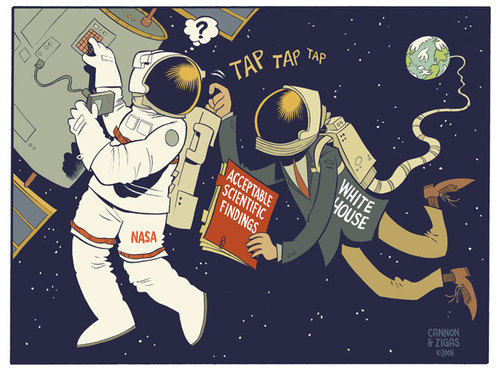
Edward Tufte on iPhone
Posted on Monday, July 14, 2008
From the NYT:
“The content is the interface, the information is the interface, not the computer administration debris,” he said in a video critique of the iPhone.Now that's a statement that resonates, considering the amount of (useless) interface on this page.
Its You They're After
Posted on Saturday, July 12, 2008
The best analysis on Google's Lively I've read sofar comes from RealityPrime: Its not so much about giving people a nice virtual world to play with, its providing a new interface to harvest new and previously untapped user behaviour. Which reminds me of an excellent article I was send the other day on the near future of advertising, a must-read.
Yes, But Is It Art?
Posted on Saturday, July 12, 2008
Or Space Aaaarrrrttt, as a Dutch Space Agency collegue would call it back in the days... (personally I wouldn't directly associate this with art, but that's another story. Its an excellent video though!)
Super Sprayer - video powered by Metacafe
Robots Get Better Every Day
Posted on Wednesday, July 9, 2008
A couple of quotes from an article in the Washington Post entitled 'U.S. Finds It's Getting Crowded Out There' (via):
The cost of manned space exploration, which requires expensive measures to sustain and protect astronauts in the cold emptiness of space, is a particular target."The manned space program served a purpose during the Apollo times, but it just doesn't anymore," says Robert Parks, a University of Maryland physics professor who writes about NASA and space. The reason: "Human beings haven't changed much in 160,000 years," he said, "but robots get better by the day."
Another one:
In its assessment, Futron listed the most significant U.S. space weakness as "limited public interest in space activity."
Hmm, it looks like us humans are a real show stopper when it comes to pushing the borders of reality further into outer space. Perhaps we should consider targeting robots instead of humans with the US civil space PR machine. Once they are on equal par with us, they'll probably be much more enthused and equipped to go into outer space. And after all, our race already had its 15 minutes of fame wouldn't u say? An add campaign targeted at robots...hmm...: "Space, The Final Webservice"
NASA Celebrates 50 Years of Exploration This Year
Posted on Monday, July 7, 2008
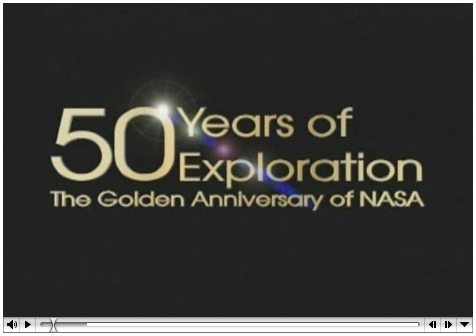
Get started with above video of highlights (btw, where is my embedabble NASA videoplayer?). The official celebration happens around October if I am not mistaken, but according to Wikipedia NASA was established Jul 29th 1958 so we're getting close. Much more on the upcoming celebrations at this NASA 50th Anniversary website.
Sarkozy's Whirlwind Extends Into Outer Space
Posted on Tuesday, July 1, 2008
NASA Ames 20g centrifuge & Mission Design Center
Posted on Thursday, June 26, 2008
It seems we have a thing going at Ames. Every other week or so we organise a tour to one of the many cool locations on base. Just to have a glimpse. The center is packed with labs, test facilities, centrifuges, cool design centers...and on and on and on. Only, hardly the time to go for a scroll around and nock on those doors these days. So, we send out an email and get a group together to get a brief intro. Below are a couple of images (more at Flickr 1 & 2) of some recent visits, one to the 20g centrifuge (which seems to be kinda hidden under the massive low speed windtunnel, thanks Russell!), and one to the Mission Design Center (think CDF, Team X, thanks James!).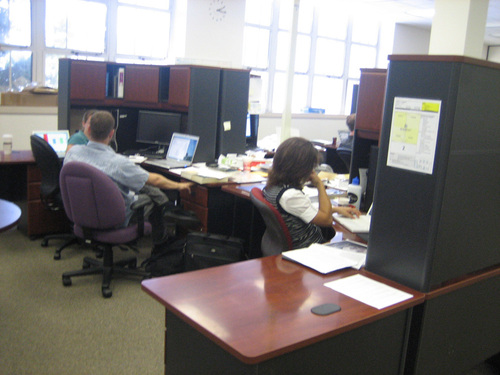
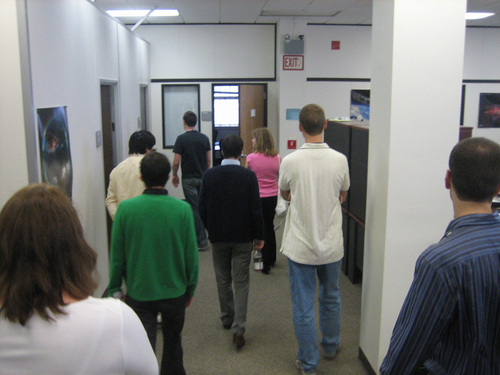
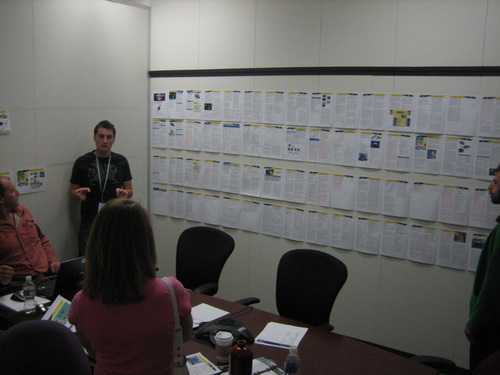
Windy Hill Overlooking the Bay Area
Posted on Thursday, June 26, 2008
![]()
Click to Enlarge
Last weekend I finally found what I was looking for the first few weeks I arrived here: on top of a hill, a place to at the same time overlook the Pacific on one side and the Bay Area on the other (Thanks Deborah!). If you look closely, you can see the City (SF) in the far end of the Peninsula (follow the Bay to the left, the City is just visible before the hills start) and Stanford in front (the tower). At the end of the Bay (to the right), you can see the large windtunnels of NASA Ames. Further to the right is San Jose.
To make things easier, see below for the exact location on Google Maps from where I made the panorama.
And the folks in the image....uhm...they happened to be there as well ;-)
View Larger Map
Martian Skies
Posted on Saturday, June 21, 2008
Nicolar Carr points to a photoblog with a post of great photos from Mars. Worth your precious Internet time I promise.
Excellent article on the Asteroid Underground movement here in the US
Posted on Saturday, June 21, 2008
In the July 2008 issue of the Smithsonian Air & Space Magazine: The Million Mile Mission. (via).
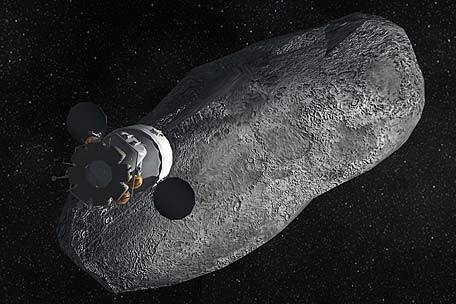
Space Behind the NASA Portal
Posted on Thursday, June 19, 2008
Ever since the re-design, I've been itching to hit the top right corner of my screen to make all of the modules on the NASA Portal go away, providing me with an unobscured look into outer space (yes, its an OSX thing). One of my current activities involves the NASA Portal so diving into the css sheets I finally got a chance to see what I was looking for. I'd still like to see a realtime background image there some day, but from the first looks into the back end CMS on which the Portal is build, this will have to wait a while ;-)
Committee For The Cultural Use of Space
Posted on Monday, June 16, 2008
Well, seems our efforts over the years are paying off in an interesting way. Nicola Triscott recently presented at UNCOPUOS and announced the setup of a new Committee at the International Astronautical Federation: the IAF Technical Activities Committee for the Cultural Utilization of Space (ITACCUS):
The IAF Technical Activities Committee for the Cultural Utilization of Space (ITACCUS) seeks to:
Promote and Facilitate the innovative utilization of space and ground segments of space projects and systems, and space applications systems by Professionals and Organizations in the Cultural Sectors of Society Internationally
WorldWind presentation at the Yahoo Brickhouse (revisited)
Posted on Friday, June 13, 2008
The video of this presentation came online at the Yahoo Developers Network (via).
NASA CIO
Posted on Thursday, June 12, 2008
An audio interview with NASA CIO Jonathan Pettus on web2.0 and NASA's web presence.
As we come to rely on computers to mediate our understanding of the world...
Posted on Wednesday, June 11, 2008
Nicolar Carr looks ahead. Searchblog responds. I definitely like Nicolas' point of view. Whereas the conservatism standpoint never seems to win, he makes a good point about the influential nature of media beyond what they carry (the medium is the message, or first we shape the tools, then the tools shape us). The deep reading he talks about seems on the web more to revolve around 'deep experience'. For example my first encounters with Google Earth definitely carried some element of 'deep experience' that would not have been possible weren't it for the Internet. I'm sure there's more on the way where that came from.
Friday Afternoon Yawns
Posted on Saturday, June 7, 2008
OgleEarth is on the ball with his critique on Walt Disney Park's layer in Google Earth being 'the next best thing to being there'. Reading it, I recognise I am reading my own unexpressed yawn about it (without having had a look at it myself I do admit, but that tells it all I guess). A virtual Disneyland devoid of people, and no possibility to take a ride, WoW!? If only I had some time to go back to the enthusiasm while working on UGO, but for some reason, its not that attractive at the moment. Even with the ability to bring it into the browser, which is pretty cool yes, apart from the techno fetish, there's at the moment not much occasional inspiration to throw time at Google Earth (apart from learning the javascript GE API implementation perhaps). Has anybody heard anything about Second Life lately btw?
On a more enthusiastic note, I attended the Google I/O conference 2 weeks ago here at Moscone West. Now that was exiting! Not so much from a Google Tech or developers point of view (albeit that was pretty inspiring too, mostly diving into the Google App Engine, on which I had my first encounter with the GE browser plugin), but more from a cultural real people point of view. Apparently they brought Google culture over from the Googleplex to the conference center. I lost my camera in the meantime so can't show you my pictures of all the beanbags, free food, and other goodies, but man, that's a sweet company culture (and flickr tags are there to prove it). And a young crowd too.
I recognised the same kind of culture here at Yahoo HQ earlier this week where we were sitting in on a meeting on the upcoming Yahoo Hackday. Working at a place where the coffee corner closes 30 minutes after lunch has been served (that's around 2:00pm folks), and where the cappucino comes out of a prefab instant-make coffee-crap-machine, I am all for Google joining the ranks here on the NASA Ames premises. And I certainly hope some of their culture bleeds over the fence into Ames, which I'm sure it will (not sure if i'll be around to witness it though as they only start building in 2013).
As usual, these high profile Google announcements draw quite a bit of cynical critisism from the likes of Bull's rambles, Valleywag and ZDNet but that's as yawn inspiring as the Disney layer in Google Earth.
My two cents for the weekend: Ask not what Google or Yahoo! can do for you, but what Google/Yahoo! culture can do to your space program.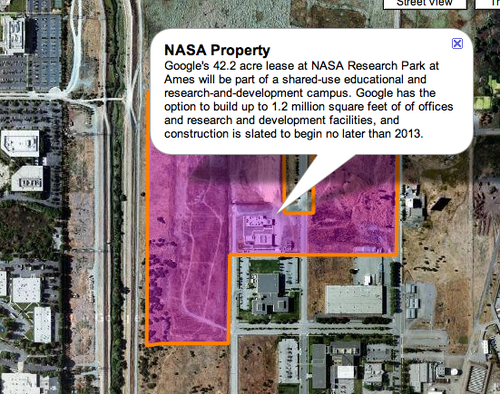
(see it in google maps, or, if you really really want to, in Google Earth)
View Larger Map
Easily The Best Live TV Channel Around
Posted on Thursday, June 5, 2008
Now how do I go about getting an RSS or email message (or better, a live TV player popping up) whenever there is a live EVA going on on NASATV? And what about having the spacewalks made available on-demand? Would I be able to switch cameras myself perhaps? Lots of opportunities to make the NASATV service even better.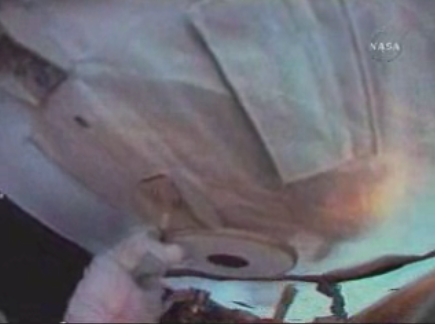
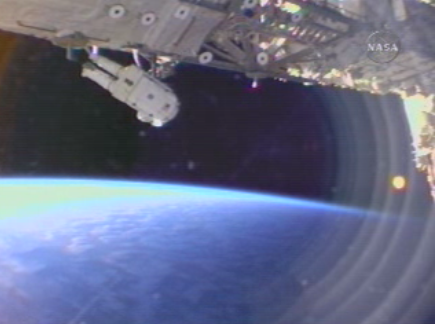
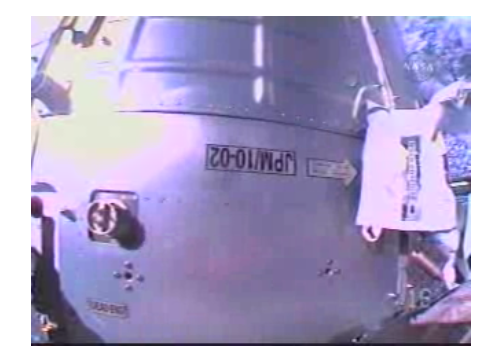
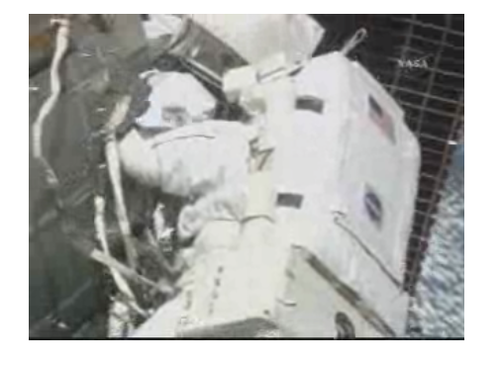
Spacewalk ongoing
Posted on Thursday, June 5, 2008
Excellent background sound and video while working. Especially when mixed in with SomaFM's secret agent channel in iTunes (look for it under radio->electronic). Even better, mix it up with SomaFM's own Space Station Soma channel: Tune in, turn on, space out. Just playing around, I included the NASATV broadcast on this page of mine. U can also get it at NASA.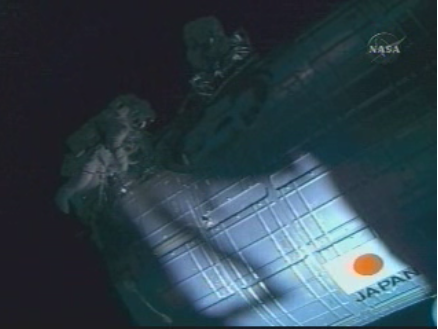
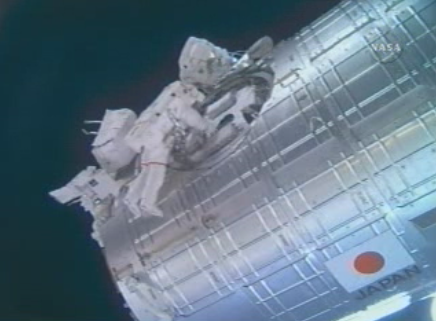
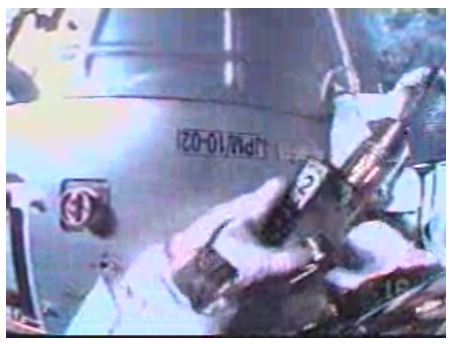
Intergalactic TV
Posted on Wednesday, June 4, 2008
Doing some research on NASATV (wikipedia) I come across a couple of other space agency TV stations, like ESA's (boring not much happening there) and this one from the Russian Space Agency. On the latter, I am welcomed by Mr Ostrovsky, Head of Roscosmos-TV (below). Reminds me of a Dutch show. Too bad they don't have regular TV webstreams ;-).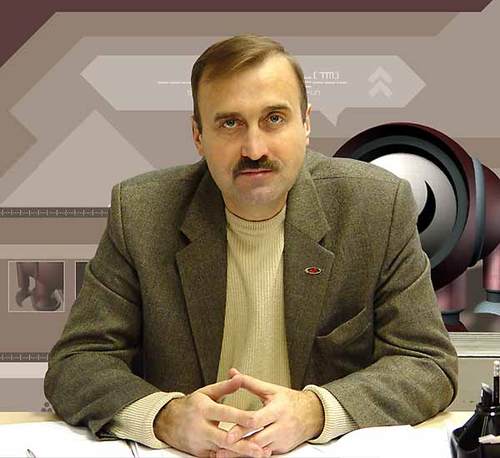
Real or virtual?
Posted on Wednesday, June 4, 2008
Its hard to tell these days if you look at below photos of todays Kibo docking (via).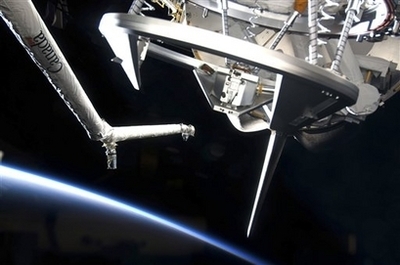
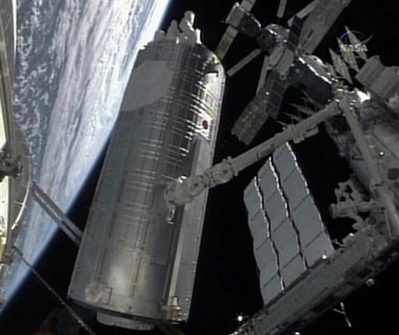
The Awakening
Posted on Tuesday, June 3, 2008
After Phoenix's recent twitter success, satellites are waking up to the opportunity. Its LRO, its LCROSS, its..its...the ISS? The Shuttle? Why not the Shuttle's external tank (it travels a fair bit over land before it gets shot into space), the Deep Space Network antenna's, NASA's Columbia supercomputer ...Hallelujah, let there be light, the sensor web awakens!
(nice job title: for 2 years I was LCROSS twitter. Would like to see some GPS going on at the same time...following all of NASA's hardware around in Google Earth in real time would be kinda neat...)
Phoenix Twitters
Posted on Monday, June 2, 2008
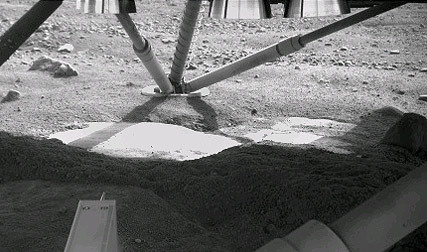
NASA Watch gives us the twitter of all twitters: MarsPhoenix. From an interview in Wired:
...can imagine a future academic writing the clause, "identity creation through character limitation," but the personal touch, even if borne of necessity, caught on with the Twitter community.
Writing from the first person turned out to be mainly a solution to the 140 character limitation on twitter. Nice how evolutionary solutions play into the impersonification of spacecraft.
New (Dutch) Footage From Phoenix Landing
Posted on Wednesday, May 28, 2008
Browsing a New World
Posted on Monday, May 26, 2008
Just before logging off, I am reminded of the resemblance I noticed before between the mission logo of Phoenix and the Firefox logo. Guess it makes sense if you consider the Phoenix lander a physical counterpart to the world's (2nd) most popular web browser. Wonder whether we'll ever get the physical equivalent of greasemonkey scripts on our planetary explorers. Btw, looking for the high-res version of the Phoenix logo, I ran into below image of a mural that was painted on the outer wall of the Phoenix Sci Ops center at the Uni of Arizona. Sweet! (more info here)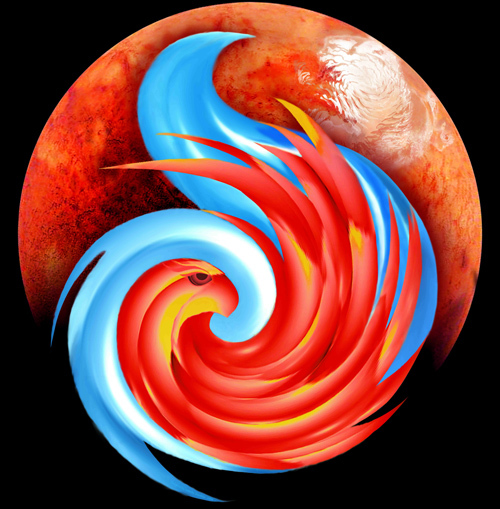

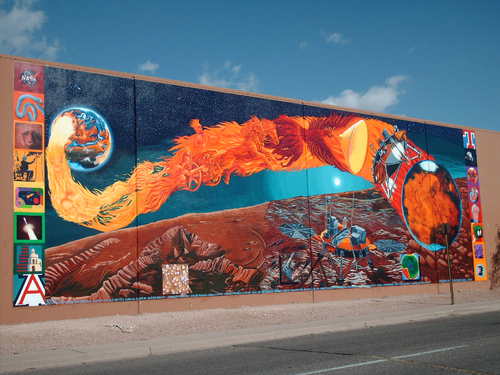
Memorial Weekend On Mars
Posted on Monday, May 26, 2008
Those first images are always the best. Especially those self inspecting views of the spacecraft: where am I? what's my status? Are my solar panels unfold? What's my tilt? how are my feet looking? Would love to see an image of the camera taking an image. Seeing yourself looking out on the desolation of Mars from 680 million km afar. More raw images keep pouring in.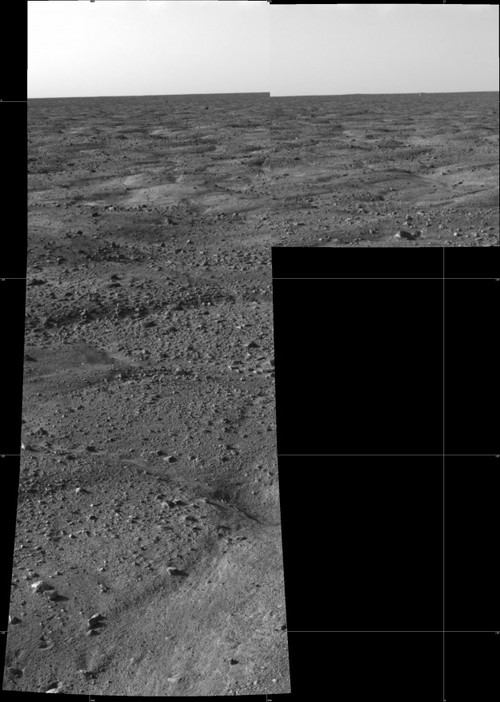
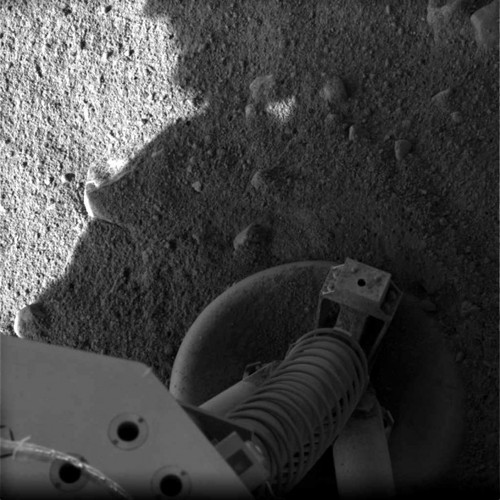
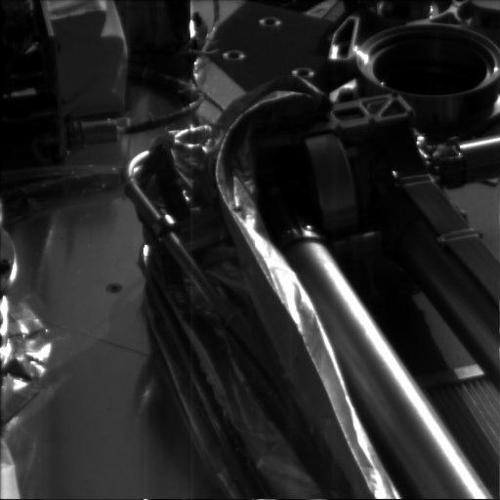
Eat It Jon Stewart I'm Talking To Space
Posted on Monday, May 26, 2008
Phoenix Is Coming To Town
Posted on Saturday, May 24, 2008
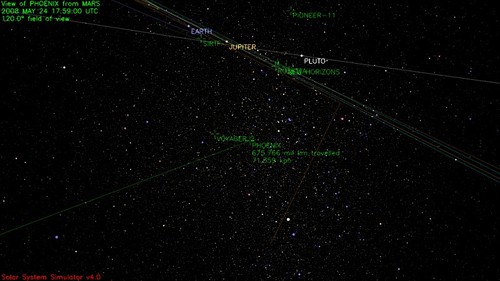
View of Phoenix from Mars (link)
The entire Entry, Descent and Landing sequence takes just about 7 minutes.
Some key times tomorrow, with all times PDT (CET=PDT+9hrs):
3 p.m. (12 a.m) : Begin non-commentary live television feed from JPL
3:30 p.m. (12:30 a.m) : Begin commentated live television feed from JPL
4:40 p.m. (1:40 a.m.) : Spacecraft turns to attitude for atmospheric entry
4:46:33 p.m. (1:46:33 a.m.) : Spacecraft enters atmosphere
4:47 through 4:49 p.m. : Likely blackout period
4:50:15 p.m. (1:50:15 a.m.) : Parachute deploys
4:50:30 p.m. (1:50:30 a.m.) : Heat shield jettisoned
4:50:40 p.m. (1:50:40 a.m.) : Legs deploy
4:51:30 p.m. (1:51:30 a.m.) : Radar activated
4:53:09 p.m. (1:53:09 a.m.) : Lander separates from backshell
4:53:08 to 4:53:14 p.m. : Transmission gap during switch to helix antenna
4:53:12 p.m. (1:53:12 a.m.) : Descent thrusters throttle up
4:53:34 p.m. (1:53:34 a.m.) : Constant-velocity phase starts
4:53:52 p.m. (1:53:52 a.m.) : Touchdown
More on the schedule is available at this inspired NASA page, including the following note:
NOTE: The times below for the Phoenix spacecraft events on May 25 are for a nominal scenario. Remaining navigational adjustments before May 25 could shift the times by up to about half a minute. In addition, the times for some events relative to others could vary by several seconds due to variations in the Martian atmosphere and other factors. For some events, a "give or take" range of times is given, covering 99 percent of possible scenarios from the atmospheric entry time. For events at Mars, times are listed in "Earth-receive time" (ERT) rather than "spacecraft event time" (SCET). This means the listed time incorporates the interval necessary for radio signals traveling at the speed of light to reach Earth from Mars. On landing day, May 25, the two planets are 275 million kilometers apart (171 million miles), which means it takes the signal 15 minutes and 20 seconds to reach Earth. For some spacecraft events, engineers will not receive immediate radio confirmation.
Even more information available at the official websites: NASA's Phoenix page and University of Arizona's Phoenix page.
WorldWind presentation at the Yahoo Brickhouse in SF
Posted on Thursday, May 22, 2008
One of these events which makes me remember why I moved down here from Amsterdam: a presentation on NASA's open source 3d browser at the Yahoo Brickhouse in downtown San Francisco. Great place, great talk, great people. More pictures are at my Flickr. For some reason, I have a hard time finding some more info on the Brickhouse on Yahoo's properties. Weird how they not have a full YBH page up there. Anyway, the video of the talk should become available on the Yahoo Developers Network somewhere next week I was told. I'll update as soon as its up.
Mike Griffin at Googleplex (June 2007)
Posted on Saturday, May 17, 2008
Finally got a chance to see the recording of Mike Griffin's talk at the Googleplex last year. Informative talk. $55 a year per US citizen goes to NASA, out of an average 8k$ yearly tax bill. That's actually more than I'd expected.
World Wide Telescope Released
Posted on Thursday, May 15, 2008
Yep, its here (given the page design you'd mistake it for a Mac site just for a second). Ever since I upgraded to Mac OSX 10.5 (aka Leopard) last week my Parallels XP virtual machine is in a permanent state of reboot so I haven't had a personal interaction with WWT yet, but from the reviews of it over at OgleEarth and The Earth Is Square, it seems to be a pretty nifty application.
Can't wait to get my NASA Macbook Pro exchanged for a proper PC...
The Geoweb Is Evolving
Posted on Wednesday, May 14, 2008
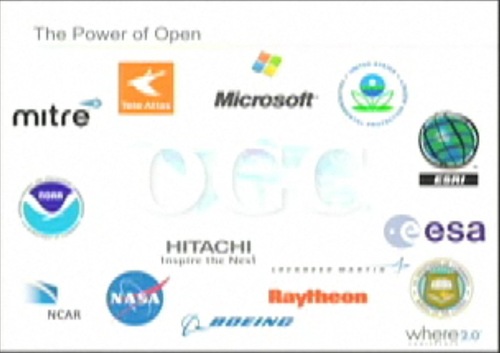
Straight from Burlingame at the Where2.0 conference, John Hanke and Jack Dangermond talk about Google and ESRI working together. Note that there's two space agencies in above image (considering NOAA is not) and a couple of NASA contractors.
Some views to enjoy (until I get back to posting regularly)
Posted on Tuesday, May 6, 2008
What do you want NASA2.0 to be?
Posted on Wednesday, April 23, 2008
I am here in San Francisco at the Web2.0 Expo in Moscone West, just kicking off with the highly informative 'Building Next Generation Web2.0 Applications' workshop by Dion Hinchcliffe (See some of his slides below).
One of the points he made very clear is the value of data. Data is the new Intel inside as Tim O'Reilly so succinctly proclaimed in his seminal 2005 paper on 'What is web2.0'. The web is a platform. For NASA, its a platform for space exploration. Getting web2.0-ified seems not so much a question of how to gather a data class valuable to its users (after all, who doesn't like images like these, or looking through the eyes of our rovers on Mars, as seen from above), or getting everybody to become rocket scientists (although...mmm...;-), but more the other way around: how to leverage its vast data resources (after all, what are satellites other than data gathering devices) to get the public more engaged in NASA's mission and activities. Space is cool, and you know it. Its just too far away from our daily lives on the web. Give me space exploration, right here, right now, and we'll give you our database of space exploration intentions.
Building an open platform on the web where NASA can easily share all the great data it gathers is the anwser. Be there as the images pour in. Be there as the exploration takes place. NASA2.0 is all about getting NASA's data more available, usable and shareble on the web. Where possible in (near) real time please.
Which reminds me of this post over at the Institute Of The Future about post-scientific society. Well worth the read!
American innovators — with their world-class strengths in product design, marketing and finance — may have a historic opportunity to convert the scientific know-how from abroad into market gains and profits. Mr. Hill views the transition to “the postscientific society” as an unrecognized bonus for American creators of new products and services.And they just released today a new initiative called X2 about the future of science and technology.
A post-scientific society will have several key characteristics, the most important of which is that innovation leading to wealth generation and productivity growth will be based principally not on world leadership in fundamental research in the natural sciences and engineering, but on world-leading mastery of the creative powers of, and the basic sciences of, individual human beings, their societies, and their cultures.
Just as the post-industrial society continues to require the products of agriculture and manufacturing for its effective functioning, so too will the post-scientific society continue to require the results of advanced scientific and engineering research. Nevertheless, the leading edge of innovation in the post-scientific society, whether for business, industrial, consumer, or public purposes, will move from the workshop, the laboratory, and the office to the studio, the think tank, the atelier, and cyberspace.
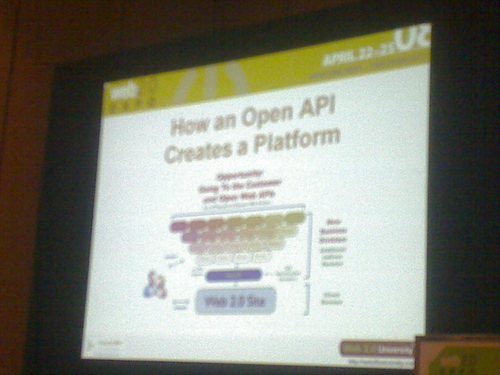
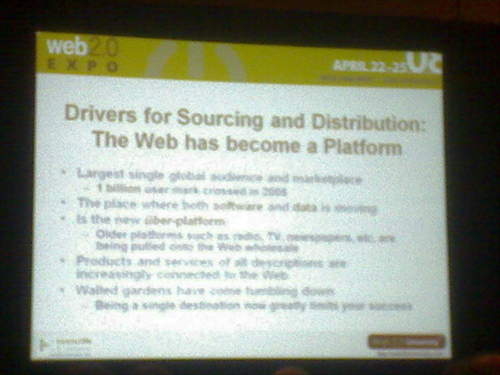
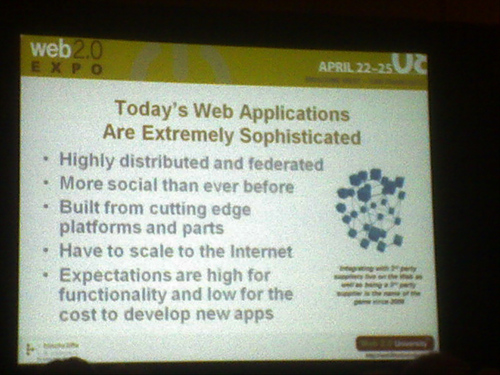
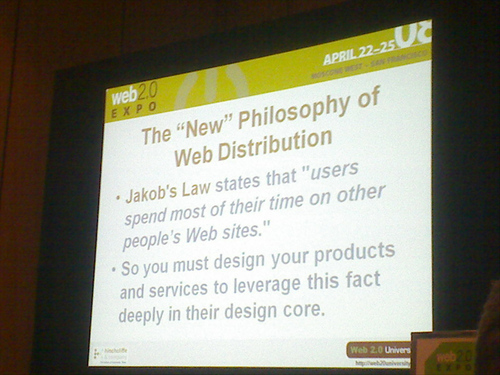
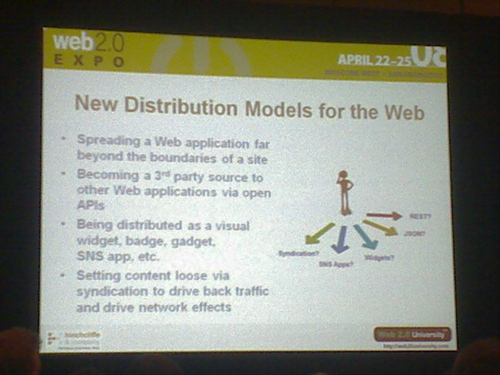
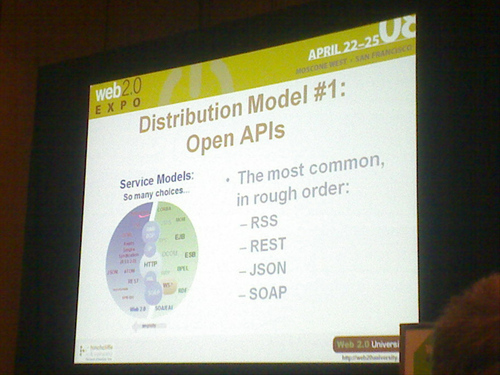
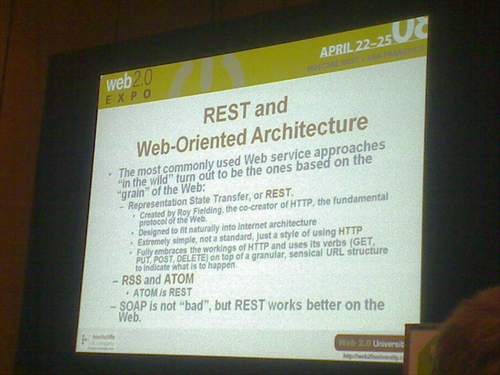
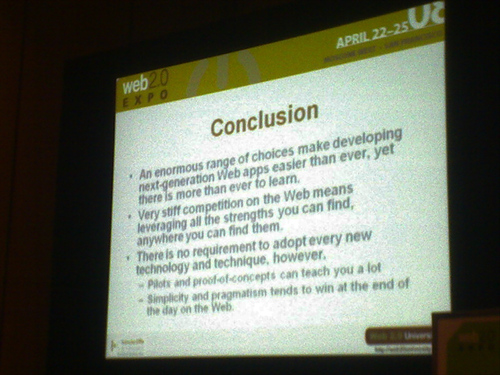
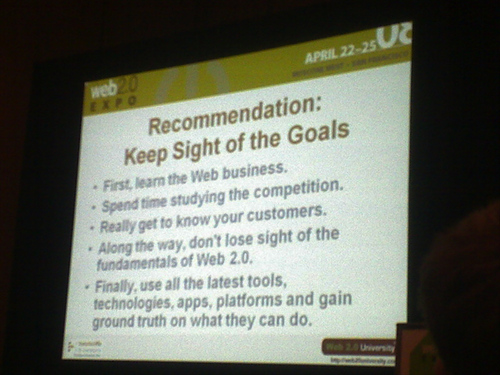
NASA HQ
Posted on Tuesday, April 22, 2008
Ever wondered what NASA HQ looks like from the inside? Here's one take at it, from my visit to DC last week.
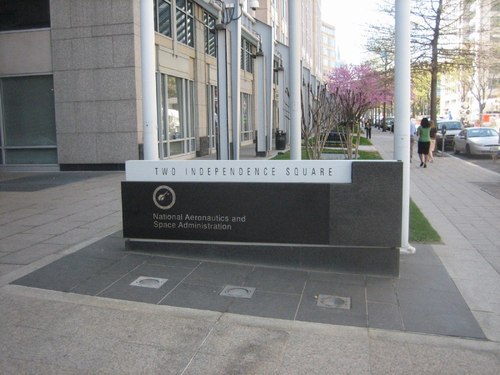
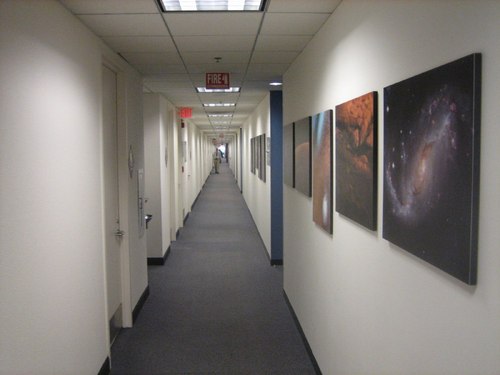
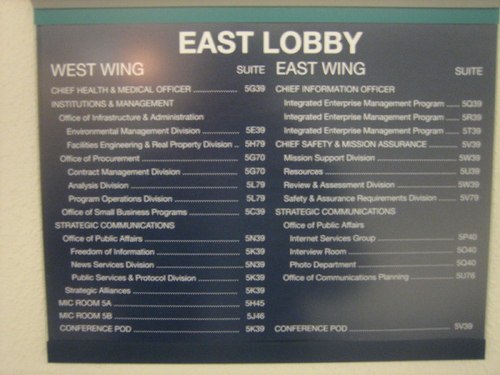
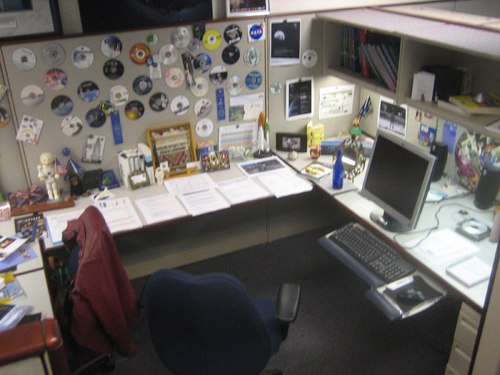
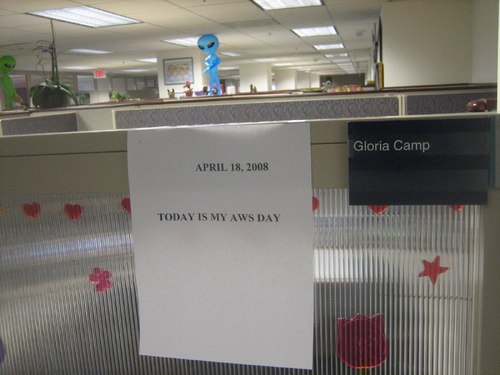
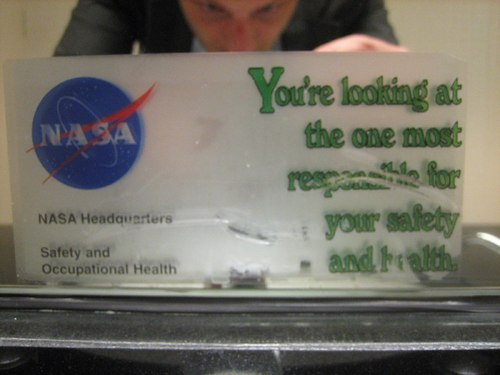
View Larger Map
Cloud Services
Posted on Tuesday, April 22, 2008
I've been doing quite some reading on cloud services and web2.0 vs SOA architectures recently. Along the way I came across this informative video by Jeff Bezos from Amazon. He makes a good correspondence to Nicholas Carr's 'The Big Switch'.
Watch live video from HackerTV on Justin.tv
Space on your computer
Posted on Wednesday, April 16, 2008
A couple of links from DC Dulles Airport:
- I wrote about a GE vis of the ASAT test earlier last year (earlier post). Following users stats on a little Youtube video I made of the STK ASAT scenario, I come across below AGI's Youtube promo video of the ASAT test.
- If you have a minute, have a look at this simulation environment from DigitalSpace. Once installed (PC only) its pretty neat to push the little rovers around and play with the different gravity options (Earth, Moon, no gravity). There are user interface issues but these will probably be solved along the way.
- GE 4.3 was released yesterday. Some cool stuff: Google gave its Earth an atmosphere, day and night time visualisation and a whole lot more I don't have time to test right now. Check in with GEB for a run down of the new features. But wait, did they alter the shortcuts? I can't zoom in/out using Apple+PageUp/Down anymore.
Yuri's Night 2008 Revisited
Posted on Tuesday, April 15, 2008
Ah, we shouldn't forget to mention NASA Ames director Pete "The General" Worden himself of course, the one who is making this outburst of creativity possible here at Ames...(photo via cnet
Yuri's Night 2008
Posted on Tuesday, April 15, 2008
Only at Ames: space & culture in perfect symbiosis (more where this came from @ my Flickr)
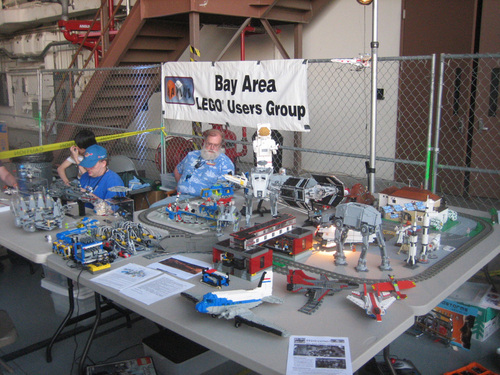
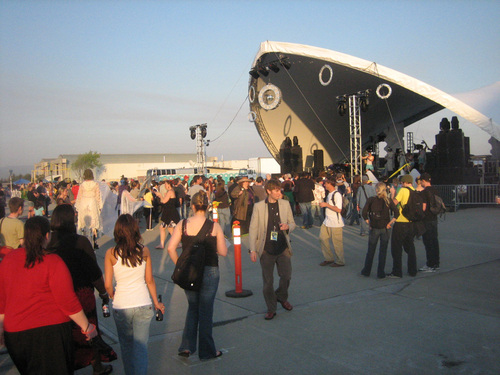
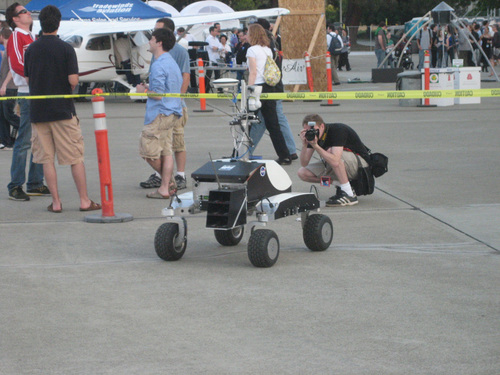
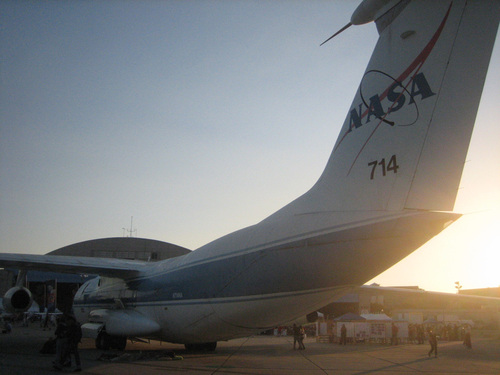

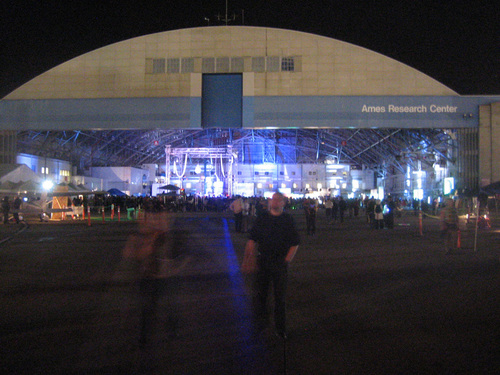
Richard Dawkins @ UC Berkeley
Posted on Friday, March 21, 2008

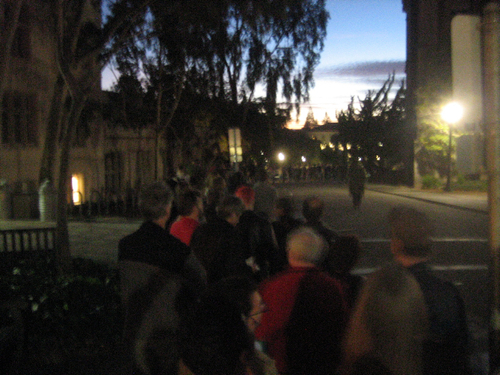
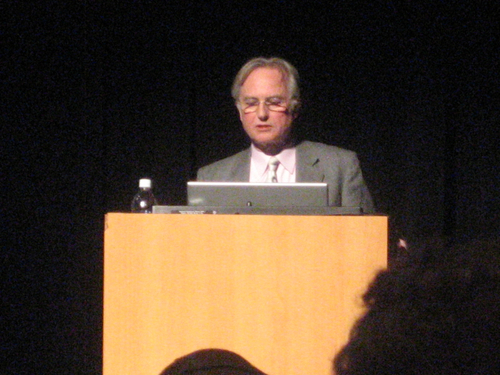
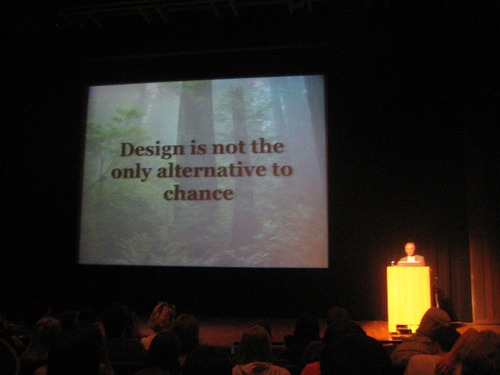
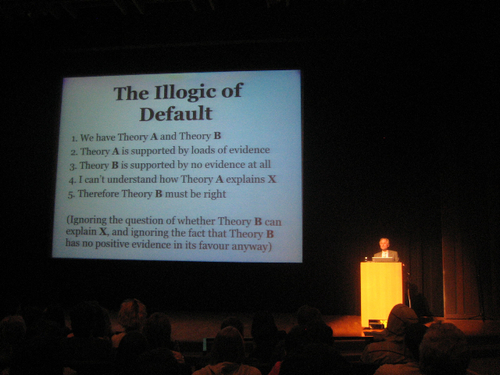
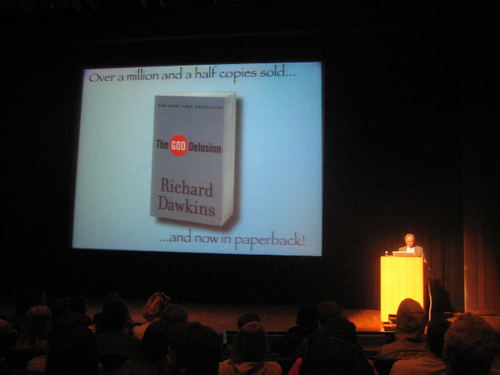
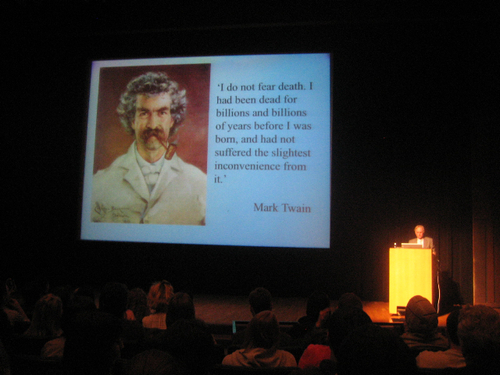
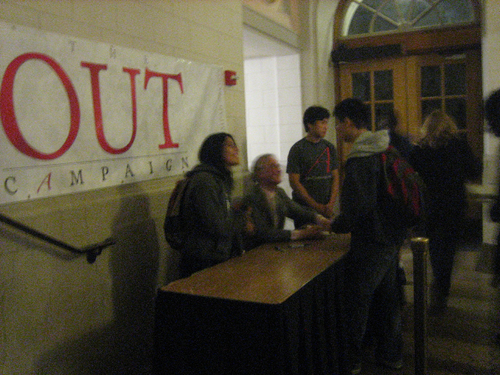
There goes another one from my wishlist. 2 weeks ago I went to see a lecture by Richard Dawkins in the Wheeler Auditorium at UC Berkeley. Although the God Delusion is not my cup of tea (I don't have a religion to loose), my admiration of him comes mainly from his evolutionary work like the Selfish Gene and others. Arriving that saturday evening, things were looking a bit grim at first, I was expecting not a big turn out, but when I arrived there was a large crowd and a long row. Good to see he has a big following in the US. With a bit of luck I managed to get into the auditorium on a standby ticket.
Next on my list: the computer history museum, lunch at Apple and Google HQ, and a couple of others. Keep you posted. Oh, and another one, the Columbia supercomputer at NASA Ames (image below), been there as well wednesday, thanks Creon.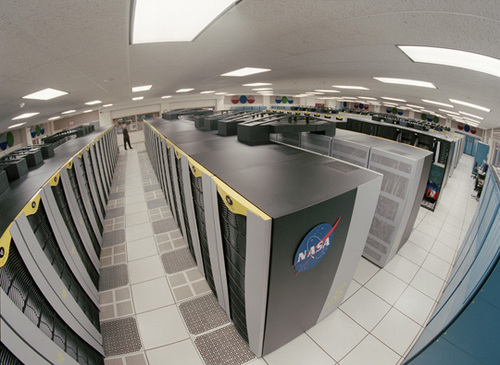
A.C. Clarke died today
Posted on Wednesday, March 19, 2008
...(bbc news)
update: Google's Chief Evangelist Vint Cerf also says goodbye to Clarke in this post. It includes a nice video of Clarke recorded end of last year.
A story of planets and links
Posted on Wednesday, March 12, 2008
Space To The Rescue
Posted on Monday, March 3, 2008
- Need a good
excusereason to go to New York? Read this NYT review of the MOMA exhibition 'Design and the Elastic Mind'. Makes me wanna go! More at MOMA (via Google LatLon) - TED was on. Missed it. Next year. Here are a lot of good videos from it. Lots of buzz about Microsoft's new move vs Google Earth/Sky: World Wide Telescope. The TED video is here. Indepth reviews at OgleEarth and GoogleEarthBlog. Looking forward to a test drive, which will have to wait untill they release it this spring.
- Just learned that Google is running a www.google.com/space subdomain these days with the following overall statement:
There's nothing we love more than ambitious research with world-changing potential, and space exploration and research have long produced much of the scientific community's most ambitious, even audacious work.
We honor the work that's been done in the past, and want to foster and support that work today and in the future. By supporting space-related research and exploration, we hope to inspire a new generation of innovators to enter the fields of science, technology, engineering and mathematics. We believe that the same imagination and passion that fuels space research and drives those who meet the challenge of space exploration will also help advance research and development in fields closer to our own.
That's certainly a statement I can get my head around, especially coming from an IT/media company ;-)
Btw, I learned about the subdomain here at Ames where Chris Kemp and Matthew Hancher (NASA's Planetary Content team Project lead) showed us the Google Street View equivalent on the Moon: Apollo panoramas...uhm...lunalocated (?). Quite impressive. Story telling is a big part of the overall picture, as both reviews (above) of the upcoming Google Sky competitor are right in mentioning. The possibility to re-live Apollo adventures in their appropriate context is excellent. Its still a bit text-heavy for now, but I am sure that that's gonna change as the platforms evolve. Btw2, for some reason this most recent release of Google Moon (think it was this post d.d. 13th September 2007 where it was announced) didn't make it up the list for me, which makes me wonder: is it time for a dedicated Google Space Blog?
Time to get on the bus
Posted on Wednesday, February 27, 2008

Ok, so its time to give a brief update on my (physical) whereabouts. Since last thursday I moved from Amsterdam to Mountain View, Silicon Valley to work with Chris Kemp and his collegues over at NASA Ames starting next monday March 3rd. Weehoo! Finally, a long held dream is coming true, taking part in the upcoming merger of outer space and cyberspace, right at the heart of where all things space are happening. Couldn't be better!
As for this blog, looks like I will be using it from now on to give you a personal insight in my personal and professional experiences here in the Valley. Sofar, these include a great arrival and first few days enjoying the Bay Area rainy season (yes, it can rain here...), a visit to the Vertical Motion Simulator on NASA Ames premises last friday (for photos have a look at this flickr album), my first NASA vrimibo with Ames director Pete Worden, Chris Kemp and several of my upcoming collegues (vrimibo is short for 'vrijdag middag borrel', Dutch for the traditional friday afternoon drink), a first counter-clockwise drive around the Bay Area, and writing off the first item on my wishlist of things-to-do-when-I-get-to-the-Bay-Area: attending a Long Now seminar in San Francisco (on which more in a follow-up post).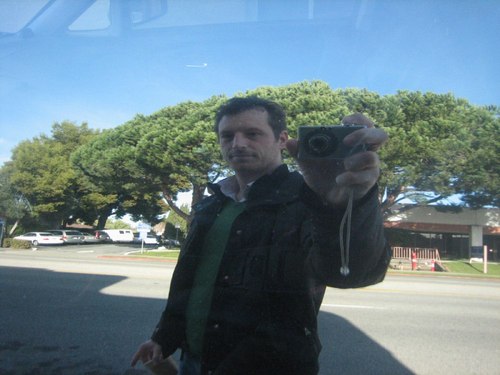
US Satellite shoot-down a success
Posted on Monday, February 25, 2008

Enough has been written about the succesful shoot-down of the defunct NRO satellite last wednesday, so let me just chip in with above photo I found as part of a DoD photo essay of the event. Its a beautiful shot, almost surreal, reminiscent of the V2 and alike. Looking around, I am surprised to find the DoD New Media website is also surprisingly up to speed on web2.0 technologies, as below embedded video of the press briefing by General James Cartwright shows. Some of the clips run a slick CNN-like leader with the name 'The Pentagon Channel'...Interesting proposition...;-)
And the 14 Challenges go to...
Posted on Sunday, February 17, 2008
The Grand Challenges for Engineering in the 21st Century. These challenges have been announced Friday February 15th by a Committee including names like Kurzweil, Page, and Venter. Outer space is one of them, but only via the somewhat non-descriptive Challenge to 'Engineer the Tools for Scientific Discovery'. Cyberspace on the other hand gets its own Challenge to 'Enhance Virtual Reality'.
Columbus installed on ISS
Posted on Tuesday, February 12, 2008
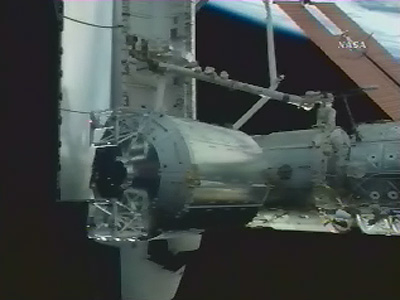
Strange...I thought it would be installed on the other side. This seems to be the place of the Japanese module KIBO. Well, at least the Shuttle docked at the right place. More at ESA.
IYA 2009
Posted on Tuesday, February 12, 2008
Not sure what the aliens are doing in below poster, but during 1 revolution around the Sun its International Year of Astronomy (aka IYA).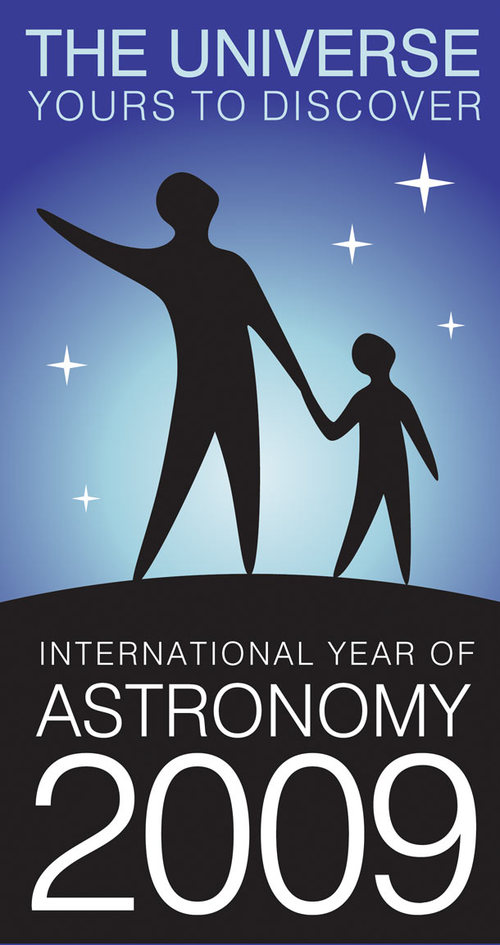
US space policy
Posted on Tuesday, February 12, 2008
The Space Review runs an article by Taylor Dinerman about US space policy and the challenges for the US space program with a new president coming onboard. The short article ends with the following reminder worth remembering:
Senior space policy expert John Logsdon said that for the next President, the critical moment will come in the fall of 2009 when he, or she has to make decision concerning the 2011 budget. That will be the moment when the US will truly decide if it wants to lead the way in space for the next twenty or thirty years, or not. If the President decides to retire the shuttle and go ahead with the full Constellation program, then the path will be clear; if not, then not only will China probably beat us back to the Moon, as Mike Griffin and Pete Worden have warned, but the US will lose years or maybe decades while it struggles to find a new vision to replace the one that was thrown away.
SpaceCollective.org
Posted on Monday, February 11, 2008

Techno utopianism lives on. Its been a while since we heard from Kurzweil, but I recently came across this website called spacecollective.org, set up by former country man Rene Daalder. From a first peek, it seems to be along the lines of what this blog is all about, that is, evolution of technology and the role of space in this evolution. Spacecollective.org seems to have a healthy critical stance, definitely worth a visit. I like the fact it originates from someone in the film industry, one of the main story telling industries out there and a long time passion of mine. Like the Peppers used to sing:
Space may be the final frontier
But it's made in a Hollywood basement.
Immersive Video
Posted on Sunday, February 10, 2008
Via OgleEarth, 360 degrees immersive video delivered to you through the Internet. Impressive. And shareable, like the ones here below (hint: drag the arrow inside the videoscreen).
Realtime news becomes programmable "LEGO"
Posted on Saturday, February 9, 2008
A good post over at O'Reilly Radar on the evolutionary nature of news agencies and the semantic web, carrying amongst others the following copy:
The end of benefits from decreasing the time it takes for news to hit the market. He describes the quest for zero latency in news, from the telegraph and early stock tickers and the news business that Reuters pioneered through today's electronic trading systems. (Dale Dougherty wrote about this yesterday, in a story about the history of the Associated Press.) As we reach the end of that trend, with information disseminated instantly to the market via the internet, he increasingly sees Reuters' job to be making connections, going from news to insight. He sees semantic markup to make it easier to follow paths of meaning through the data as an important part of Reuters' future.
and
What I think does ultimately matter is the ability of professional media to build specialized interfaces and vertical data stores that are suited to their niche, hopefully harnessing data and services from the consumer internet, and mashing them up with specialized, perhaps private, data stores. Put that together with metadata for programmable re-use, and you may really have something.
ISS from the ground (June 2007)
Posted on Friday, February 8, 2008
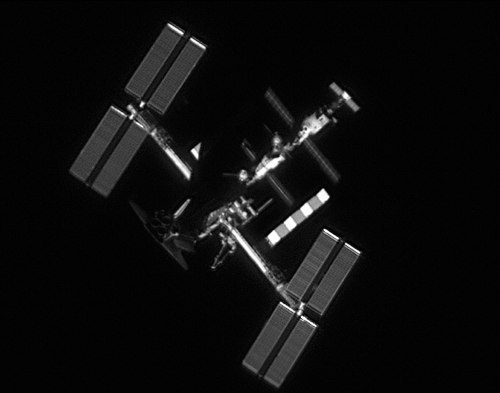
This images gives an idea of what it will look from the ground when the shuttle docks to deliver the Columbus module to the International Space Station in the days ahead. Not sure if the shuttle will dock at the front port btw cause that's where Columbus is supposed to go. (via ESA)
Columbus is in orbit
Posted on Thursday, February 7, 2008
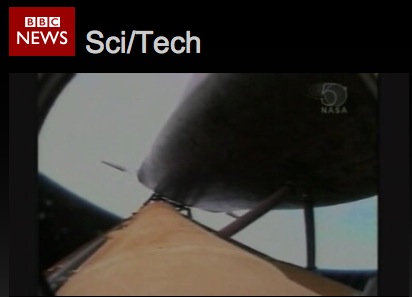
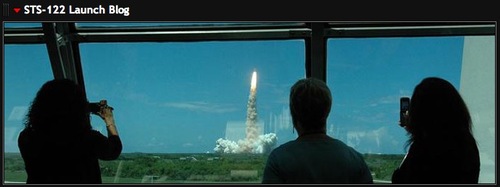
Congratulations to everybody involved!
More at:
NASA STS-122 blog
BBC news (10 min video)
NASA's Day of Remembrance
Posted on Saturday, February 2, 2008

January 31st turns out to be NASA's Day of Remembrance I just found on this NASA page running the following copy:
NASA Deputy Administrator Shana Dale, left, and other NASA senior management participate in a wreath laying ceremony at Arlington National Cemetery as part of NASA's Day of Remembrance, Thursday, Jan. 31, 2008. The wreaths were laid in the memory of those men and women who lost their lives in the quest of space exploration, including the astronaut crews of Columbia, Challenger and Apollo 1.I am struck by the beautiful serene image accompanying the article. Hardly feels like the space imagery we are used to get from a space agency. (((Having watched a lot of Sopranos years ago, I feel my mind is already starting to spin all kinds of stories...)))
The Medium is the Mind
Posted on Saturday, January 19, 2008
Another good reason why to read below book, the following quote comes from the author's blog:
"The medium is the mind," I write toward the end of The Big Switch, arguing, as others have before, that the tools we use to gather, store, and analyze information inevitably exert a strong influence over the way we think. As the internet becomes our universal medium - what the director of the Annenberg Center for the Digital Future terms "a comprehensive tool that Americans are using to touch the world" - its technical characteristics also begin to shape, slowly but inexorably, the workings of our memory and our other cognitive processes.
There goes another space based solution
Posted on Thursday, January 17, 2008
Just watching the keynote by SJ. As could be expected, there turns out to be a good reason why the iPhone doesn't carry a GPS receiver. There is a terrestrial way to get your position with less battery expenditure. Its Skyhook Wireless, they even call it WPS (Wi-Fi Positioning System). Combined with Google's triangulation of cellular network antenna's, the positioning is apparently considered to be accurate enough. There goes the market for Galileo. Reminds me of Iridium and the promises of cell phones by satellite, which was totally swepted away due to the proliferation of terrestrial networks.
Are Humans in Space worth investing
Posted on Friday, January 11, 2008
Via NASAwatch comes this story in the NYT about the question: "Is Space Exploration Worth The Cost?"
The answers by the panelists are certainly worth reading, but what I find interesting is that I more and more tend to read these main articles just to see what the ensuing discussion in the comments is about. In this case, the fact that all panelists have careers tied to the space industry certainly doesn't help to give the article a feel of objectivity, as shown by the first row of comments . Here is another comment worth reprinting:
Economists generally think competition is a good thing, but suddenly once we’re out of the atmosphere everyone is going to cooperate and everything will be fine? All the national governments will join hands, and do everything efficiently?
Without some kind of national/corporate race in space — which is impossible due to U.N. treaties — there will never be much beyond LEO.
I am not so sure the UN treaties are the main problem though, cause even without these treaties, what would be the commercial incentives on which businesses are willing to invest +billion dollars for a market of consumers that's...well...back on Earth?
Space Metaphors 2.0
Posted on Thursday, January 10, 2008
Following an earlier mention of space metaphors, yesterday I found this video of Jonathan Harris at TED earlier in 2007. Very nice work! Half way through the video you'll understand the reason for posting it under the title 'space metaphors' (via VanElsas)
Solar Cycle 24
Posted on Thursday, January 10, 2008
Some topics passing by:
- In case you missed it, Solar Cycle 24 just started
- MDA (Canada's biggest satellite business) gets sold to US defense contractor
- The Arts Catalyst blog has recently emerged. From their blog:
The Arts Catalyst commissions art that experimentally and critically engages with science. We bring together people across the art/science divide and beyond to explore science in its wider social, political and cultural contexts. We produce provocative, playful, risk-taking projects to spark dynamic conversations about our changing world.
- A lot of good text over at Edge, following this year's question 'What have you changed your mind about? why?'. Sofar, this entry by Douglas Rushkoff stood out:
The Internet
I thought that it would change people. I thought it would allow us to build a new world through which we could model new behaviors, values, and relationships. In the 90's, I thought the experience of going online for the first time would change a person's consciousness as much as if they had dropped acid in the 60's.
I thought Amazon.com was a ridiculous idea, and that the Internet would shrug off business as easily as it did its original Defense Department minders.
For now, at least, it's turned out to be different.
Virtual worlds like Second Life have been reduced to market opportunities: advertisers from banks to soft drinks purchase space and create fake characters, while kids (and Chinese digital sweatshop laborers) earn "play money" in the game only to sell it to lazier players on eBay for real cash.
The businesspeople running Facebook and MySpace are rivaled only by the members of these online "communities" in their willingness to surrender their identities and ideals for a buck, a click-through, or a better market valuation.
The open source ethos has been reinterpreted through the lens of corporatism as "crowd sourcing" — meaning just another way to get people to do work for no compensation. And even "file-sharing" has been reduced to a frenzy of acquisition that has less to do with music than it does the ever-expanding hard drives of successive iPods.
Sadly, cyberspace has become just another place to do business. The question is no longer how browsing the Internet changes the way we look at the world; it's which browser we'll be using to buy and sell stuff in the same old world.
Social Systems
Posted on Monday, January 7, 2008
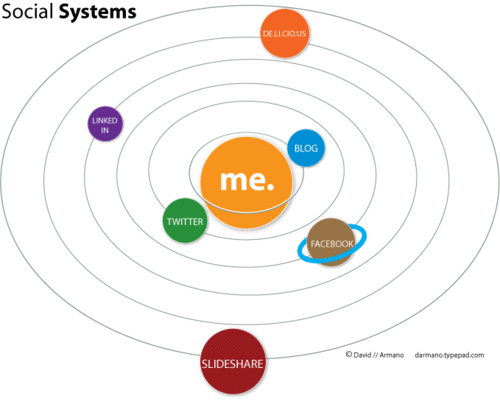
Space makes for great metaphors, but sometimes they can seem just a little bit off. The image above I read, but what about this text:
The related concept of a "social graph" is difficult to explain, but social systems is easy. Many of us are now managing multiple social ecosystems. If you think of these as planets—some rotate in closer proximity to us. We "warm" them with our attention frequently. Others may orbit at further proximities—but they are still in our social systems. When we abandon a social ecosystem that we can no longer sustain, it drifts away from our orbit and dies. Many of us have had these experiences.
The blogpost does link to another interesting post about Influence Riples though. The pond metaphor seems to be better suited here:
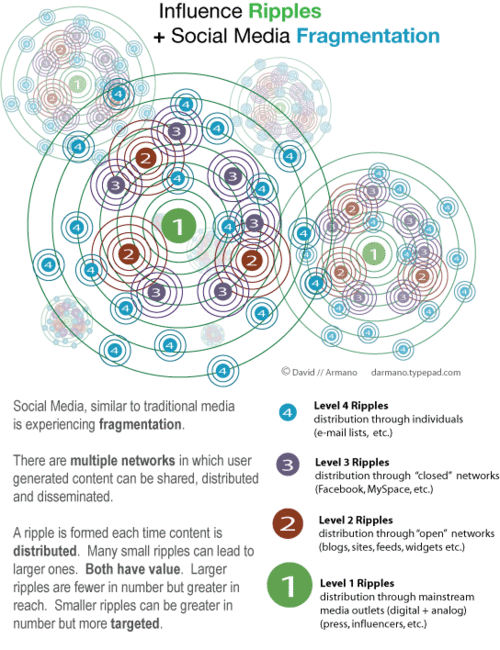
This post's comments also includes another metaphor:
The ripples metaphor is fun, but it is passive and therefore has metaphorical limits.I prefer a bonfire metaphor.
Traditional push-marketing is like a huge organised bonfire. Marketers go to all the trouble of gathering tinder and firewood and inviting people to watch. Then they light the bonfire and stand back as the flames roar and the firewood crackles. Those invited get to enjoy the heat and the spectacle, those a little further away, to enjoy the dancing flames. Those much further away probably don't know there even was a bonfire. And once the bonfire has burnt itself out, all there is left are a few glowing embers and lots of ash.
Social marketing on the other hand is like a network of hilltop bonfires. Lots of different people prepare a limited number of small bonfires. Anyone can start a bonfire and then others on other hilltops can light their own bonfires and so the message spreads. Many people get to enjoy a bit of local heat with their friends and to see the flames flickering on many hilltops. They may even get to feel that they are part of something bigger. And the reach of the bonfire is potentially endless. It only depends upon how many people are willing to light their own bonfires to spread the message.
The metaphor is useful in a number of ways. Firstly, it shows that many small bonfires can reach much further than a large bonfire. Secondly it shows that anyone can light a small bonfire to spread the message to others. Finally, and most importantly, it shows that all these many small bonfires need to be built before the message can spread. If you wait until you see another hilltop bonfire befire you build your own it will be too late. The preparation necessary before a message can spread effectively is one aspect of social media that many commentators forget, in the rush to laud the role of the influencer in propagating social memes.
Back in the real world of influence, it seems to me that traditional marketing and social marketing need each other. Traditional marketing builds category need and awareness (to use the funnel analogy), whilst social marketing enlists those with an interest to spread it further and builds intention to buy. This complementarity is implicit in the p (adoption = traditional marketing) and q (imitation = social marketing) variables in innovation diffusion models in common use for over 50 years!
Keep up the metaphorically enlightening work.
It also links to the following insightful presentation:
Where are the Indies again?
Posted on Monday, December 31, 2007
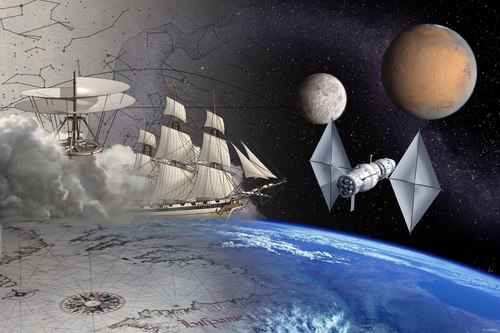
Reading Professor Worner's comments on the 100 years anniversary of German Aerospace on SpaceDaily I suddenly recognise one argument which finally makes some sense to me when it comes to the often used comparison of Columbus' travels to todays space exploration. Columbus set out to find a new route to the Indies (mainly for commercial purposes!), but ended up in America:
Other boundaries are invisible. They are the boundaries of our knowledge. We do not know yet, which discoveries our research with Columbus will bring us. But we do know for certain that we will make new discoveries. Perhaps we may think that we are sailing to India, while we actually end up discovering America...Perhaps this is an interesting entry point when it comes to comparing todays space exploration endeavours with that of Columbus. We have always projected our stories onto the heavens (for a good intro, see the first part of this movie) so I wonder what will be the unexpected outcome(s) of space exploration in the decades to come? Any thoughts? (btw, the image above comes from the AURORA website of the European Space Agency)
Setting Sun on Mars
Posted on Sunday, December 30, 2007
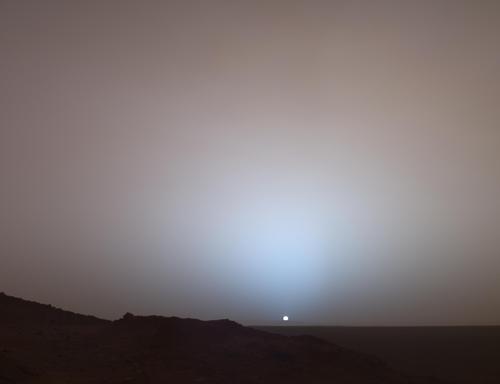
Its the winning photo of a contest over at JPL. Look at the full res image and let it sink in. Quite profound.
Welcome aboard
Posted on Sunday, December 23, 2007
The Bible According to Google Earth
Posted on Wednesday, December 19, 2007
Via OgleEarth comes the following:
Sydney art collective The Glue Society produced a work that consists of retouched satellite imagery to depict biblical mythology. Says Glue Society’s James Dive: “We like to disorientate audiences a little with all our work. And with this piece we felt technology now allows events which may or may not have happened to be visualized and made to appear dramatically real. As a method of representation satellite photography is so trusted, it has been interesting to mess with that trust.”
More at Creative Review. Reminds me of an exhibition on Solar Science Debra Solomon, me and Ricky Seabra developed a couple of years ago for ESA as ArtRaceInSpace Ltd. Nice to see Google Earth is entering the domain of contemporary art. Its gonna be a smiley day today. Anybody up for geo-referencing these scenes in Google Earth? ;-)
The Crucifixion
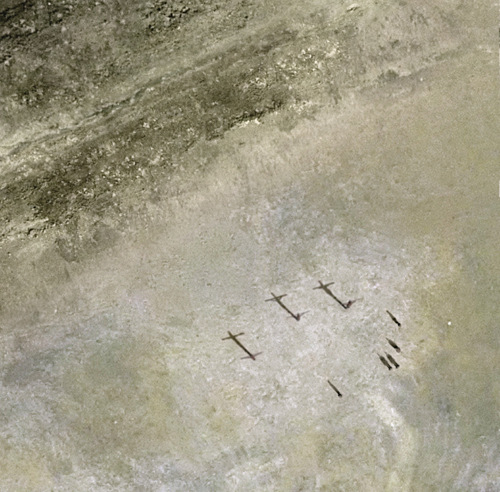
Adam and Eve in the garden of Eden
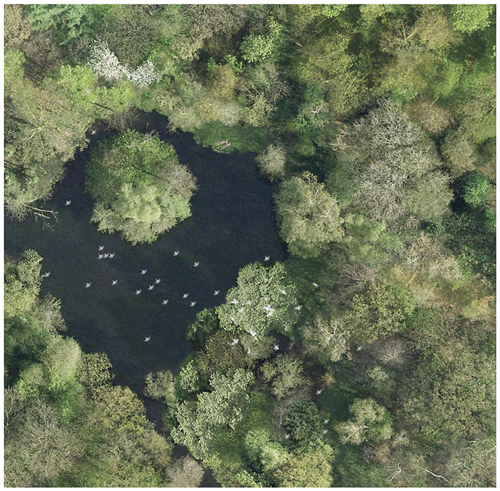
Noah's ark
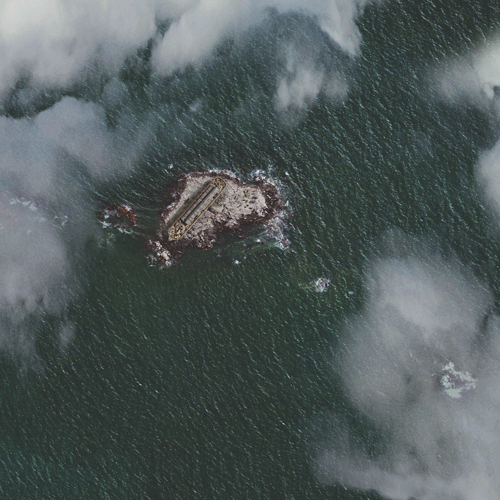
Moses parting the Red Sea
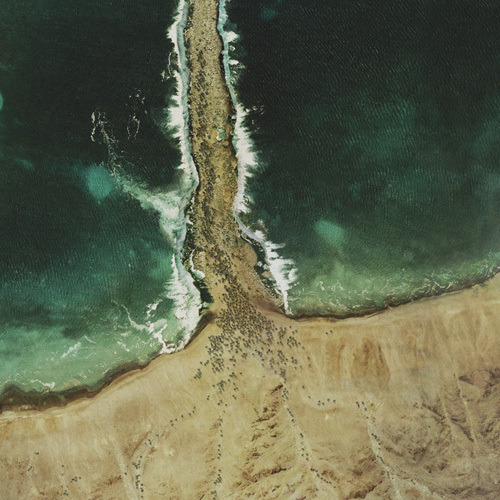
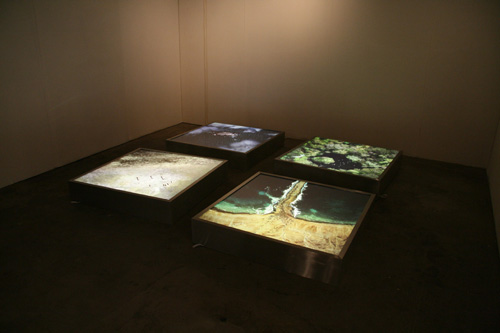
Augmenting Reality
Posted on Thursday, December 13, 2007
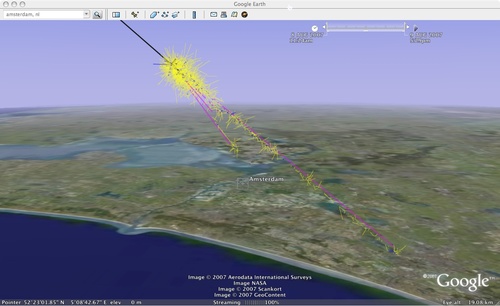
A couple of non-related items I came across today:
- Following a link on Google LatLong I came across this animation in Google Earth of a cosmic ray shower which was done by Leiden (NL) based Cosine Research (one of several companies surrounding the European Space Research Centre ESTEC here in Noordwijk). To view the animation in Google Earth, click the clock icon next to the time slider, set 'Restrict time to currently selected folder' and press the play button on the right of the time slider.
- This is where NASA's Mars research pays off.
- Nicolas Carr links to an article in The Economist about Augmented Reality. Recently I saw this video which tries to capture the idea of AR in video.
- TomTom and Vodafone are working together (in Dutch). Every car becomes a data point in the "realtime traffic jam sensor web". More at TomTom.
DinnerTV: Galileo
Posted on Monday, December 10, 2007
Belgeoblog links to an informative Belgian documentary about the Galileo project and its political and technological challenges. In a mix of Dutch, French, English and US English spoken languages and brought to you in 24 style. Well worth to watch!
Shuttle launch in GE
Posted on Saturday, December 8, 2007
STK's AGI released a visualisation of the imminent shuttle launch to the ISS (via GEB)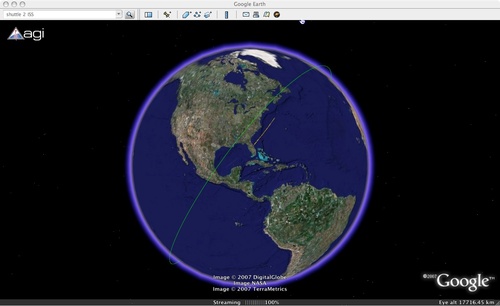
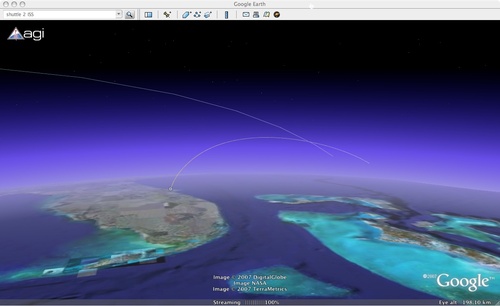
NASA OS
Posted on Monday, December 3, 2007
NASA launched its re-designed portal NASA.gov over the weekend (more at NYT and Wired). First thought: Wow! Great to see a space agency portal evolve into an open platform for space. Second thought: Leopard's Time Machine. Haven't installed the recent OSX update myself yet but at first glance the background of the new NASA portal seems to have a lot in common with that of Time Machine ;-) (earlier post). I'm currently reading Marshall McLuhan's Understanding Media - The Extensions of Man which, thinking of the Extensions of Man out there (aka technology, aka satellites), applies nicely to my Macbook. I guess in the not too distant future we'll be able to pick our favorite live satellite stream as the background to the NASA portal (like this one from SOHO). Too bad exposé doesn't work on the NASA portal because I find myself hitting the top right corner of my screen every time I want to have a look at the background. Some NASAwatch reader comments on the redesign are here.
Another inspiring release came out this week from NASA: the proceedings of the Participatory Exploration Summit held earlier this year @ Ames.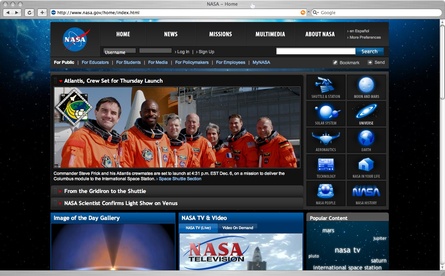
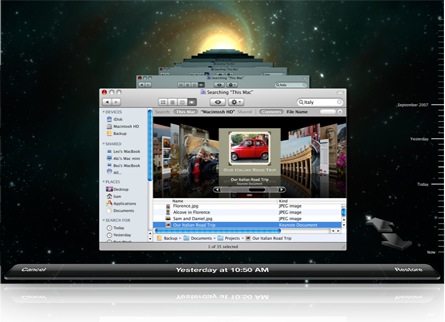
Presidential POVs on space explo
Posted on Thursday, November 29, 2007
When US presidential candidates get asked about their stance on space exploration, its always helpful to read what science fiction writers have to say about it. Agreed, space exploration is very different from the topic of space colonisation, but still its worth reading Charles Stross' take on the latter, even if only for the 1AU=1cm metaphor and the ensuing discussion in the comments.
Just found a good quote in one of his other articles:
Of course, aside from making it possible to write very interesting science fiction stories, the Singularity is a very controversial idea. For one thing, there's the whole question of whether a machine can think — although as the late, eminent professor Edsger Djikstra said, "the question of whether machines can think is no more interesting than the question of whether submarines can swim". A secondary pathway to the Singularity is the idea of augmented intelligence, as opposed to artificial intelligence: we may not need machines that think, if we can come up with tools that help us think faster and more efficiently. The world wide web seems to be one example. The memory prostheses I've been muttering about are another.
Google Earth and the Evolution of the User Interface to the Internet as platform
Posted on Wednesday, November 28, 2007
After wondering about GE's evolution myself yesterday, Techcrunch is now running a somewhat more blunt story of Google Earth heading towards extinction question mark:
Google has announced two new features for Google Maps that mimic features in Google Earth, begging the question: is Google Earth on borrowed time?The first new feature is the additional of terrain in Google Maps. The terrain fly over feature has long been available in Google Earth, but now you can fly over a map and see the contours of the land, all without the need to download Google Earth.
The second new feature mimics the community contribution feature of Google Earth. “Our Maps” brings wiki-style collaboration to Google Maps, with users able to annotate places and share those notes with friends or the greater public.
Google acquired Keyhole in October 2004 and it was immediately obvious as to why: Google wanted the satellite imagery to support their move into serious mapping. Keyhole provided Google Earth, a downloadable program that gave a then unprecedented view of the earth through the use of satellite imagery, but Google isn’t a software company, Picasa and a few small efforts aside. Google has integrated many of the functions from Keyhole into Google Maps whilst continuing to sustain Google Earth, but for how much longer? As Google Maps takes on more and more of the functionality of Google Earth the appeal of Earth must diminish. It also makes sense that Google would rather grow and sustain a web product over a software download. Google Earth will still be with us for some time to come, but how long is now up to Google, and I’m betting that Google is already looking at ending support sometime in the next year or two as Google Maps becomes everything Google Earth now is, but online and without the download.
Looks like Avi has the most sensible comment in there which deals with the topic at hand:
...As CPUs and browsers become more powerful, the features of the two applications will merge, as I’m sure was the plan all along.But since browser evolution has been so excruciatingly slow, I think it’s far more likely that we’ll see Google Earth become the defacto 3D web browser vs. Duncan’s prognostication.
ISU2
Posted on Tuesday, November 27, 2007
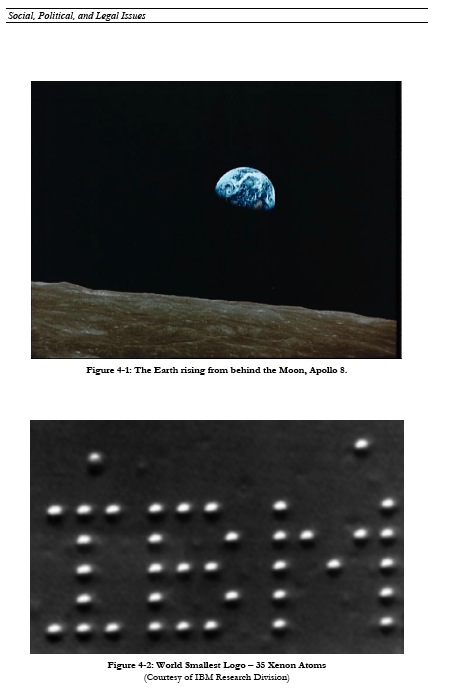
Erik Laan points me to this post about the ISU2 working meeting held at Ames Research Center yesterday and today:
The ISU-2 Working Meeting is being hosted by NASA Ames Research Center to bring together key individuals to brainstorm the concept of the International Singularity University (ISU2) and to answer certain fundamental questions and plan for a "Founders Conference" expected in Spring 2008 and an inaugural Summer Program in 2009 in the Bay Area.International Singularity University (ISU2) which would educate attendees on the history, current status, trends and projected futures of these technologies. ISU2 will facilitate students to form networks, study the implications of exponentially advancing technologies (nano, bio, AI, etc), the cross-disciplinary interactions, and legal, policy and societal implications which will result. ISU2 would be modeled on the concepts and practices pioneered by the International Space University (ISU) during its past 20 years of operation (1987 - 2007).
Date: 26-27 Nov 2007
Location: NASA Ames Research Center, Moffett Field, CA, US
Web Site Address: http://www.arc.nasa.gov
Way to go Ames! I am an alumni of ISU1, that is, the International Space University, where I participated in the '06 summer session Team Project dealing the impact of Micro & Nano Technologies for space so I am thrilled to see the ISU formula being applied to a topic that is close to my heart. In fact, I think I'd gladly follow the ISU-2 summer session cause it'll have a lot of interesting ground to cover. And Silicon Valley is the right place to be when it comes to the Singularity. ISU1 summer session 2009 is already scheduled to be hosted at Ames so '09 promises to become a truly remarkable summer over in Mountain View.
The Future of the Past
Posted on Tuesday, November 27, 2007
Nice space art for a change (thanks Jurryt!). Readers of this blog will have noticed I specifically use the term 'space related arts' for the activities I am involved with, like these, in order to make a distiction with the general understanding of what space art is, like this.
China to the Moon
Posted on Monday, November 26, 2007
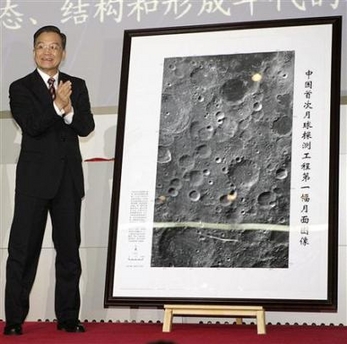
A nice combo: China and the Moon. More at Yahoo! and xinhuanet.
Google Space Agency
Posted on Monday, November 26, 2007
A quick backlog of links related to the Google NASA coop. They're working on it down at Ames in what is called the 'Planetary Content Team' (nice title):
The Planetary Content Team at NASA's Ames Research Center develops software that makes it easier for scientists and engineers to publish and access Earth and planetary imagery and data via the Internet. This includes both educational/outreach content aimed at the general public as well as technical data aimed at the scientific community. Headquartered in the Intelligent Systems Division at Ames, the team also includes partners in other areas of the agency and elsewhere.
They do both the NASA Google Moon work (Google maps only sofar but they're working on a Google
“NASA’s objective is for Google Moon to become a more accurate and useful lunar mapping platform that will be a foundation for future Web-based moon applications, much like the many applications that have been built on top of Google Maps,” said Chris C. Kemp, director of strategic business development at NASA Ames. “This will make it easier for scientists everywhere to make lunar data more available and accessible.”That's gonna come in handy when the robots are going to land on the Moon in the decades to come.
View Larger Map
Remap our intuition
Posted on Monday, November 26, 2007
A new video with Will Wright talking about Spore at TED earlier this year. Great stuff. Some interesting quotes and discussion @ 12:10 -> "remap our intuition" - "computer simulations can recalibrate your instinct across vast scales of both space and time" - "better calibration on long term thinking".
Rosetta looks at the Earth
Posted on Tuesday, November 20, 2007
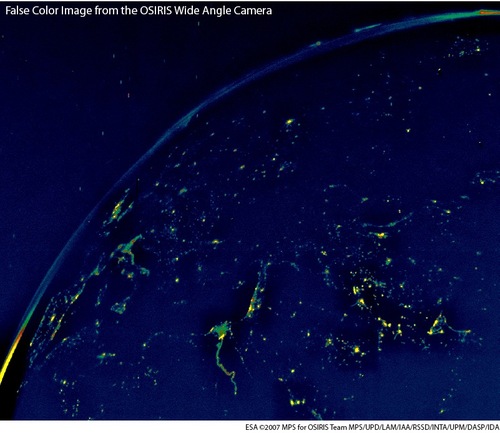
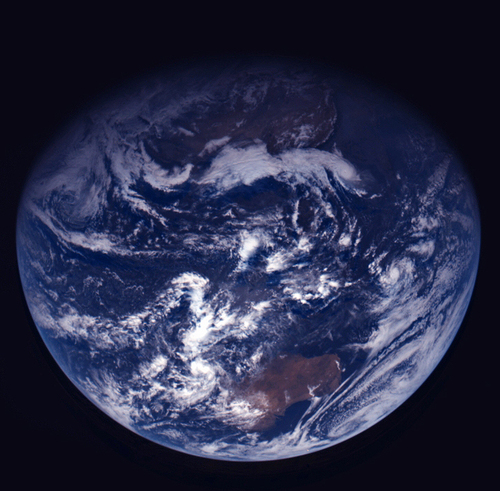
The first one is an oblique look at Europe with the Nile delta and Israel in the middle of the image. More about these images at ESA.
Space Explo's Value Propositions
Posted on Monday, November 19, 2007
The Register today writes under the title 'Americans clueless on NASA budgets' :
A recent survey, carried out on behalf of The Space Review, has revealed that the average American believes a quarter of the country's public purse goes towards funding NASA.Unfortunately, The Register gets its facts wrong because the survey was never conducted on behalf of The Space Review but merely written about on The Space Review, which happens to be one of the more interesting space blogs to read out there (together with NASA Watch and spacecynics). Going to the original article quoted above, I find 2 great articles on space exploration, relevance and customer value: Part 1 and Part 2. On the spot! It's a relief to read this as it provides a pretty clear cut picture of space exploration and its place in modern day consumer market thinking:
The survey found that most people reported the belief that NASA is almost as well funded as the military. The Department of Defense does receive roughly 21 per cent of the nation's wonga, but most people overestimated this by a further 12 per cent.In reality, NASA gets something like 0.6 per cent of the natonal budget, a fact which researchers report came as a surprise to those being surveyed. According to The Space Review, one participant replied "No wonder we haven’t gone anywhere!".
The survey formed part of a larger analysis of the costs and benefits of having a publically funded space agency. The writers argue that people have scant knowledge of what NASA actually does. Combined with the huge overestimates of the cost of running NASA, it is not surprising that people often regard it as being poor value for money.
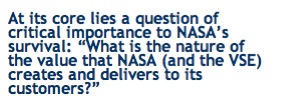 .
.
HDTV from the Moon
Posted on Wednesday, November 14, 2007
The only thing missing now is a live internet connection to this camera. Anybody has a 30m dish available? More on the video material at JAXA, the Japanese space agency who's satellite SELENE is currently flying the HDTV camera in low lunar orbit.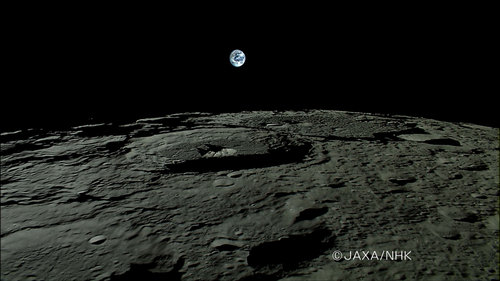
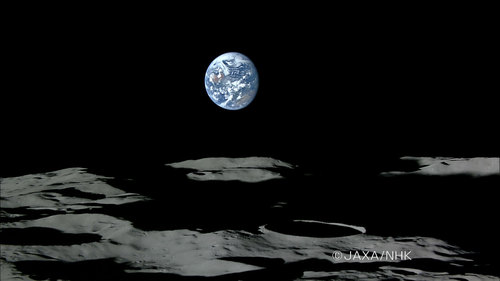
Some thoughts following the Space Explo Conference
Posted on Tuesday, November 13, 2007
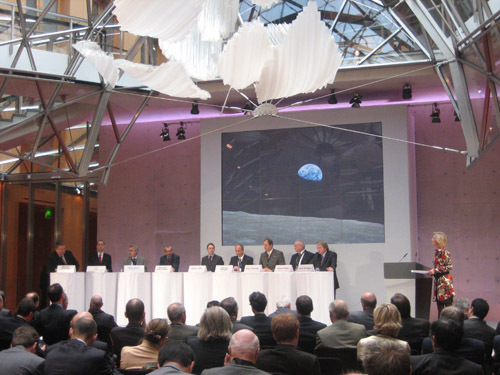
Update 15 November: I was told at ESTEC today that videos of the conference will indeed be posted lateron once they are finished with the editing.
I went down to Berlin last week to attend an ESA/DLR conference on the future of Space Explo in Europe. A lot was said, presentations were abundant, and the various stakeholders (in particular politicians, space agencies and industry) gave their view on what Europe should be doing in the years to come on space explo. One of the main outcomes of the conference: the European Space Exploration Strategy has been reworded to the European Space Exploration Programme...he, these things can make a world of difference.
Interestingly enough, the M word, as in Moon, is still hard to pronounce by Mr. Sacotte of ESA as the agency has decided it should focus on the Mars. Seems this is a position they took when NASA was fully engaged with Mars exploration back in the early 00's. However, since then, Bush has redirected the NASA strategy towards bringing humans back to the Moon, and it seems hard for ESA to bring its strategy in line with this redirected global explo agenda. So while all countries pulling any weight in the space explo arena, China, India, the US of A, all have their focus on the Moon, Europe seems to be struggling with their lock-in in thinking about the Mars (the English pronounceation of native German speakers brings some funny mashups, as in talking about the Moon vs talking about the Mars). Germany however isn't fooled and recently announced its plans to develop a national lunar probe, something that was re-iterated at the conference by DLR Director of Space Programmes Mr. Dollinger.
There was a point where I got intruiged about the way they talked about the usual dichotomy between robotic (unmanned) and human exploration. Usually, this debate quickly ends in the trenches where the proponent on either side digs him/herself in with the usual arguments, leading nowhere. A first smart remark in this context I remember from US astronaut Jeffry Hoffman (of Hubble repair fame) who made the comment at ISU about the complementariness of humans and robots (I don't remember his complete argument, but given that he went up to space to repair a robotic explorer kind of paints the picture of his understanding). At this conference, there was the same question on the table. On itself an interesting question and space is one of the few places where this comes up all the time due to the shear costs involved in sending humans up. This time, it felt as if the conference participants, all human to my knowledge, where there to make a strong case for human exploration...because all of us attending were human. It seemed there was a stance in the robotic/human debate about us against them. Its the first time I interpreteted the debate this way, but it makes for an interesting perspective on where things might be going. The drive to explore doesn't change, its the means that are under scrutiny. Another argument in this context, one that I made together with an ISU collegue last year at a presentation was the following: the most efficient space suit is one without a human inside.
Another important topic which seemed to come up every 5 minutes during the conference was the need for communication of why Europe needs to take part in this global exploration agenda. Well, I guess its true then. The 'Artist as Space Explorer' space & the arts exhibition was nice in that respect but I had a strong deja vu of some 7 years ago when I was involved in a similar type of set up for ESA and the exhibition was mainly used as decoration around the bar with free champagne. Not that different here. Still, it appears there is a little seed taking root at ESA. Hope they'll let it grow...
If this were the web2.0 Summit held in San Francisco last month, the presentation videos would have been online by now. But this is a meeting of much less importance so no videos yet (space exploration...wasn't that something with Apollo?). I really hope they put some videos of the conference online, but given ESA's track record of keeping the walls high and dry, I have my doubts. I'll certainly address it when I get to ESTEC this week. Also in terms of putting the presentations online. If you're interested to put some faces to names, have a look at the flickr photoset I uploaded with the main talking heads. Below pictures were from a presentation by astrophysicist Hans-Joachim Blome about the Cultural Dimension of Human Spaceflight and Exploration. He managed to stay out of the usual paths and gave a glimpse at exploration from a scientific evolutionary point of view. I hope to receive his presentation later this week so I can post it here. 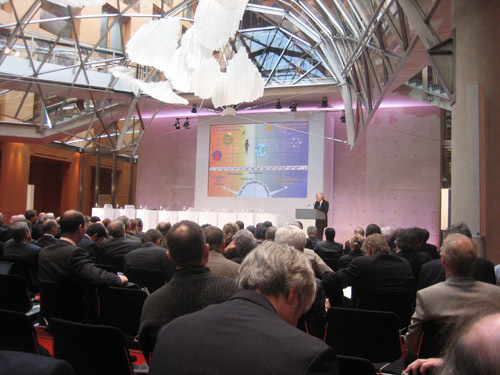
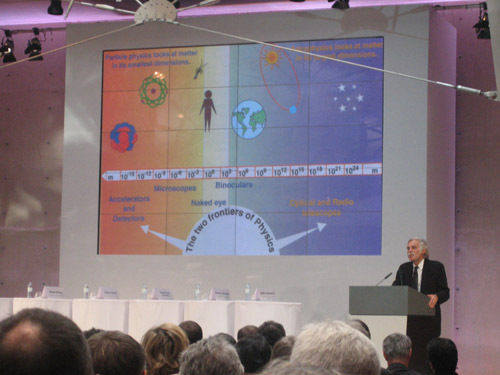
Its Getting Pretty Big Out There..and Beautiful...
Posted on Tuesday, November 6, 2007
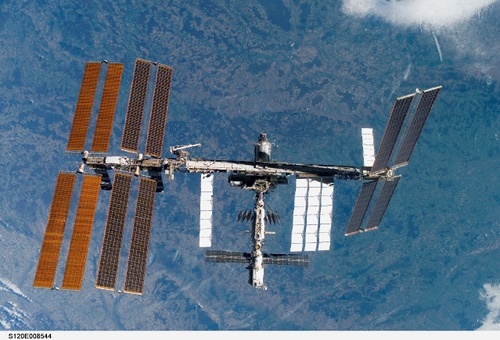
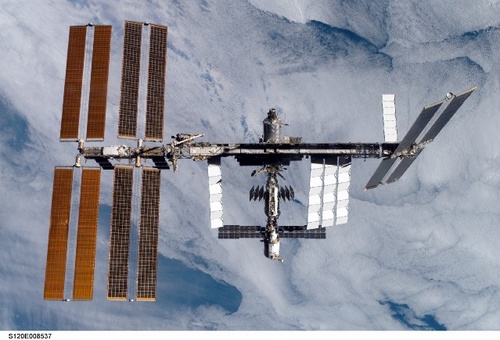
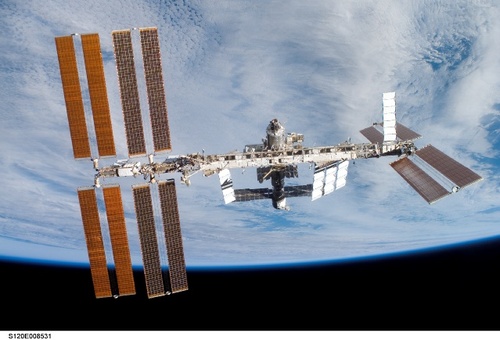
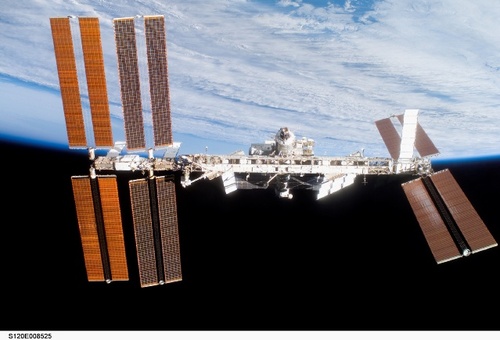
(via NASA Watch)
DinnerTV: Its getting there, the Social API
Posted on Saturday, November 3, 2007
Aka OpenSocial. Below video gives a good intro.
Some news from Zurich
Posted on Monday, October 29, 2007
A presentation I was pointed to: Web2.0 thoughts from Rolf Skyberg, disruptive innovator at eBay.
ESA is taking a leap with this Space & Art exhibition highlighting some of the best artists out there working with space related concepts & technologies:
ARTIST AS SPACE EXPLOREROn the eve of 'Space Exploration - A Global Societal Project', 7-9 November 2007 in Berlin, a special presentation shows why artists, as important opinion formers in society, should be part of the whole picture of exploration.
The exhibition is curated by The Arts Catalyst and presented in collaboration with the European Space Agency and Transmediale, the Berlin-based festival for art and digital culture.
The potential cultural dimension of the European Space Agency's exploration activities is shown here in a group of projects specially devised to accompany Europe's activities in space, collaborating with the European astronauts on the International Space Station, highlighting Europe's ground-based space facilities such as microgravity facilities, mission control and launch sites, and looking towards the future of moon and Mars missions. The projects are designed to have a high profile in the European media and also to show how the world of the arts is engaging seriously with space issues.
The exhibition is one of the more visible outcomes of the ISS Cultural Utilisation study and is being held as part of a large scale International Space Exploration Conference organised by ESA and DLR and taking place in Berlin 8 & 9 November. Looking forward to see the exhibition and meet some of the artists present. Its gonna be interesting to see what Europe has to say about its future in space (update: I just found out that the first European O'Reilly Web2.0 Expo is taking place in Berlin during the same week):
SCOPE & OBJECTIVESIn 2001, space exploration was identified by ESA Member States as one of Europe’s key priorities for the future and the European space exploration programme, Aurora, initiated. In the context of this programme, Europe is planning ahead for the future and developing a long-term strategy for space exploration which provides perspective and orientation for future European investments in space exploration. The underlying principle of the European strategy is to implement space exploration as a global and societal project contributing to societal development. Following this principle the development of the strategy is performed in close consultation with all key stakeholder groups and to this effect ESA has undertaken various stakeholder consultation activities in the last years. The fundamental motivation for an early engagement of stakeholders in the strategy formulation phase is to create the foundation for a sustainable European space exploration programme which creates value for the society. At the time of the International Exploration Conference a first version of the European long-term strategy for space exploration will have been developed. The key objective of this conference is therefore to share with the broader stakeholder community the outcome of consultations and work performed throughout 2006 and 2007.
It will address in particular:
- The broader societal relevance of space exploration based on principles such as inspiration, knowledge, innovation, competitiveness and cultural development.
- Specific European interests and goals and the resulting European long-term scenario for space exploration.
- The international scenario and the importance of broad international coordination of European space exploration activities with existing and new international partners who can contribute to the robustness and cost-effectiveness of the programme.
- The focus of near-and medium term European and international exploration activities and the required means for exploration.
Objectives
- Reaching out to new stakeholder groups, not yet known to the space community, who may not know that they are stakeholders or even beneficiaries of space exploration and vice versa.
- Build a broad support base by creating awareness amongst current and new stakeholders groups.
- Create sustained interest and active support for space exploration as a societal project.
- Target each group with a specific tailored message to enhance understanding on space exploration and why it is important for society at large.
- Encourage continuity in relationships between institutions such as ESA and different stakeholder groups.
DinnerTV: Web2.0 Summit videos
Posted on Friday, October 26, 2007
Another good one, Google, Microsoft and TeleAtlas talking about one of the web's edges, i.e. mapping. Btw, if you experience some problems with scrolling through the videos (which is not allowed!?), you can also subscribe to the videos via iTunes and scroll through them that way.
DinnerTV: 30min. of the Google Guys @ Zeitgeist 2007
Posted on Sunday, October 21, 2007
Zeitgeist 2007 (below is the Youtube video). @ 9:54 Larry Page talks briefly about Google's involvement in the X-Prize, @ 17:32 Esther Dyson hints at inner space (i.e. healthcare) being a more interesting market than outer space:
Outer space is really cool but I am not sure how much Google can do with it.(via SearchEngineLand)
Vint Cerf on the Status of the Interplanetary Internet
Posted on Sunday, October 21, 2007
Found at SpaceDaily:
Internet preparing to go into outer space (nice title!)
After expanding across Earth, the Internet is now set to spread into outer space to reach parts no network has gone before, one of its co-creators predicted Wednesday.
Vinton Cerf said the proposed "interplanetary" Internet would allow people an ability "to access information and to control experiments taking place far away" from Earth.Expanding into the solar system would bring new rules and regulations too, he told an annual Seoul forum, saying he and other experts were working on a set of standards designed to guide space-era Internet communications.
"Finally, the Internet can take us where no network has gone before," said Cerf, who is Google's vice president and chief internet evangelist,
He said he and a team of engineers at the California-based Jet Propulsion Laboratory would complete a key part of the project -- establishing standards for space communications like those for Internet -- in three years.
Cerf told a separate news conference that new standards were needed because of the huge distances and time delays involved in communication across space.
He went on: "This effort is now bearing fruit and is on track to be space qualified and standardized in the 2010 time frame.
"Eventually we will accumulate an interplanetary backbone to assist robotic and manned missions with robust communication."
Sign up now: your 7-day excursion to on the Moon
Posted on Sunday, September 30, 2007
Doing some overdue reading on developments in the space explo arena, I am struck by below slides depicting an assessment of possible Lunar sorties in NASA's latest Lunar Architecture update (Sep'07). They give a pretty good first grasp of the distances involved when future astronauts r gonna have a great time driving around the Lunar surface with their Moon buggies. Looking forward to joining them near real time from behind my computer (with only a 1.5 sec lightspeed delay). Another report text worth a look at is the Global Exploration Strategy (May'07) as it provides an interesting (albeit somewhat romantic) view of space explo in an effort to globally coordinate space exploration agendas into a global exploration strategy. Harnessing the collective space intelligence...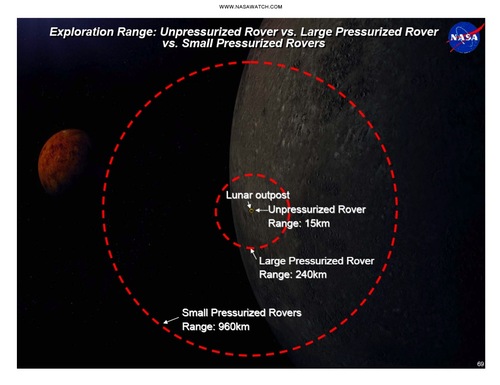 ;br>
;br>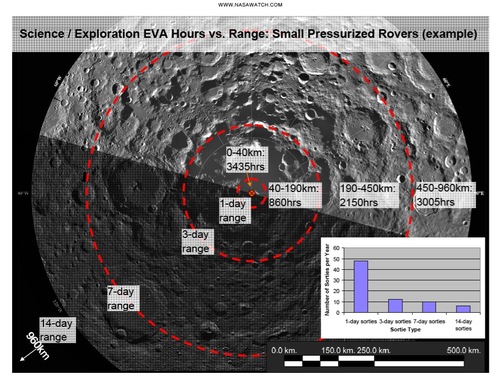
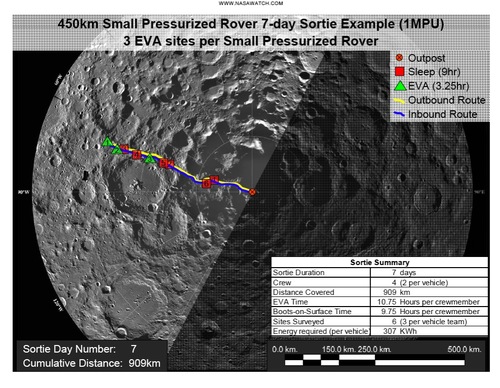
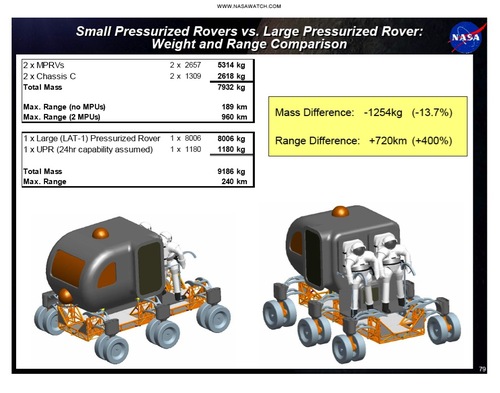
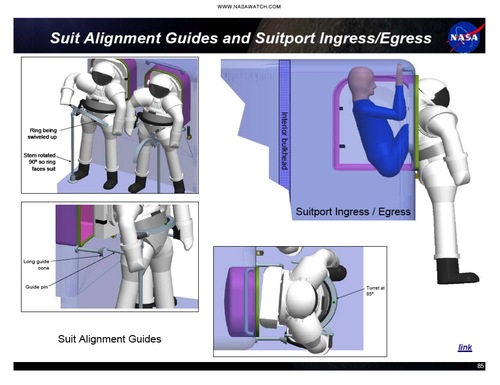
Waiting for Fotino
Posted on Friday, September 28, 2007
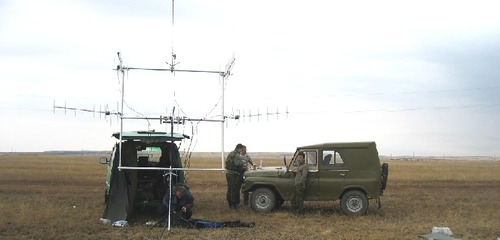
A group of Polish/Russian engineers were installed on the Kazach steppe in anticipation of the Fotino capsule landing. Unfortunately, it never came...
YES2 almost ready for deployment
Posted on Monday, September 24, 2007
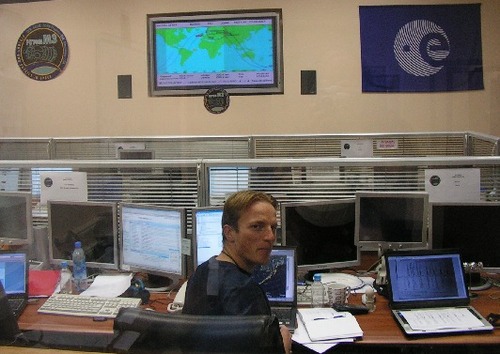
The YES2 mission is almost ready to go. If the temperature lords permit, tomorrow, Tuesday 25th September, the Fotino capsule will be ejected from the Foton spacecraft and with the use of a 30-km tether swung back to the Earth to a targeted landing point somewhere on the steppes of Kazachstan. Follow the news as it seeps in from Moskow Mission Control TsUP at the YES2 mission blog.
Evolutionary benefit from Space Explo
Posted on Thursday, September 20, 2007
Reading up on the Google Lunar X Prize at the BBC I come across this quote from Peter Diamandis, X Prize founder (and ISU founder):
"We are confident that teams from around the world will help develop new robotic and virtual presence technology, which will dramatically reduce the cost of space exploration," said Dr Peter Diamandis, chairman of the X-Prize Foundation in a statement.Working in the space business, one question that keeps me busy these days is trying to understand which of the technologies to be developed for the "space race to come" will influence society on the long run. Computer chips have gained evolutionary benefit from both the military (nuclear missile guidance systems) and the '60 space race (Apollo descent stage). If history accounts for anything, it is pretty clear spin offs from endeavours such as space exploration will play out in society in unexpected ways. With the X-prize's emphasis on robotic exploration and telepresence technologies, I bet you there will be more of this fusing into society in the decades ahead, the question is only how exactly. By the time space exploration gets anywhere, I doubt we will experience the world as we do today.
A launch US style
Posted on Wednesday, September 19, 2007
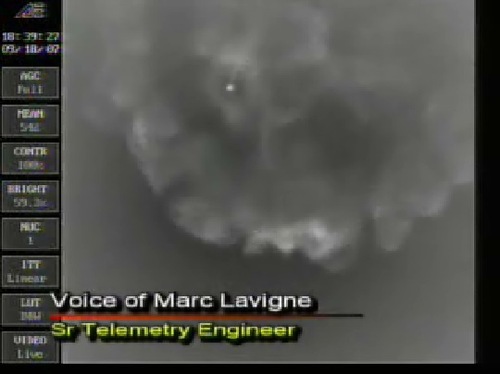
Somewhat different from the YES2 launch (earlier post), this Delta-2 rocket carrying WorldView-1 (soon in a GoogleEarth near you) follows the rocket all the way up to MECO, 2nd stage ignition and fairing separation. Quite an impressive video (via O'Reilly Radar)
Powers of Ten: still your best guide on what's coming
Posted on Tuesday, September 18, 2007
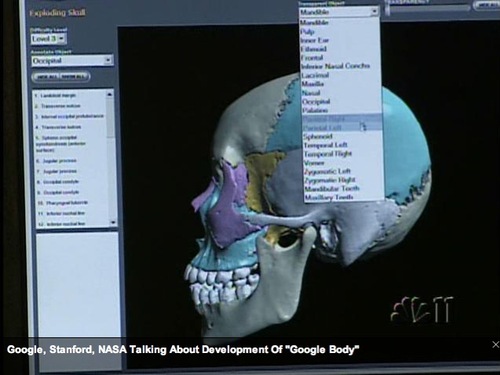
With Google Sky just released, the news of an upcoming Google Body (slideshow) makes me tempted to make a graph with all Powers of Ten from the 1977 movie and see at what level scientific research, government research agenda's and corporate interests are playing out (and not to forget: the military agenda!). Seems this Powers of Ten paradigm (often quoted as inspiration for Google Earth) is still your best bet at trying to understand and predict human progress these days, not only in terms of research but also in terms of accessibility of these non-human scales to average citizens through tools such as Google Earth.
This weekend I had another brief encounter with Google Sky after my initial confusion a few weeks ago from lack of reference while scrolling the skies. This time it was a lot better, although I still think an actual 3D representation, at least of the Solar System, would be way cooler than the MyFirstPlanets representations currently moving around Google's heaven (have you seen the demo tour in Celestia yet?). The current sky implementation feels more like a representation of how old civilisations once thought stars were holes in the black heaven sphere with fire behind it making them shine like they do. Its a good beginning, but they definitely need to catch up with 21st century cosmology.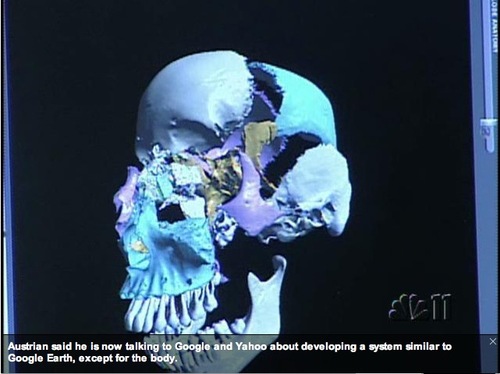
YES2 in orbit
Posted on Friday, September 14, 2007
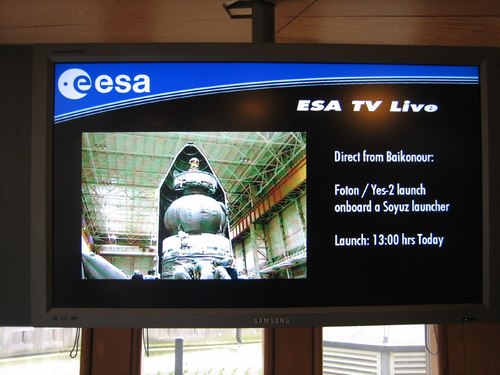
YES2 had a flawless ride to Low Earth Orbit today lifting off from Baikonur Space Center at 13:00 CET sharp (more at ESA's webportal). Back here at ESTEC, a pretty large crowd gathered to witness the launch via a live satellite link. The weird thing with these Russian launches is that they don't have a countdown, so while an ESA official was filling the silence with everybody awaiting the launch, suddenly the rocket engines lit up, the tower cleared away, and the rocket lifted off from the launch pad with a big roar. In less than 3 minutes, the cameras couldn't see the rocket anymore and the only news of a succesful orbit insertion came some 9 minutes after lift-off when a voice over a barely hearable telephone line from TsUP, Moskow Mission control, gave the good news of an all-nominal mission....that was it! Somewhat of an anti climax. But alas, the real YES2 mission will anyway not start before September 24th when the command is issued to release the Fotino capsule from Foton and the 30-km tether will swing the capsule to a targeted landingsite on the Kazach steppe. I hear there is a 'silence' policy over at ESA in terms of covering the actual YES2 mission as it unfolds (after all, it could go wrong...duh!?), so I'll try to give you some updates here and there although its probably gonna be sparse because I am not in the direct loop anymore and I have some other priorities to take care of. The YES2 team will be over at TsUP at the moment supreme so there is always the YES2 blog. Btw, did any of you try to watch the event online? Did it work? I got a message saying the live stream was down before it even started (what's the phrase again '...its no rocket science...!?'). Ps, video of the launch I captured at ESTEC is coming. I am presently in a restaurant in Leiden with a very(!) asynchronous connection (upload very tight), so will do this over the weekend. 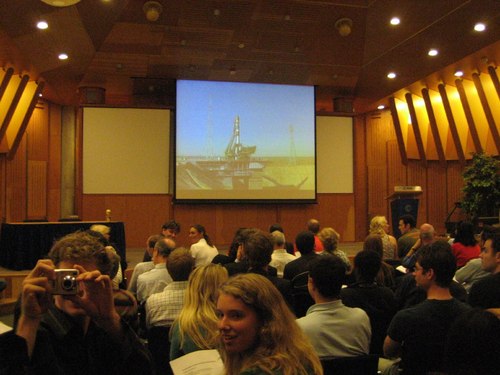
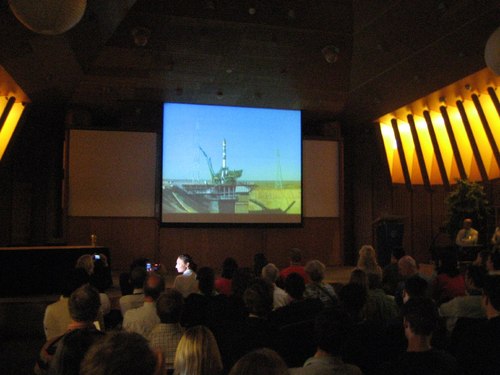
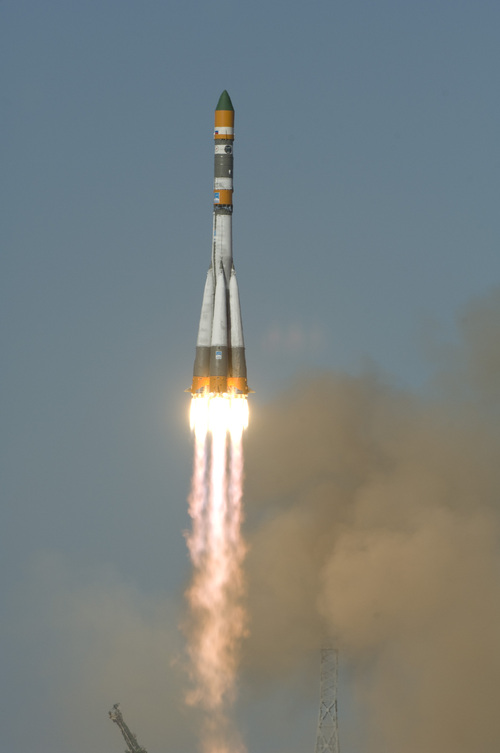
Google + X PRIZE = Lunar X PRIZE + Google Moon
Posted on Thursday, September 13, 2007
Update: more at Wired & CNN.
Just in: Google Sponsors Lunar X PRIZE to Create a Space Race for a New Generation. More at googlelunarxprize.org. At the same time, Google's LatLon blog announces an update to their version of Google Moon, an outcome of the collaboration between Google and NASA Ames.
YES2 ready for launch (oh, and Foton-M3 too ;)
Posted on Thursday, September 13, 2007
Tomorrow (friday 14th) is the big day: YES2 will be launched from Kazachstan onboard a Soyuz rocket. I'll be heading out to ESTEC here in the Netherlands to be part of the official ESA videocast of the launch (too bad I didn't make it out to Kazachstan). Word from Erik@Delta-Utec has it that the launch will also be available through the Internet @ this link. If you really want to get into the spirit, before launch time (around lunch time 13:00 CET, see schedule here) have a look at this splendid YES2-Baikonur photo album by Fabio de Pascale, one of two YES2 engineers on site at the Baikonur space center to witness the launch in person (see here for more good prep images, like the ones below). [below Image Credits: ESA - S. Corvaja 2007]
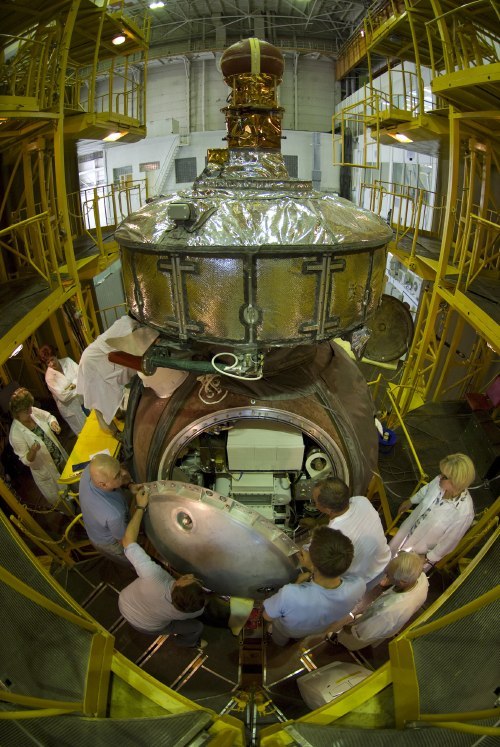
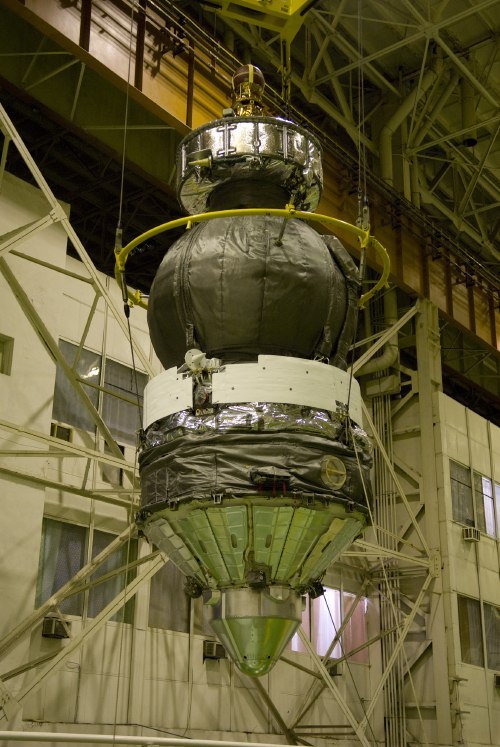
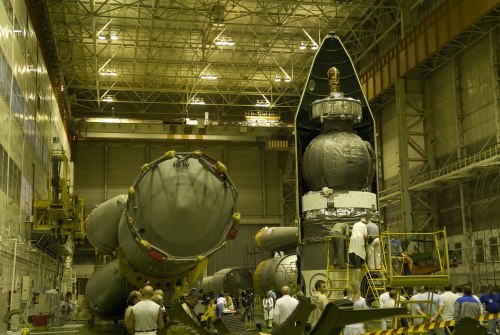
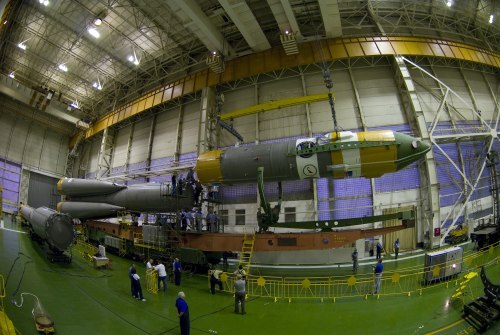
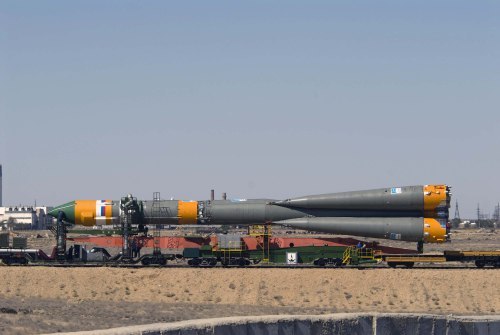
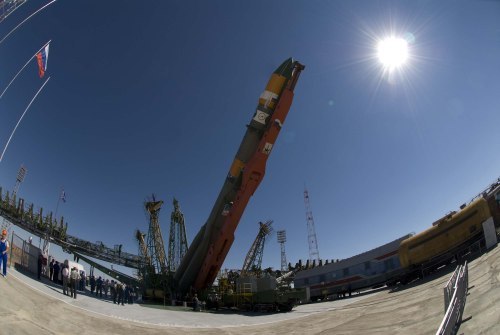
Today's NASA Slogan: All Your Space Are Belong To U.S.
Posted on Sunday, September 9, 2007
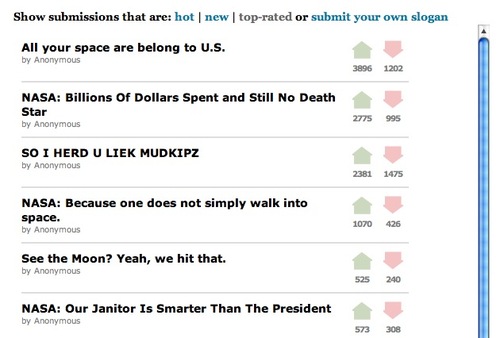
Wired is running a crowdsurfing NASA slogan contest to see if its readers can come up with a better slogan than the recently selected "NASA explores for answers that power our future". Starting out as a gimmicky blogpost (read a long list of proposed-slogans-as-comments here), the large number of entries have moved the contest to a more sophisticated system (the NASA Slogan Reddit Tool!) where people can cast votes on the various entries. Above image shows the top-6 of today, Sunday September 9th 2007.
Sofar, many of the proposed slogans go back to NASA's glorious past, poking fun at present-day achievements. With the CEV vehicle (aka Orion) resembling Apollo all the way down to the parachuted landing (water or land, what does it really matter?), having a slogan referring to the successes of the past seems to me to match NASA's own state of mind (yep, its the the wisdom of crowds allright). In that sense, having a slogan bringing back the glory days of NASA isn't all that far fetched if you ask me...I mean, how inspirational is this graph: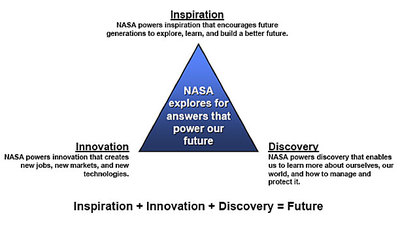
compared to this image: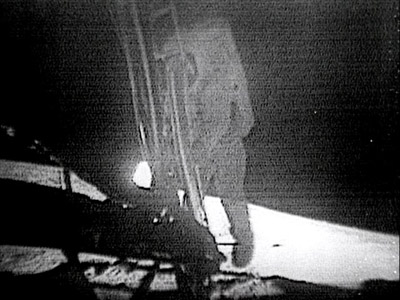
Would be nice to have the WIRED contest run indefinite while NASA's Vision for Space Exploration unfolds, having something like a NASA Slogan Zeitgeist over the coming decades. Btw, if you're interested, some more background information on NASA Strategic Communications can be found in this powerpoint pdf.
Google Earth and Google Sky Currently Don't Connect
Posted on Friday, August 31, 2007
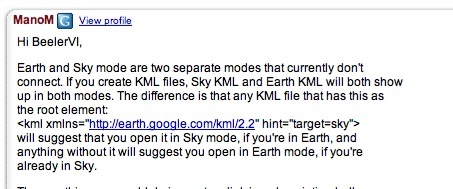
Currently..? Above screendump shows a response by Googler ManoM on the KML Developer pages which caught my eye while doing my weekly checkup on new discussions and topics. Still no time to do a proper scope of all the new stuff that came out with kml2.2 and Google Earth 4.2 but this provides an interesting lead when I'll find that time.
Art2.0?
Posted on Sunday, August 26, 2007

Nice how the EPFL lab below uses above image of Magritte for their lab (aptly named 'pic home.bmp').
Google Turns To The Sky
Posted on Thursday, August 23, 2007
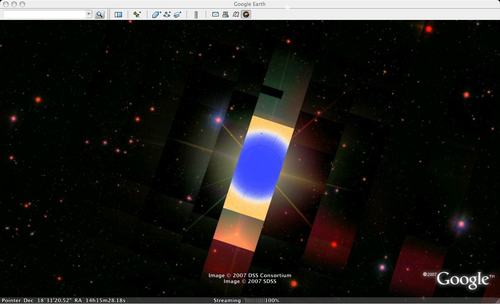
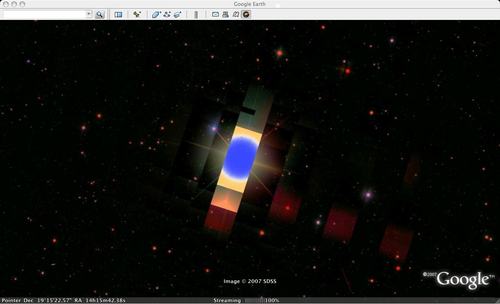
If you haven't heard about Google Sky yet, well, than you're not reading Google LatLon, Google Research blog, the Official Google Blog (that's a lot of Googleblogs...), Google Earth Blog, OgleEarth, BBC NEWS and all the rest of the Blogosphere which has found their way to Google Sky. I'm a bit short on time so I'll just let the others do the first scoop of its features. I plan to come back with some personal insights when I find a chance to spent a good few hours with it. Diving in for the first time, above views I found quite intruiging as a universe kind of equivalent to the patchy Earth that is Google's Earth.
Earth Polar Lander mission
Posted on Thursday, August 9, 2007
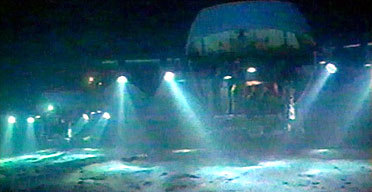
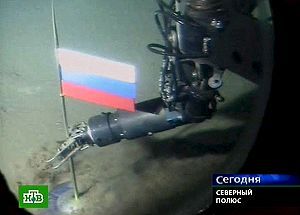
Who'd expected that "exploration" would be taking place so close to home? I know its late in coming, but I just gotta blog/archive this for the shear resemblance of the undertaking to the 'traditional' space paradigm. Just the images are a brilliant PR stunt. Reminds me of the film 'The Wild Blue Yonder' by Werner Herzog.
The Future is Progress, Not a Destination
Posted on Thursday, August 9, 2007
Just got word from my collegue Erik van der Heide over at Delta-Utec that the video of the Foton-M1 launch failure (oct 2002) has been uploaded to Youtube (see below). Don't you just love web2.0 ;) Lets hope Foton-M3 carrying YES2 to orbit has a better faith a month from now.
SciFoo
Posted on Thursday, August 9, 2007
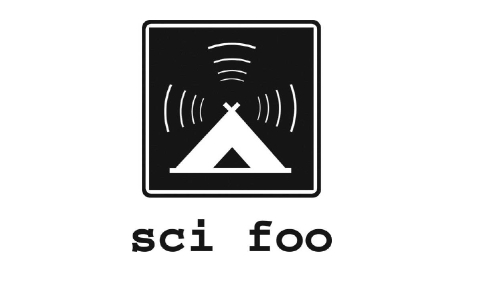
Update from Duncan Hull (keep me posted Duncan!):
There is talk of EuroFoo, probably to be held in Cambridge. There will also be "bar camps" again, in Cambridge and soon in Manchester.
Man, I wish they'd bring SciFoo over to Europe, how cool is this ? To get a taste, have a look at this Flickr series ! Maybe a SpaceFoo? Probably a bit too exciting for ESA, but ISU perhaps?
NASA and Microsoft: Photosynth Exploration
Posted on Monday, August 6, 2007
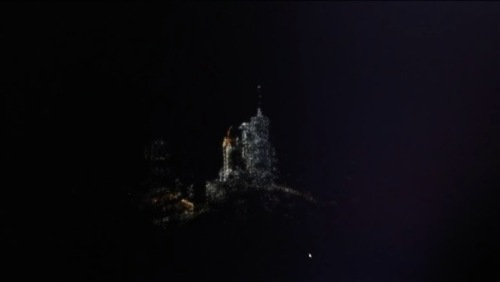
Just in (and spreading on the Internet like a wildfire, like here, here, here and even here): NASA & Microsoft collaborate by making available a Photosynth environment of the Shuttle launch pad at the Cape. Beautiful job!! (its only viewable on XP SP2 or Vista, but for Mac users there is at least a video to see what they are missing ;)
I remember posting a remark on the Photosynth website once suggesting they'd make a Photosynth environment of all Earth photos taken from space, but I wonder whether that is actually feasible given de lack of depth of these images and the changing weather patterns.
Btw, in case you're interested, here's a 58min GoogleVideo going into some of the details of a tool like Photosynth, except this one is not Photosynth but Photosketch (via).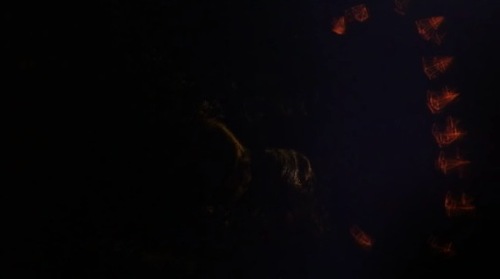
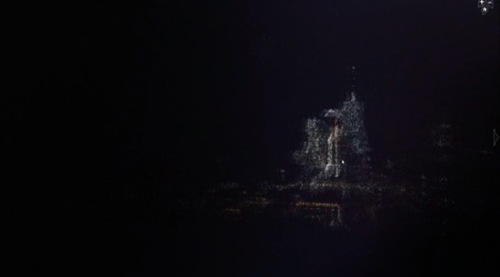
DinnerTV: Vint Cerf on the architecture of the coming Geoweb
Posted on Monday, August 6, 2007
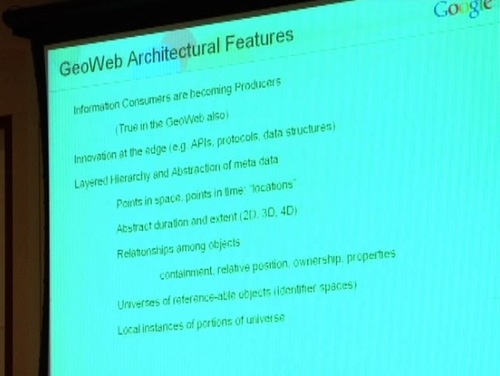
Thought provoking videos have come from the Geoweb2007 conference in Vancouver end of July (via). My shortlist:
Vint Cerf (a must-see)
Jack Dangermond (fresh view for me)
Michael Jones (always interesting)
I was especially struck by the conceptual insights of Vint Cerf where it comes to the architectural design of something as intangible as the virtual Geoweb. And of course his opening remarks to keep the Geoweb conceptually open for the eventual SolarSystemweb are music to my ears ;) Quote of the day comes from Michael Jones:
A map has become a searchable information landscape
RocketCam
Posted on Friday, August 3, 2007
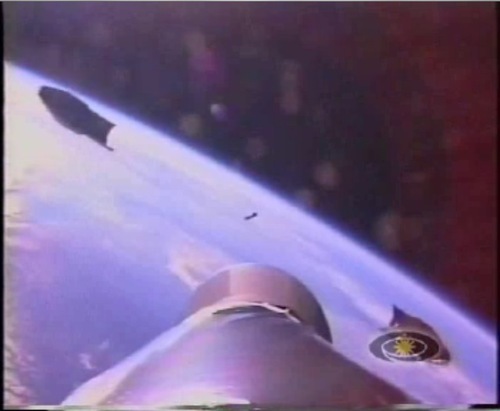
Another interesting 10-year anniversary: RocketCam (SpaceDaily post). Brilliant stuff (check this video!). Around the same time as Mars Pathfinder (earlier post), didn't know, but both firsts got me started on the space explo - cyberspace thing. Its the media stupid! Funny how nowadays everybody is zooming into the Earth from space, while these fragile rockets are trying to escape it...
Northern lights in Google Earth
Posted on Thursday, July 26, 2007
My Spanish ain't what it used to be and I can't seem to find a kml/kmz file for it (its available at the blue GE button on the bottom of the post), but this seems to be a neat cyberspace-outerspace mashup: Aurora Borealis in Google Earth.
See the video here below:
While I was away
Posted on Wednesday, July 11, 2007
Been to Transformers earlier this week. Great visuals, poor screenplay. One thing was pretty funny. Where Europe mourned the loss of its Beagle2 lander (it was after all a UK lander on an ESA spacecraft), this movie simply infuses the meme that Beagle2 was actually a NASA lander (a rover at that!) which wasn't lost at all, it just brought back some cosmic top secret imagery of Decepticons rooming the red planet. Who said ESA has a PR problem? Check out above video for some serious transformer action.
What's to come...
Posted on Tuesday, July 10, 2007
Going through my RSS feeds today, I found an interesting quote from Jessy Cowan-Sharp, technical platform manager for the Ames CoLab effort, about NASA's move into virtual worlds such as Second Life:
...virtual worlds are "the seed of something that's going to be one of the major transformational technologies of our species."I couldn't agree more. Read the whole story at SpaceDaily.
Where do you NOT want to go today?
Posted on Thursday, July 5, 2007

Don't think windows is quite ready yet to get us into outer space ;) The same thing I have seen several times on LCD screens in the public transport here in Amsterdam...nothing more telling than an ad space crashing like that...you just want to press that OK button and get on with...(via edparsons.com)
Happy Birthday Pathfinder
Posted on Wednesday, July 4, 2007
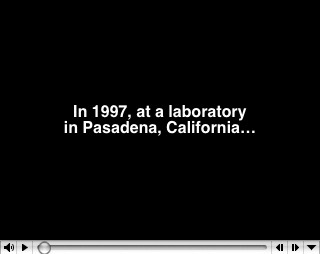
Wow, 10 years ago already. Almost forgot Mars Pathfinder landed on the 4th of July. Seeing the images over a 33k6 modem back then sure was a good inspiration while studying aerospace engineering. When I think of it, it actually got me into the direction which, 10 years later, resulted in the theme of this blog:
A blog about outer space, cyberspace, their common future, and all that is leading up to it...
Virtual Worlds Presentation by Mitch Kapor
Posted on Tuesday, July 3, 2007
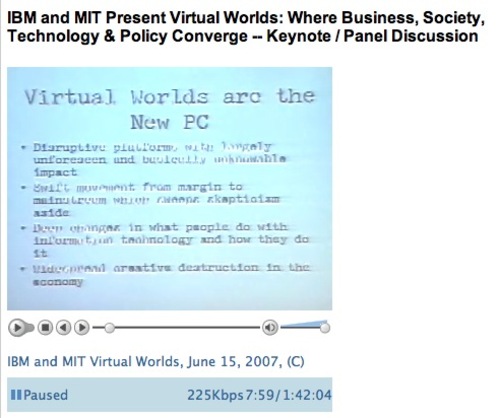
Over the weekend I stumbled on this 1:42:04 video of Mitch Kapor (of Lotus fame and an early investor in SecondLife) giving a presentation and leading a panel at the MIT Virtual Worlds laboratory June 15 (just 2 weeks ago!). Interesting watch/listen! I am still a bit skeptical about all this virtual world stuff, but like he says, this seems more to do with the feeling of knowing there is something going on but that its hard to articulate what it exactly is. For everybody interested in getting a good introduction about virtual worlds, do watch/listen the whole video.
The panel discussion is also worth noting. I especially like the comment by Robert Gehorsham (with Forterra) at 1:22:23 into the video about the self-imposed limitation of 'only' rebuilding real3D into a virtual platform. Somebody throws in: 'locked into assumptions'. Good point. Lets use virtual worlds to flex our limits within the Powers Of Ten, not stick with the human scale only (there is enough of that around already). Here are two other interesting scribbles from watching the video: reality acquisition devices & ROI on mystical experiences. And not to forget, the quote of the day: Please don't metaphor me in!. Btw, there is a new 6min talk by MS Virtual Earth PM over at TED.com
Bill Stone @ TED2007
Posted on Tuesday, July 3, 2007
For once somebody makes a case for space exploration not needing the immediate reaction: 'please don't metaphor me in!' (his timescale seems to be off by a couple of decades though):
Embedding doesn't seem to work, so best place to watch the video is over at TED.com.
Once you finish, have a look at this one by Kevin Kelly, it's more abstract, but probably also all the more fascinating.
Astronaut2.0
Posted on Friday, June 29, 2007
Here is a nice CNET article about the participatory exploration initiatives taking hold at Nasa Ames. Opening statement:
MOUNTAIN VIEW, Calif.--NASA astronauts "twittering" from the moon?
It's not such a far-fetched idea, considering the space agency's current push to partner with Web 2.0 companies like Twitter and save itself from turning into a dinosaur in the Internet age. Some executives at the struggling NASA believe that if the agency can adopt Web technologies like Twitter--a social network for broadcasting thoughts online or via text message--then kids and the general public will be more connected to space exploration and inspired to learn about science.
"How can NASA become hip?" NASA CoLab Project Manager Robert Schingler asked here Tuesday at NASA's Ames Research Center. "For me, it's allowing other individuals (and companies) to participate in the program."
Where does that leave the robotic exploration? I hope these satellites will be keeping a blog anytime soon ;) (earlier post).
The ISS from the ground
Posted on Thursday, June 28, 2007

The Shuttle and ISS docked together as seen from 190 nautical miles (via NASA Watch)
Human-Machine-Nature interfaces
Posted on Monday, June 25, 2007
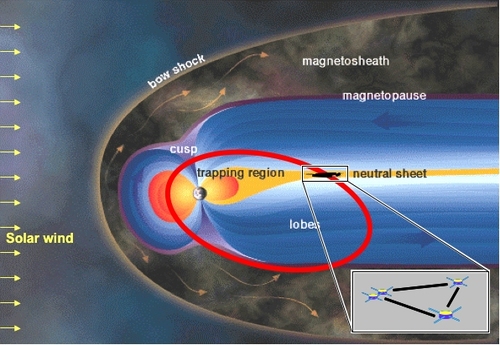
Quite some news recently about human-machine interfaces coming out. In particular the non-intrusive ones like this collaboration between Graz and University of London (check out this video ;). Not related, but OgleEarth is back at blogging, and he brings back some cool footage from ISDE5. Like he says, a possible hint at where things might be going with digital globes. Now what i'd like to see is a near real time vis of the Cluster data in one of these domes...magnetosphere storms as they happen...These four ESA satellites are up there now, so how difficult could that be?
Oh, and a quick note about an interesting conference coming up:
- The 11th International Conference on Information Visualisation from 2-6 July, interconnected with this Vizualisation summit
API IPO
Posted on Friday, June 15, 2007
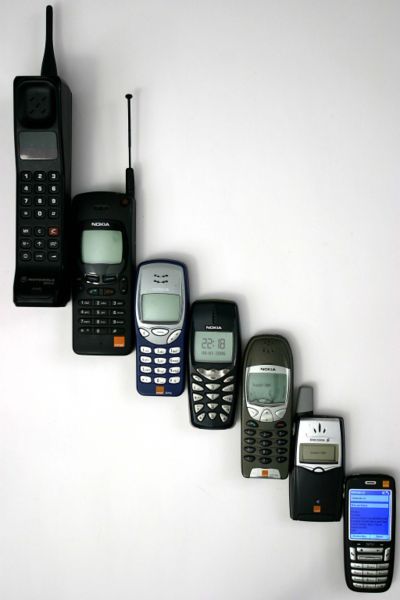
Looking at Google Earth again, I wonder if there is a Google Analytics API? If you can build on Facebook via an API (ie. use its social network database), I am sure you can build on an API of a statistics system. And while we are at it, why not then combine the Google Analytics API with the Google Earth API into a direct Google Analytics2Earth API. Realtime GIS...The only thing to wait for then is some good Google online identity in our hands...(combining a video at OgleEarth with this hint to a Google Books2Earth API). Its funny how they use phones in The Matrix ;)

ISS & Time...
Posted on Friday, June 15, 2007
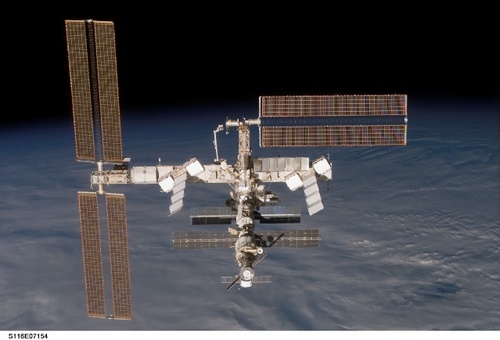
Wow....!! What a rant following a story about the ISS almost becoming a robotic (ie no-humans-to-take-care-of-it-in-space) spacecraft (via NASA Watch).
NewSpace
Posted on Thursday, June 14, 2007
Slightly off topic, but an interesting discussion is taking place about the realism of NewSpace. For more, read the post and comments at this blog. Here is an interesting excerpt of a comment by original post author David S.F. Portree:
Part of my caution about NewSpace is based on my belief that it threatens to distract from serious space exploration. It could reinforce in people the notion that space is supposed to generate tangible, direct, monetary profits, when in fact it can’t really do that. I don’t want people to come to believe that, if space exploration doesn’t make money, then it’s not worth doing.:) pretty much to the point...I’ve talked with NewSpace people who say exactly that. Not top-level investors, but people on the periphery, like Keith. One person with whom I discussed all this told me that life on Mars didn’t matter unless it could generate profits. He mentioned selling martian life as food on Earth.
Just in: Astrium goes into space tourism
Posted on Wednesday, June 13, 2007
Update: More at NASAwatch, including a sleak video with a silly tune.
Thinking about the advances it will help to develop leading to point-to-point transportation, it makes sense. But EADS Astrium...? Here is a quote from the BBC story:
"It will be amazing. You'll actually be outside the Earth's atmosphere; you'll be able to see Earth as a spherical object and everything else around you will be black. There must be millions of people who have dreamt about this since they were little kids,; he told the BBC.EADS Astrium says its space jet project is likely to cost a billion euros to develop. It will be looking for financial and industrial partners over the next year. It says that if development work starts in 2008, the first commercial flights could be made in 2012.
"The development of a new vehicle able to operate in altitudes between aircraft (20km) and below satellites (200km) could well be a precursor for rapid transport, point-to-point vehicles, or quick access to space," Astrium said in a statement.
"Its development will contribute to maintaining and even enhancing European competencies in core technologies for space transportation."
Hop aboard LCROSS
Posted on Wednesday, June 13, 2007
Following up on Pete Worden's talk through Second Life linked to below, here are two KQED videos I found (1, 2) which shed some light on the LCROSS mission to be launched October next year. According to Pete's remarks in the presentation, this is the mission which should allow people to virtually fly along to the Moon.
The first video is an animation which details the complete mission scenario, including the LRO mission scenario to be launched in parallel with the LCROSS spacecraft. What's interesting about the LCROSS mission scenario on first sight is that it includes an 80-day period in which it orbits the Earth at Moon's distance in order to synchronise its impact point on the Lunar surface at minimum fuel cost. Turns out this is very much the same as a mission I once worked on called LunarSat which used a Weak Stability Boundary orbit to do more or less the same (except for impacting). Would be cool to have the camera beaming down a continuous stream of Earth looking images during this period (like EarthViews was designed to do for LunarSat).
Taking Pete's talk into consideration, I am sure they are working on that right now, which makes me wonder through what interface they are planning to show these images? Seems to me a virtual globe like Google Earth is perfectly suited for this. You'd get something of a 'photosynth' of the Earth through robotic satellite means ;)
SimonPete Raymaker and other 2nd Life news
Posted on Monday, June 11, 2007
Coming back to Amsterdam after a long-deserved couple of days holiday at the beach in Knokke (.kmz), here is a brief overview of some interesting stories (IMHO):
- NASA Ames Director Pete Worden presents to the International Space Development Conference via Second Life. Now here is a retired US General who definitely gets it ;) A lot of interesting stuff is originating from Ames since he became center director (e.g. Google NASA partnership, NASA CoLab, Yuri's night @ Ames), and listening to this talk I am sure there is lots more coming!
- Following the Second Life meme, this is one of the most intruiging pieces of Second Life coverage I have seen sofar. Its the established political scene in Sweden getting introduced to a 21st century technology, including the cutting of a digital ribbon (well, sort of...;) OgleEarth has (a lot) more on the story (he was the cameraman).
- Something I noticed myself a week or so ago, and after reading this post, was reminded about it again: the stars seem to be moving in Google Earth. Is this the start of something new?
Light posting ahead
Posted on Saturday, May 12, 2007
Haven't been very active on this blog lately, which is mainly due to my full focus on the development of my UGO project, making me less susceptible to reading my section of the blogosphere on all the news coming out on a daily basis. I haven't finished my first build yet, so this light posting will likely continue for the coming days/weeks untill I finalise a first UGO app. In the meantime, some interesting developments worth noting:
- Search Engine Land (definitely a good read)
- a joke
- Anil Dash post
- News.com
And of course there is the news of a new WorldWind JAVA release.
One of these weeks...
Posted on Friday, May 4, 2007
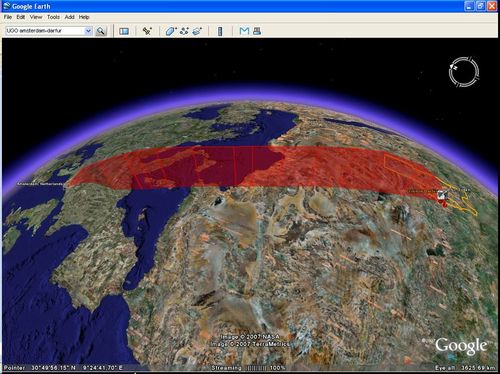
One thing that has intrigued me for some time is the possibility to visualise my flightpath while surfing around in Google Earth. With a background in aerospace engineering, I guess the idea of orbiting the Earth comes somewhat natural to me (at least in spirit), and I have always found it striking that the movement of navigating Google Earth resembles the path of spaceflight hardware, be it rocket launches, ICBMs, re-entry capsules, Low Earth orbiting satellites, the ISS, basically anything space related (near Earth). This is also the reason why I started experimenting with my little python script (earlier post). Being somewhat of a mac guy, the fact that I was coding python to interface with the Google Earth COM API (only available in windows) kind of felt akward because it would not allow me to implement my idea as a cross platform tool. Untill the cross-platform GE Sharing showed me the way...
The last few weeks were one of these weeks where everything seemed to come together in that respect. First there was the introduction of the Darfur layer in Google Earth on April 10th (an eye opener!), followed about a week later with the introduction of the GE-sharing application. Following my somewhat premature comment on the Darfur implementation (good point OgleEarth), and OgleEarth's comment on my little python visualisation script, I figured it was time to put my mouth where my money is.
So, to put a long story short, I basically started a 2-week coding trip (lots of pizza, little sleep), working my way through CGI programming, python, KML, and server-client architecture, aiming to put my python script to use in a similar fashion as had been done so cleverly by the GE Sharing guys. But just when I thought I was closing in on it last weekend, I ran into some issues (both KML/networklink related and python related) which made me come to a somewhat unanticipated halt...
Nevertheless, even though my objective of a cross platform Google Earth visualisation tool has not materialised (yet!), I have been having a lot of fun flying around in Google Earth, testing my algorithms, visualising a lot of different flightpaths, and learning about the nitty gritty details of coding python, KML and cgi by trial and error. Along the way I have collected a wide variety of screendumps logging my progress, and I like these images already well enough to wanting to share them. So with my aim to continue the development of my little app (which I dubbed 'UGO', for 'User Generated Orbit'), I started a new blog called UGO where I will post some of the progress I made sofar and will keep on posting my progress towards this goal.
ps. Following up on my comment v.v. Darfur (earlier post), one of the other ideas that came to mind about how to harnass the collective outcry would be for people to use something like my little app to upload their personal 'Darfur UGO' and then aggregrate them all into one big Darfur layer, showing our concern the 'Google Earth way' ;) Here is mine already: kmz file.
Updated blog feed
Posted on Tuesday, May 1, 2007
Mmm, turns out I already had a FeedBurner account with several subscribed readers to this blog (re: earlier post). Strange how things like feeds can get this complicated...;) Anyway, to keep things organised I decided to delete the new account and merge its feed with the already existing one. For those of you who subscribed to the new one in recent weeks, please visit my blog's webpage and (re)-subscribe one more time to the FeedBurner link on the right.
To check if you have the correct feed, the correct FeedBurner account should now have the following URL: http://feeds.feedburner.com/tobedetermined (for Safari on OSX this should read: feed://feeds.feedburner.com/tobedetermined)
Thanx again...
FBTO gives its roof a paint job
Posted on Wednesday, April 4, 2007

Dutch insurance company FBTO took no risk and painted its corporate logo on its roof to show up in the next update of Google Earth (Via MarketingFacts, in Dutch). Here is a video entitled 'Google Kijkt Mee (Google Watches Along)' where FBTO marketing manager Paul Koopman explains the why and how (in Dutch). Wouldn't it be handy if Google had a listing online of its planned database updates, just like they did earlier this year down under. I have a pretty large roof myself, which I wouldn't mind decorating if only I knew when to do it.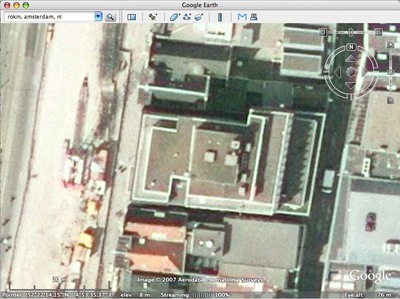
NASA budgets for development of MMO & Worldspaceparty
Posted on Tuesday, March 27, 2007
Another example of 'NASA gets it...the others follow': NASA moving into virtual world development:
To successfully advance the Vision for Space Exploration (VSE), NASA is continually refocusing and streamlining its organization, realigning ongoing programs, and tapping the innovative talents of our nation. To accomplish the VSE goals of returning to the moon and going beyond to Mars, NASA must find ways to enhanced science, technology, engineering and mathematics (STEM) education. This intramural call for proposal ideas seeks to develop a persistent, online, synthetic environment that will support NASA's STEM education goals and allow millions more American to share in the experience of NASA science and exploration virtually.Read more about this particular solicitation (16-page pdf) at 3pointD.com (the call seems to have been postponed). Seems to follows neatly along the lines of a NASA activity that has already been going on for some time: NASA CoLab:
NASA CoLab is a Collaborative Space Exploration Lab being developed at NASA. CoLab will provide a framework for exciting partnership projects between the nation’s space program and the thriving technology-entrepreneurial community. In addition to the benefits to collaborating with intellectual assets of the technology business sector, the general public will benefit through various projects supporting the NASA’s goals. CoLab will feature a physical space in downtown San Francisco, a collaborative online space where scientists and engineers from NASA will collaborate with the entrepreneurial technology community, and a space in “Second Life”, a virtual learning community with interactive content.This also reminds me: forget Easter, its WorldSpaceParty time. Some of the people I met while over in Cupertino are taking part in the organisation of this once in a lifetime party commemorating the 50th anniversary of the Sputnik launch, while at the same time celebrating the annual Yuri's night which is held all over the globe. Located in a hanger on NASA Ames premises, the event includes amongst others a concert by Plaid (enough reason already to go over there) and also hosts several space art exhibitions. In case you can't make it over to California, there is always the opportunity to visit the party through your second life ;)
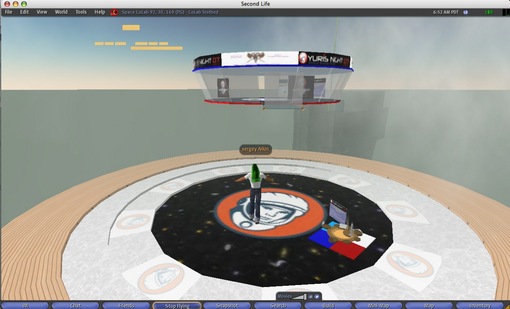
Click to enlarge
FeedBurner goes outer space...
Posted on Tuesday, March 27, 2007
Finally...where can I sign up for a feed from the Mars Exploration Rovers or, say, the International Space Station?
A couple of months ago I stumbled upon this ad by FeedBurner which I found kind of intruiging. Thinking about the convergence of user generated content, games like Spore, collective intelligence, NASA teaming up with Google, Google Earth becoming more mainstream, locative media art, blogjects, my project with Jeremy hight 'Floating points', The Internet of Things, advertisements 'in space' and satellites as blogging objects, it seemed they tapped into the right kind of nerve with this particular add. There won't be anybody blogging from Jupiter anytime soon, but considering that satellites have been blogging since the early days of Sputnik (audio), the idea of the blogosphere moving into outer space doesn't strike me as all too crazy (let alone the advertising dollars). The main question that strikes me is: what would somebody something near Jupiter blog about? Any thoughts?
(note: the above flash file was kindly provided to me by FeedBurner after some back and forth communication on my request to host the ad on my blog. Sofar, I haven't been able to make the click-through URL for this particular ad work, so in return I am happy to host their FeedBurner ads URL. Thanks Jessica.)
Falcon 1
Posted on Thursday, March 22, 2007
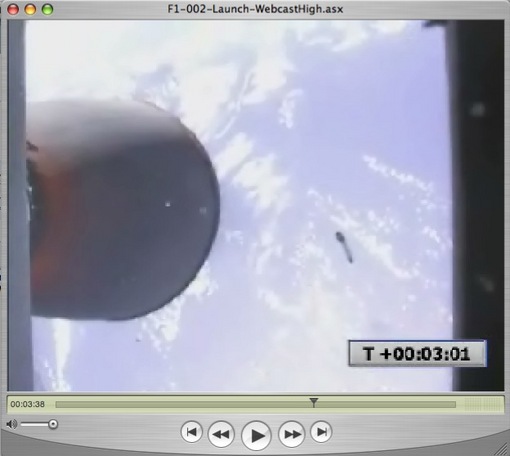
Another beautiful launch video, this one's from last monday's SpaceX's Falcon-1 launch
Mars flyovers
Posted on Saturday, March 17, 2007
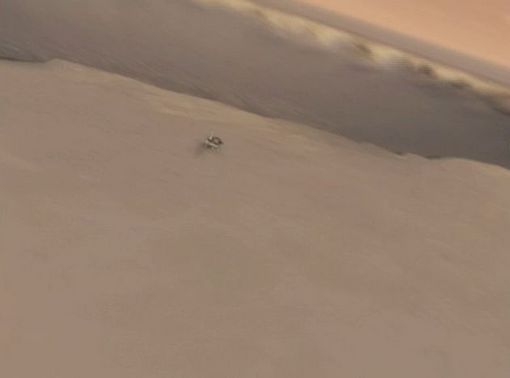
Two impressive Mars flyover videos were released last week by NASA, one for each of the two rovers Spirit and Opportunity (via Nasa Watch). If this technology is available on the MRO satellite, I wonder what is possible with this technology for Earth orbiting satellites.
Flying to the moon
Posted on Saturday, March 17, 2007
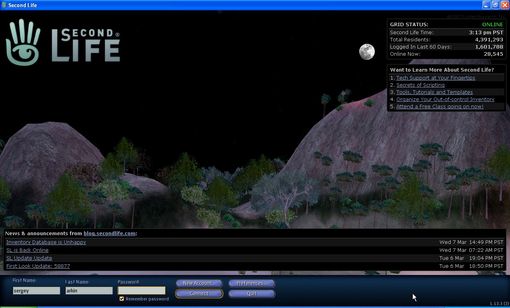
Click to enlarge
Still trying to get back into Second Life after I lost my password...the help line doesn't do much...let alone trying to get a new free login...hope they solve their my problem before NASA gets back to the Moon in First Life.
Dropping the bomb
Posted on Monday, March 12, 2007
One of the nice extra's of working in the space sector (and currently collaborating with Russian Submarine Launched Ballistic Missile (SLBM) designer SRC Makeev) is the opportunity to sometimes get a little sneak preview into the Russian industrial military complex. One of my collegues from Samara recently wrote me an email announcing his absense in our collaboration because he was going to a conference in a higly secretive town called Sarov:
Yes, I'm back from Sarov, one of the "mail boxes" (i.e. closed secret towns). When I say closed I meen that it's really closed - the whole town is surrounded by fence, with only few check-points. You need a special permission to enter and also another permission to leave! Foreigners should apply 3 months before visit.
In Sarov he managed to visit the Nuclear Weapons museum. All items in below photo are nuclear warheads, with a particularly large one in the back. The second photo shows my collegue in front of the worlds largest fusion bomb. I don't know, but it has a weird kind of 'Tintin' or 'Melies' feel to it. Imagine dropping a bomb like that...
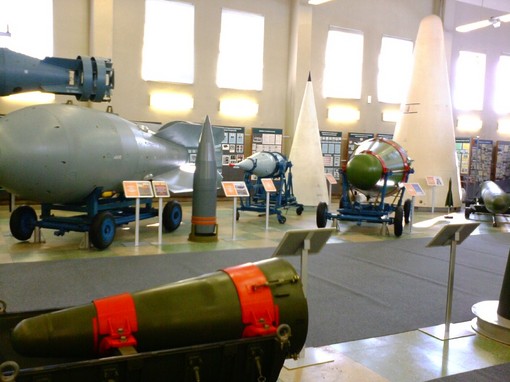
Click to enlarge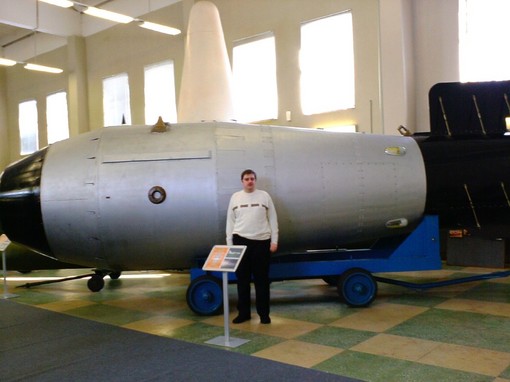
Click to enlarge
O'Reilly Radar on space
Posted on Monday, March 5, 2007
Some space related blogposting at one of my favorite blogs O'Reilly Radar:
The Earth pulse
Posted on Monday, March 5, 2007
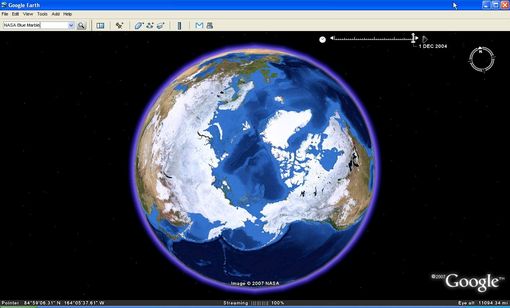
Its not my normal routine to blog about Google Earth kml files. For one because Google Earth Blog and OgleEarth do a much better job than I ever could, and (2) because there are so many being released these days that it is hard to keep up (don't want to end up in the categories section of the geographic web...and now with kml search, that's no longer needed anyway).
This one I have to blog though. Reading through the kml specifications, I came across this time-lapsed serie ![]() of NASA Blue Marble imagery. Still puzzling over the idea of 'pattern recognition' as prophetised by Jeff Hawkins of Numenta (previous tbd post ::: just found out they released their first release of the Numenta platform for Intelligent Computing (NuPIC)), this serie of images displaying the appearance of the Earth through 1 orbit around the Sun gives food for some good pattern recognition thought. See for example the pulsating ice sheet coverage as seen from the North Pole (image above). Its quite extraordinary that everybody running a computer and an internet connection these days can have a look at these out-of-this-world patterns. And this is only just the beginning. Anytime soon now, we can all have a go at making our own personalised 'unconvenient truth' documentary ;)
of NASA Blue Marble imagery. Still puzzling over the idea of 'pattern recognition' as prophetised by Jeff Hawkins of Numenta (previous tbd post ::: just found out they released their first release of the Numenta platform for Intelligent Computing (NuPIC)), this serie of images displaying the appearance of the Earth through 1 orbit around the Sun gives food for some good pattern recognition thought. See for example the pulsating ice sheet coverage as seen from the North Pole (image above). Its quite extraordinary that everybody running a computer and an internet connection these days can have a look at these out-of-this-world patterns. And this is only just the beginning. Anytime soon now, we can all have a go at making our own personalised 'unconvenient truth' documentary ;)
Germany to the Moon
Posted on Sunday, March 4, 2007
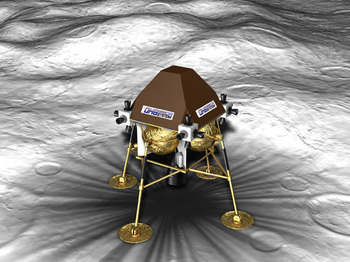
OHB System seems to have some good lobbyists in the German parliament (FT article in German). Here are some more computer renderings of the system.
Uh, what's up doc?
Posted on Friday, March 2, 2007
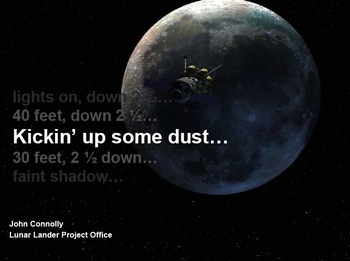
Nasa Watch has a link to a presentation by John Connelly (Lunar Lander Project Office) about the current status of the US plans to go back to the Moon. Brings back memories of Euromoon2000 (below), my initiation in the inner workings of the European Space Agency. Goes to show (again) that the right timing is an essential ingredient for success. Wubbo Ockels's vision was right on the money, just about a decade early...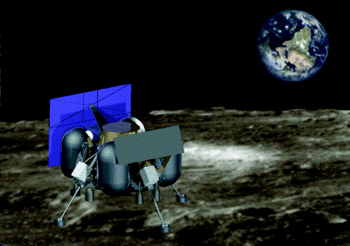
traceroute Rosetta
Posted on Tuesday, February 27, 2007
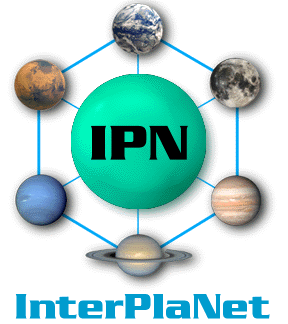
Related to my previous post on Rosetta's view of Mars, I just read on Slashdot about the plan Vint Cerf is working on to expand the Internet into the Solar System:
Communication between a rover operator on Earth and a rover on Mars, via a relay orbiter, can't use standard Internet protocols end-to-end. That problem is at the root of a lot of the design work we're doing for the IPN... As part of the NASA Mars mission programme, the project aims to have by 2008 a well-functioning Earth-Mars network.An excellent read I must say, the Slashdot discussion, especially because only at the very bottom of the page does it actually start talking sense, the rest is just geeks getting off on geekjokes. Thought this one was quite to the point:
Parts of this planet we live on don't even have access to a broadband Internet connection, and now they want to plug Mars on the network? Talk about priorities...But then again:
parts of this planet are even more worthless than the lifeless Mars. Leave the stragglers behind..keep pushing forward. -they don't call it the human race for nothing
The idea to expand IP into the Solar System has been around for a while, and to me it obviously makes perfect sense. Evolution you might say. It has been working in Low Earth Orbit onboard an SSTL satellite for quite a while already (video @ Cisco), and Cisco is seriously interested to get deeper into the game.
KML search capability: hurricane+katrina
Posted on Tuesday, February 20, 2007
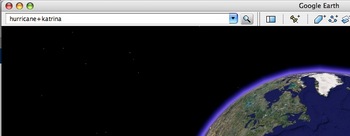
Click to enlarge
OgleEarth and Directions Magazine have the news of a KML search capability recently announced by Google on their maps API blog.
Leaving the discussion on the licensing of Google Earth @ work for a moment, here is an intruiging thought I like from Allen Doyle discussing the release:
But, hey! It's a start. The buzz is there. It's easy to post KML files. How hard would it be to post the entire metadata holdings of a large geospatial data provider like NASA or NOAA in KML? I bet a service like GCMD could post theirs in a week. At Where 2.0, we could be watching demos of Google Earth finding, and displaying, realtime remote sensing data.Makes me wonder what an HTM would have to say about the patterns?
Btw, below is what Google Earth now comes up with searching for 'hurricane+katrina'. Fairfield Inn by Marriot? Not exactly what I was looking for...although...mmm, maybe...if it were realtime data ;)
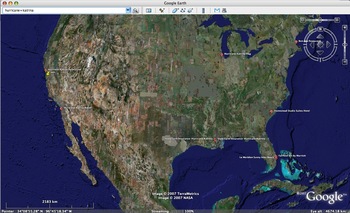
Click to enlarge
Mars rovers on Earth
Posted on Tuesday, February 20, 2007
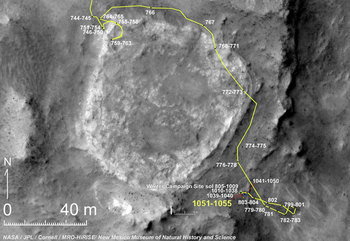
Click to enlarge
Thinking about a project by c5 I read about in Jeremy Hight's text on Floating Points:
Now groups such as the C5 collective are doing work such as the GPS mapping of the entire great wall of china and then placing the coordinates in another location. This type of work creates a layered commentary and plays with form and semiotics as well as referencing the Situationists who developed absurd commentaries like a walk through the streets of Paris following a map of another city.
I had an idea: lets digitally translate the trajectories of the 2 Mars rovers to a suitable location on (Google) Earth.
On Intelligence
Posted on Sunday, February 18, 2007

Every now and then I gather a list of books I come across while doing research on the Net and order them via Amazon. The latest batch included a book called 'On Intelligence' by Jeff Hawkins, published in autumn 2004 (Amazon). I started to read it a couple of days ago and it completely captured my imagination. Finished it in 3 reads. If you are interested in state-of-the-art thinking on how the brain conjures up something like intelligence, and how this could potentially be implemented in machines, this is it.
Some of the most thought provoking points for me stem from his discussion on the potential of an Artificial Intelligence (AI) intelligent machine, or HTM (Hierarchical Temporal Memory) as he calls his model (.ppt), to make sense of the world through some as yet undefined exotic senses. For example, if he is right that the neocortex basically works on patterns, an intelligent machine based on HTM can learn to make sense of (and predict) global weather patterns using as exotic sense a widely distributed sensor web. Basically, any pattern can be used in this sense, be it Google user statistics, stock market fluctuations, satellites studying Solar Weather, genetic sequencing, hell, even the web itself is probably one big pattern if you have the right senses for it...we could be in for some pretty unexpected extensions of our reality, if we know how to translate them back to our human senses that is...
Doing some further background reading, I came across a couple of interesting video presentations by Jeff on his theory, potential applications and his future plans. In addition, I found this remarkably recent (feb '07) Business2.0 article on his current whereabouts at Numenta, the for-profit company he spun off from the Redwood Center for Theoretical Neuroscience to implement the model he described in his book 2 years ago. And here is a recent Science article about the same topic (Oct. '06).
- Jeff Hawkins presentation at the 2005 MIT Emerging Technologies conference (48 min.)
- Jeff Hawkins presentation 'How the cortex works' (Sep. '05, 54 min.)
- Jeff Hawkins presentation at IBM Almaden Institute (May '06, 64 min.)
- Business2.0 blogpost with brief video interview
Perspectives
Posted on Sunday, February 18, 2007
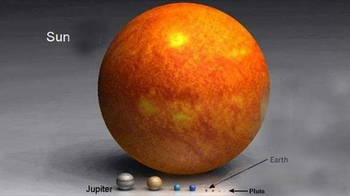
Haven't fact-checked it, but assuming its correct, these are some useful perspectives ;)
Chinese ASAT test analysis in Google Earth
Posted on Sunday, February 18, 2007
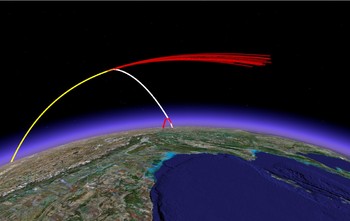
Click to enlarge
Catching up on my blog role after a week of virtually no second life activities (is that proper English?), I come across a post at OgleEarth on the Chinese Anti-Satellite test I blogged about last month. Turns out researchers at MIT's Science, Technology and Global Security Working Group did exactly what I was looking for: a visualisation of the satellite kill in Google Earth.
Apart from the kml file displaying above scene in Google Earth (which as yet appears to be a static visualisation only), they also issued a report on the same website which gives some further analysis of the event. It is here that I am happy to find the first (well, actually 2nd ;-) online evidence of the use of Google Earth for actual visualisation in the realm of space engineering and analysis beyond mere pretty images (see images at bottom of this post).
Scanning through the document, it seems the program they made the analysis with is a recently released stand-alone program to calculate ballistic missile trajectories which has a direct output to Google Earth. From their website:
GUI_Missile_Flyout is a stand-alone program running under Windows for simulating ballistic missiles with 1, 2, or 3 stages in a framework with a round, rotating Earth. Users can easily input all the necessary parameters in an intuitive graphical user interface (GUI). A modest number of quantities can be interactively plotted on the Interface but the complete trajectory can be saved as either an Excel or Matlab file for further analysis. The trajectory can also be directly displayed in Google Earth for visualization. The GUI can be used to optimize gravity turn parameters to maximize range or aim at a specific target (entered, as is the launch site) through latitude-longitude pairs. In addition to an introduction to using the program, this paper describes the integration of the three-degrees-of-freedom equations of motion and approximations made to the aerodynamic (such as a parameterized drag coefficient, Cd).Incorporating the option to directly output to Google Earth readible format is something that has been occuring on a frequent basis in the traditional GIS field but I haven't heard of it yet in the space arena. I wonder for example what STK's strategy is in this respect? They have their own AGI viewer, but as with all the different GIS viewers, who is interested to have all these different systems installed when Google Earth can handle them all at once, and on top of that is also cross-platform (which most sophisticated analysis tools are certainly not yet).
If you use this program for a publication, please reference: Geoffrey Forden, “GUI_Missile_Flyout: A General Program for Simulating Ballistic Missiles”, submitted to Science and Global Security. December 2006.
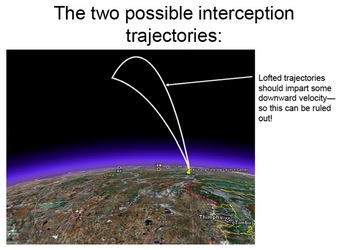
Click to enlarge
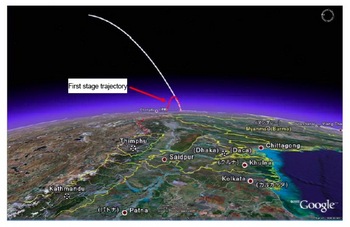
Click to enlarge
Nature's own GPS satellites
Posted on Sunday, February 11, 2007
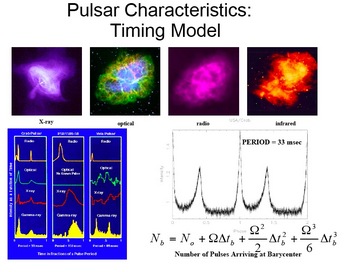
Click to enlarge
Doing some research for a project I am collaborating on with Jeremy Hight, I just learned about DARPA's X-Ray Pulsar-based Navigation and Timing (XNAV) project, a likely candidate for future space navigation beyond the GPS/Galileo web. Seems the whole Solar System will become a location aware arena in the not too far future...
For a good intro, have a look at this DARPA project powerpoint. Some more information can be found at NewScientist (Sep. '06), and The Space Review (Dec. '06).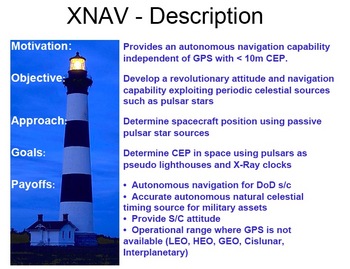
Click to enlarge
The Space Economy
Posted on Friday, February 9, 2007
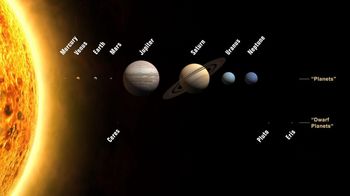
Click to enlarge
How to market a +30 year product/programme like the US Vision for Space Exploration (VSE)? Luckily for us some folks over at NASA are thinking about it:
“As I see it, questions about the Vision boil down to whether we want to incorporate the Solar System in our economic sphere, or not. …The ultimate goal is not to impress others, or merely to explore our planetary system, but to use accessible space for the benefit of humankind.”
Dr. John Marburger
The President’s Science Advisor
Speech to the 44th Robert H. Goddard Memorial Symposium
March 15, 2006
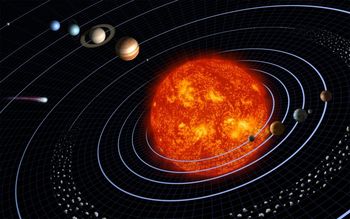
Click to enlarge
YES2 AIT @ ESTEC
Posted on Friday, February 9, 2007
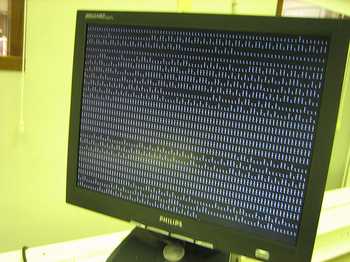
Delta-Utec, the company I have been working with the last couple of years, recently moved its whole Leiden office to ESA's research facility ESTEC in Noordwijk, The Netherlands. The whole YES2 team of students, Young Graduate Trainees and Delta-Utec staff are at ESTEC to succesfully complete the final Assembly, Integration and Testing (AIT) of the YES2 satellite before it is integrated on the Foton-M3 platform and launched later this year on a Russian Soyuz. I have been spending the last couple of days in this highly inspirational environment, working on the follow up of the YES2 mission, working title 'Polyspheres'. Here are some of my impressions sofar.
You, Science and Recursion
Posted on Monday, February 5, 2007

Part of the video in my previous post corresponds to what Kevin Kelly talks about in this very interesting 1-hour presentation on the history and future of the Scientific Method:
Kevin Kelly
The Next 100 Years of Science: Long-term Trends in the Scientific Method (mp3)
Friday, March 10th 02006.
One of the main points he makes here is the importance of so-called 'recursion' for the Scientific Method. I haven't completely grasped his idea yet (need to listen to the podcast again), but it kind of gives a name to a phenomenon I was wondering about myself a couple of weeks ago. As an engineer, I know surprisingly little about marketing but as far as I can see, basically, with the markets now having become global, there is no 'outside' anymore when it comes to marketing. When we market, we (hypothetically) market to the entire world, that is, the entire human population. Which also includes ourselves...exactly this idea of recursion: the process looks back on itself. So does this mean the nature of marketing will change, and if so, what are the 'meta-models' that will come out of this recursion...? Seems to me virtual globes and alike convincingly portray this recursiveness (like the Apollo 8 did back in the '60) and therefore could play a role in this process. Seems also to have to do something with conciousness, but to make that claim I first need to read Godel, Escher, Bach ;)
Btw, more podcasts from Seminars About Long Term Thinking at The Long Now Foundation are available here.
Space Race 2.0: Act 1
Posted on Saturday, February 3, 2007
Where China shows it has space capability while simultaneously calling for an agreement to ban all space weapons and where the space station ISS has to move to avoid debris from the Chinese kinetic kill earlier this year (via NASA Watch).
Sea Launch rocket blows up
Posted on Friday, February 2, 2007
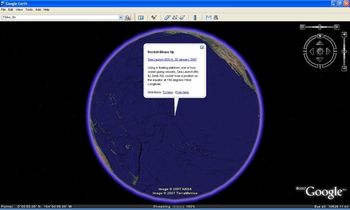
Click to enlarge
This one didn't make it to outerspace.
Space Arms Race, Here we Come!
Posted on Wednesday, January 31, 2007
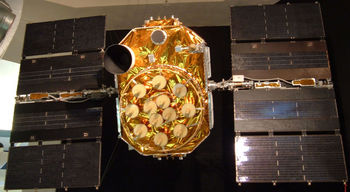
Click to enlarge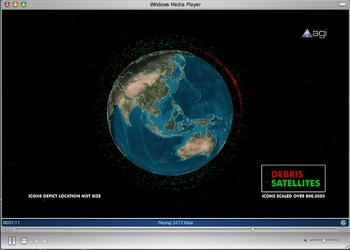
Click to enlarge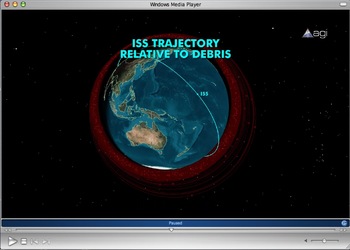
Click to enlarge
[Update Friday 2nd Feb 02:00 CET: The new space race has apparently already started. More news, including a STK visualisation of the debris cloud resulting from the kinetic kill, at AGI's Center for Space Standards & Innovation (CSSI) (via Spaceports blog)]
Excellent title of this space blog entry at the Lifeboat Foundation, following the Chinese Anti Satellite (ASAT) weapons test earlier this month:
Space Arms Race, Here we Come!It’s true - when one nation moves into space weapons, others are forced to follow just to keep up. It’s the Red Queen scenario, where you have to keep moving forward just to stay in the same place. Because preventing the weaponization of space is likely impossible, it looks like we will have to come to terms with it. One beneficial side effect of a space weapons could be the development of better space systems in general, which could eventually be used to create autonomous colonies.
The latter could actually be true. If so, what could be the emerging technologies out of this new weapons race, or out of the upcoming peaceful Moon race variant as described in this 2004 Space.com article:
Strategic target“The moon is the first step beyond low Earth orbit that any spacefaring nation is going to try to master,” said Mike Duke, a geologist at the Colorado School of Mines in Golden, Colo. The Europeans have passed that mark, he added, so their lunar missions are described as technology demonstrations.
Meanwhile, the Japanese are trying to display their technical prowess in instrumentation. “They need to demonstrate a reasonable launch capability to be considered a player in that arena. They’ve had some problems, so maybe the lunar mission is a driver to keep the rocket folks focused,” Duke said.
Duke said China and India have arrived at a place in their development where they can do lunar missions and gain in stature among spacefaring nations.
“I’m afraid that I don’t see that any of these really involve the moon as a strategic target for exploration, though everyone is looking for that strategic handle,” Duke said.
“I'm not sure what to make of it all in the grand scheme of things,” said Paul Spudis, a planetary scientist at the The Johns Hopkins University Applied Physics Laboratory (APL) in Laurel, Maryland.
A number of factors are stirring multi-nation lunar interests, Spudis said. For starters, in the quest to get beyond low Earth orbit, the moon is an easy first target. Then there’s the idea that, somehow, the moon’s history is intimately tied to that of the Earth. Lastly, there is the simultaneous emergence of space capabilities among industrialized countries, as well as coincidence.
“Which predominates? I’m not sure,” Spudis said. “I’d like to think that there is emerging recognition of the strategic value of the moon. But although I do think that is present, it’s not the principal driver,” said Spudis, who was a member of the President’s Commission on Implementation of United States Space Exploration Policy, which advised the White House on how best to move forward on a moon, Mars, and beyond human and robotic exploration strategy.
“In fact, as far as the [Bush] Administration goes, it is the principal driver of the vision, not a human Mars mission … in contradistinction [contradiction] to the intense belief of many who work at NASA,” he said.
Pointing to several nations that are hammering out lunar exploration plans, Spudis said he senses that India’s program is an attempt to promote space science and technology, and demonstrate that they are, indeed, a 21st century, industrial nation. China has similar goals, he said, but is focused more on servicing their “international inferiority complex” to help underscore “that they too are a great nation.”
The emerging technologies from some earlier military involvement in space included what...V2? Sputnik? microprocessors (as discussed in an earlier post)? Keyhole (aka Keyhole)? GPS? Its probably a bit too early to discuss now, but I can see it become part of this conference in the future.
Btw, I am curious to see the trajectory of the Chinese interceptor in Google Earth, anyone has a line to the Chinese military?...the American military perhaps? If so, drop me a note or leave a comment!
Communications & travel
Posted on Wednesday, January 31, 2007
From an interesting piece by Clay Shirky:
Jaron Lanier is the Charles Babbage of Our GenerationHere we arrive at the furthest shores of speculation. One of the basic promises of virtual reality, at least in its Snow Crash-inflected version, is that we will be able to re-create the full sense of being in someone's presence in a mediated environment. This has been a human desire at least since Shamash appeared to Gilgamesh in a dream. Re-stated in technological terms, this version of virtual reality is a belief that communications will finally become an adequate substitute for travel. We have been promised that this will soon be achieved with current technology since ATT demoed a video phone at the 1964 World's Fair.
I believe this version of virtual reality will in fact come to pass, someday. I do not, however, believe that it will involve a screen. Trying to trick the brain by tricking the eyes is a mug's game. The brain is richly arrayed with tools to detect and unmask visual trickery -- if the eyes are misreporting, the brain falls back on other externally focussed senses like touch and smell, or internally focussed ones like balance and proprioception.
Though the conception of virtual reality is clear, the technologies we have today are inadequate to the task. In the same way that the theory of computation arose in the mechanical age, but had to wait first for electrics and then electronics to be fully realized, general purpose virtual reality is an idea waiting on a technology, and specifically on neural interface, which will allow us to trick the brain by tricking the brain. (The neural interface in turn waits on trifling details like an explanation of consciousness.)
In the meantime, the 3D worlds program in the next decade is likely to resemble the AI program in the last century, where early optimism about rapid progress on general frameworks gave way to disconnected research topics (machine vision, natural language processing) and 'toy worlds' environments. We will continue to see valuable but specific uses for immersive environments, from flight training and architectural flythroughs to pain relief for burn victims and treatment for acrophobia. These are all indisputably good things, but they are not themselves general, and more importantly don't suggest rapid progress on generality. As a result, games will continue to dominate the list of well-populated environments for the foreseeable future, rendering ineffectual the category of virtual worlds, and, critically, many of the predictions being attached thereunto.
Space & the Internet
Posted on Sunday, January 28, 2007
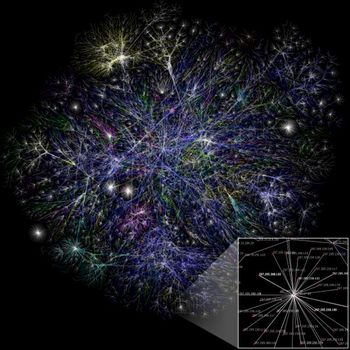
NASA Administrator Michael Griffin is picking up steam in his speeches he is delivering all around the US and abroad on NASA's plans for the future. Here are two of his recent talks, one in Houston Texas, and one at the World Economic Forum in Davos, Switserland. In the latter, I found a quote which resonates with a topic I am starting to get more and more curious about:
I am sure that many of you would agree with me that the greatest revolution in our productivity and way of life has been the development of the personal computer, internet and various handheld communication devices. Thirty-five years ago, engineers like me used three pieces of wood and a piece of plastic that moved -- the slide rule -- to make calculations. Thirty years ago, 1,000 transistors could fit on a silicon chip; today, it's 100 million. The cost of such chips has dropped by a factor of 100,000. Few people know that the development of the first microprocessors was born of a competition between Fairchild and Intel in the 1960s, to build components small enough to fit in NASA spacecraft. This straightforward NASA technical requirement spawned a whole new industry that grew in ways few, except perhaps Gordon Moore, could predict. Necessity is the mother of invention, and I believe that we are at our most creative when we embark on bold ventures like the space program.
The main point here is the relationship between the space endevour and the origins of the chip industry. With this year's 50th anniversary of the first satellite in orbit (Sputnik), it seems the most influential societal outcome of space exploration sofar has been the rise of the computer. I more and more like the term 'emerging technologies' in this respect. On a side note, the launch of Sputnik also stirred the creation of the US 'Advanced Research Project Agency (ARPA)', which later during the Apollo days set up the precursor of the Internet known as ARPANET. I am interested to find out if there has been some more indepth study into this relationship.
Gibson on space travel
Posted on Thursday, January 25, 2007
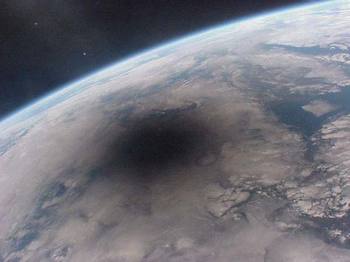
If the ideas of contemporary science fiction writers is anything to go by, here is an interesting interview with William Gibson from back in 1999, where amongst other things, he says the following:
While we were dreaming about spreading our chromosomes, the species was spinning this prosthetic nervous system for itself, and that's what's driving social change now. It's not legislation, it's not population pressures. Where we're going is the result of emerging technologies, and that's terribly rich ground for a science fiction writer.The above image of a Solar eclipse as seen from space is one of the last images made from the MIR station before it was brought down in 2001. In the interview, Gibson specifically refers to it, saying:
I was really deeply moved by one of the last photographs to come out of that station, an image of the Earth seen during the solar eclipse. I thought to myself, "we've never had that camera angle before.
Btw, if the space.com website is any hint at what the main internet portal to outer space will be like (its one of the more popular space related websites at the moment I believe), there is still lots of work to be done...the design is just...well...terrible...!
Project Excelsior
Posted on Sunday, January 21, 2007
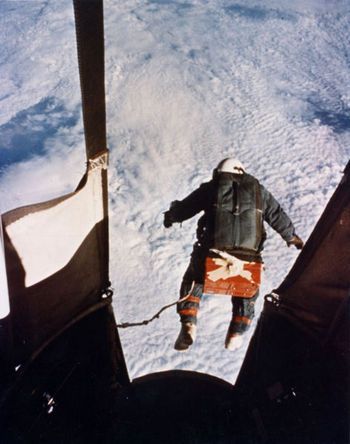
Too bad Joseph Kittinger wasn't carrying a GPS device at the time he jumped out of his balloon carriage back in 1960 (GPS, 1960?). Would be interesting to see his jump in Google Earth. Kind of a space tourism 0.1. Just saw his footage in a clip from Boards of Canada.
Highly relevant ads
Posted on Sunday, January 21, 2007
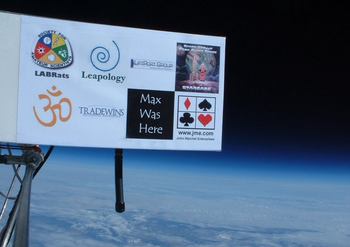
Click to enlarge
Following news on Google's possible acquirement of an in-game advertising firm (first read on OgleEarth), I finally found a reason to upload this image on advertisements in space...When will Google's next ad frontier (WSJ subscription) coincide with the final frontier, either real or virtual? Is there really anything against serving highly relevant ads once people start returning to the Moon? And would it be able to support some good space exploration initiatives? Or even better, some new Earth Observation missions following the warning from the US National Academy of Sciences that the US is underfunding its EO capabilities in the years to come (WSJ editorial: blinding ourselves in space). Its basically in our own interest to have these missions, so why not fund them through Google Adsense...
Tobedetermined finds...Agents of Evolution
Posted on Wednesday, January 17, 2007
- Futurist Peter Schwartz introduces an interesting term new to me in this article: Agents of Evolution
- O'Reilly Radar: Measuring a virtual world and If Google were a restaurant
- How about one of the above cameras onboard the ISS?
- Back to the 50's: China destroys old weather satellite
- Google wants YOU! in Google Earth: Google's Australia Day 2007 aerial photography. Turns out, Microsoft is planning to do the same, with the oh, so Microsofty catchphrase 'Look Up and Smile this Australia Day'
- The archives: Google's Master Plan
Geostationary playground
Posted on Tuesday, January 16, 2007
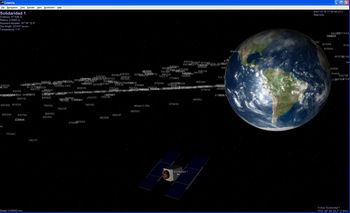
Click to enlarge
Thinking about how 3 dimensional outer space could be represented inside virtual globe environments, I spent some time flying around the Solar System in Celestia. Incorporating some of the satellite plugins available at the Celestia Motherlode, I managed to get the Geostationary ring become visible with all its +100 telecommunication satellites. The nice thing about Celestia is that it allows you to lock onto any object you happen to pass by, so zooming into the individual satellites now visible, I circled the Earth by hopping from one satellite to the next. Funny enough, it actually did gave me a feel of being 'out there', looking down at the Earth from 35,786 km altitude.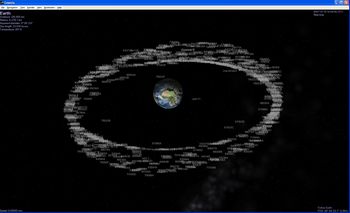
Click to enlarge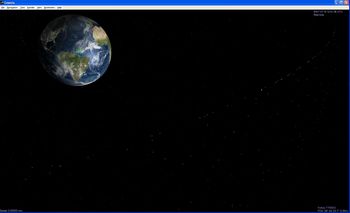
Click to enlarge
tobedetermined finds...
Posted on Monday, January 15, 2007
- Pasta & Vinegar posts on two Google Earth related stories which somehow seem related: (1) using Google Earth as a game interface (following this article on the game site Gamasutra), and (2) Google Earth and the roadmap to the metaverse (based on this story on CNN's Business2.0)
- The End of Cyberspace blog: Second Life avatar consumes as much electricity as a Brazilian
- Not only is 2007 the 50th anniversary of the launch of the first artificial satellite Sputnik, its also the 100th anniversary of Sergey Korolyov, Russia's key designer during the Space Race
- Asimo at CES2007
10 years later: MRO pinpoints Mars Pathfinder
Posted on Friday, January 12, 2007
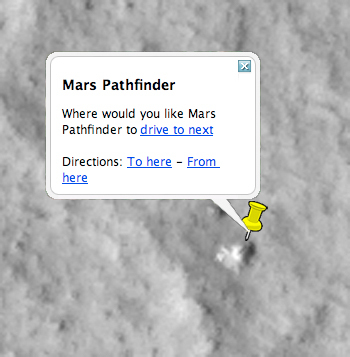
NASA's Mars Pathfinder landed on Mars on July 4, 1997. Just under 10 years later, Mars Reconnaissance Orbiter (MRO) returns to what I recall as the web1.0 highlight of the ongoing merger between outer space and cyberspace. With its Google Earth look-from-above feel, I can hardly wait till this image is Mars-referenced available in Google Mars. More images and stories available at NASA's Mars Pathfinder Landing Site and Surroundings.
click to enlarge
Google's Earth anno 2007
Posted on Friday, January 12, 2007
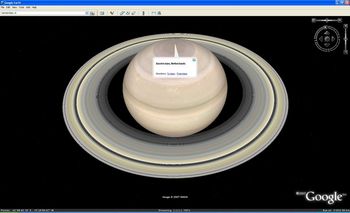
Click to enlarge
Mmm, seems global warming really started kicking in last year (via GEB).
tobedetermined finds...
Posted on Monday, January 8, 2007
- Just in: Google teams up with a large group of universities, research institutions and private companies to become the archival experts for the Large Synoptic Survey Telescope (via OgleEarth). Makes sense to me ;)
- Backlog: OgleEarth shares some interesting reflections in this post on the possibilities following December's collaboration announcement between Google and NASA.
- This year is the 50th anniversary of the launch of the first articificial satellite Sputnik in October 4th 1957 (Listen to the sound of Sputnik as it passed over in those days). This weekend's M special of the Dutch newspaper NRC handelsblad is all about the Internet. Their introduction (my translation):
1 billion Earthlings connected to the Internet
50 years ago the Russians launched their Sputnik. The Americans got scared shitless and developed an invulnerable military information network which saw the birth of the Internet. Today, the net belongs to the massess. - ESA news: First 3D map of the Universe's dark matter scaffolding
- Google Earth Blog has the story of a French company Pict'Earth offering a remote control plane with camera capturing realtime images for Google Earth. OgleEarth picked up the story and expands on it
- Webcasts are available from the 2nd Space Exploration Conference in Houston 4-6 December last year. Unfortunately they're coded in Realplayer, so no offline viewing/listening
Navigating outer space
Posted on Friday, January 5, 2007
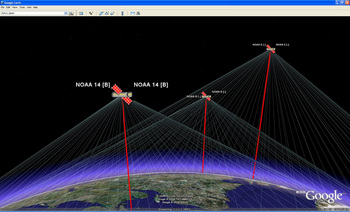
Click to enlarge
Update monday 8 January: I have edited most of below text yesterday after originally posting it on saturday evening. Reading through it again, I noticed how it touches upon a relevant aspect for me of the mediation of outer space through cyberspace: the interface to the planets and 3 dimensional outer space. This post might well be the start of a longer text on this topic.
As you probably noticed, I've been mostly away from the blogosphere the last 2 weeks, spending some enjoyable 1st life here in Amsterdam. As a result, I am now looking at a backlog of ideas, thoughts and interesting stuff out on the web related to this blog's topic which I hope to post about in the coming days & weeks (and a happy new year to all of you of course!). First on my list:
The SpaceNavigator™
I received mine from Germany earlier this week and it turned out even better than I expected. It really is an excellent tool for flying around and 'travelling' in Google Earth. For more indepth reviews of the device, see OgleEarth and GEB.
Using it brings back memories of when I was studying in Delft. It must have been around 1995 when I took a course in 3D modeling and virtual reality. At the time, I was heavily into all things cinema and especially Andrei Tarkovsky, so as part of the VR course I set out to model the cathedral from the final scene of his movie 'Nostalgia'...it was only a test case, and I unfortunately never finished it (the course was over before I could), but during the course I got my first flying lessons in virtual spaceland using one of these nifty interfaces (at that time they were called space mouse). I remember the pleasure of navigating with 6 degrees of freedom through 3 dimensional space, flying through my half finished cathedral. Using the SpaceNavigator now allows me to do (almost) the same stunts in Google Earth. Its a bit like I imagine real life cessna flying could be like if you do not live right under the ![]() airspace of one of Europe's major airports Schiphol.
airspace of one of Europe's major airports Schiphol.
The biggest surprise after firing up Google Earth with my new SpaceNavigator came from the possibility to look up, to look at the stars, away from the Earth, something which with normal keyboard navigation I never managed to do. Suddenly Google Space starts to make a lot more practical sense. Its like what Micheal T Jones (Google Earth CTO) talked about in his Google Earth talk a year ago, where he, refering to work by Tjalling Koopmans, discusses how we as humans are shaped by our tools (as in 'the medium is the message' by Marshall McLuhan).
Below image is one such example of a Google Earth view I never managed to get before my SpaceNavigator arrived (the Earth is somewhere below the screen). And I like the way Windows confirms plugging in my SpaceNavigator with "Found new hardware: USB human interface device" ;)).
Having been stuck with the Earth-centric view in all of todays digital globes out there (and/or Moon/Mars centric in the case of WorldWind), the opportunity to look away made me wish for more. I for one would like to navigate through outer space in Google Earth, to turn around and head for the Moon. Sofar, releasing my SpaceNavigator makes me instantly flip back to the Earth, as if my sticky eyeballs are glued to it.
I have seen navigating through 3 dimensional 'outer space' in Celestia, an open-source 3 dimensional space simulation available for free on the web. During the holidays, I played around with it again after seeing it on a big screen at the NASA Ames exploration Center last November where it was used to explain to the audience about the solar system and beyond. The interface is somewhat different from Google Earth and the others, but once you get the hang of it, its really enjoyable to navigate through the Solar System, have a close up view of the Jupiter moon system, take a warp drive outside our own galaxy and safely return back to our 'default' Earth.
tobecontinued...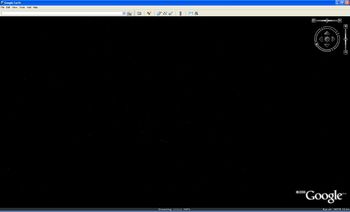
Click to enlarge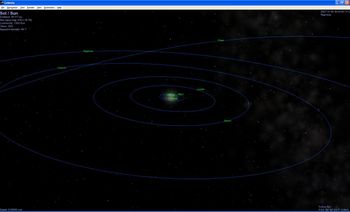
Click to enlarge
Outer space in Second Lie Life
Posted on Sunday, December 24, 2006
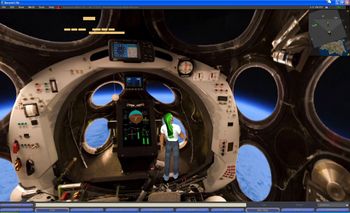
Click to enlarge
With the holidays and all, I had some time to spent looking for the International Space Museum (ISM) in Second Life. After having to complete the first test level (grrr), taking me more than an hour, I finally was allowed on the real playing field. Turned out the testing in the beginning was actually quite handy, cause I knew immediately how to get to the ISM as fast as possible...just type it in and search...boom....teleported and dazzled, I was throw out into the ISM piece of land...
btw, how you like my green hair? ;-) 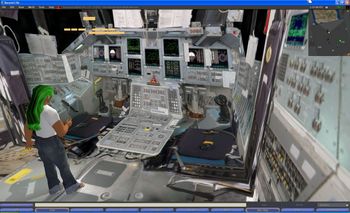
Click to enlarge
NASA Google media briefing today
Posted on Monday, December 18, 2006
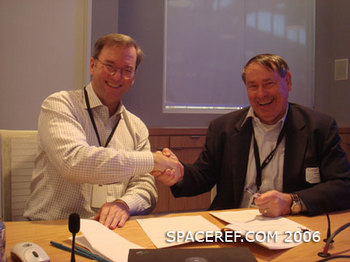
Update 01:43 CET: News is out. Here is Google news' listing of websites (178 and rising) describing the press release and media briefing. The two core Google Earth blogs OgleEarth and Google Earth Blog provide further insight. I'll try to put some thoughts on paper myself when I find the time (oh, and the image of Eric Schmidt (left) and Pete Worden (right) is courtesy of SpaceRef...in case you hadn't noticed).
Update 18:24 CET: NASA Ames has just issued a press release providing more details on the NASA Google collaboration (via Google Blogoscoped)
Today is the day of the media briefing at NASA Ames. It has been nice to see news about last friday's event and today's media briefing spread around the Internet, starting with the original post on NASA Watch. More when it comes in...here is a good start <-- update: this website (googlenasa.com) was taken down on monday after having been slashdotted and Chris C. Kemp responding to a request from Google to take it offline
Extra spacewalk for Christer Fuglesang
Posted on Sunday, December 17, 2006
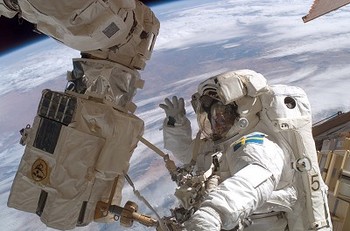
ESA has the news of a new spacewalk for ESA astronaut Christer Fuglesang, tonight at 19:47 CET. Follow it live via NASA TV.
Zooming out in Google Earth
Posted on Saturday, December 16, 2006
' 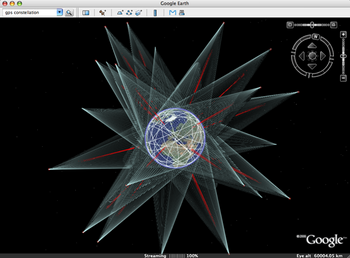
How long before Google Earth levels (and surpasses?) STK, the arcGIS of space...?
Above image is a screendump of one of the ![]() beautiful layers provided by Google Earth Community (GEC) member Paul Seabury (via Google Earth Blog). This
beautiful layers provided by Google Earth Community (GEC) member Paul Seabury (via Google Earth Blog). This ![]() particular one shows the GPS constellation in orbit around the Earth, together with a footprint of each individual satellite. Which reminds me of an earlier mash-up thought experiment I did by superimposing a Google Earth screendump with an image of the NASA J-Track 3D Java applet (see below). To get a feel of what that could be like, see instructions on the J-Track 3D opening page, click individual satellites to highlight their orbits, and drag the viewpoint around. Its a very light application and the combination of zooming and tilting the scene really 'gives handles' to the Geostationary orbit.
particular one shows the GPS constellation in orbit around the Earth, together with a footprint of each individual satellite. Which reminds me of an earlier mash-up thought experiment I did by superimposing a Google Earth screendump with an image of the NASA J-Track 3D Java applet (see below). To get a feel of what that could be like, see instructions on the J-Track 3D opening page, click individual satellites to highlight their orbits, and drag the viewpoint around. Its a very light application and the combination of zooming and tilting the scene really 'gives handles' to the Geostationary orbit.
Its a limitation of Google Earth I regularly run into: the limitation in the ability to zoom out. Currently, the furthest one can zoom out is to 'eye altitude 62355.98 km' (how does that work again?), not even enough to view the complete Geostationary ring, as is apparent in below image of ![]() Paul's Geostationary satellites layer (note zoom level of the two images is nearly identical).
Paul's Geostationary satellites layer (note zoom level of the two images is nearly identical).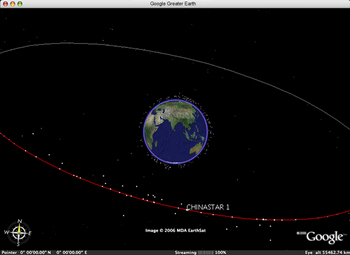
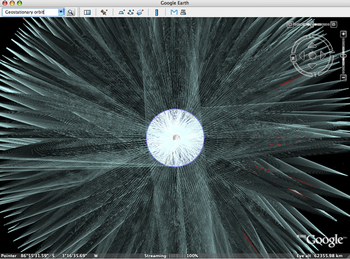
NASA-Google collaboration kick-off event
Posted on Thursday, December 14, 2006
Update2: Ames issued a release on friday announcing a media briefing this monday to discuss the NASA-Google Agreement.
Update: SpaceRef has the story that the joint announcement on collaboration which was to happen at the kick-off event is delayed...
A NASA-Google collaboration kick-off event is being organised at NASA Ames tomorrow today (Friday 15th) (Ames/Google personnel only it seems, more at NASA Watch, OgleEarth and more). Too bad I had to go back to Europe last week. Good luck Chris!
Christer Fuglesang out for a walk
Posted on Thursday, December 14, 2006
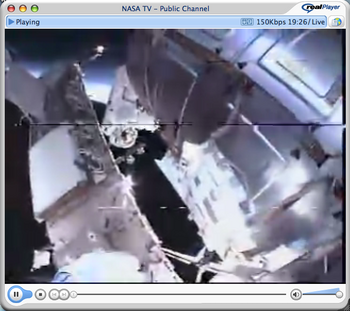
Update: they are back inside (01:21 CET)
For those of you connected to the Internet right now, Christer Fuglesang is out taking a walk.
YES2 is bloggin' again
Posted on Thursday, December 14, 2006
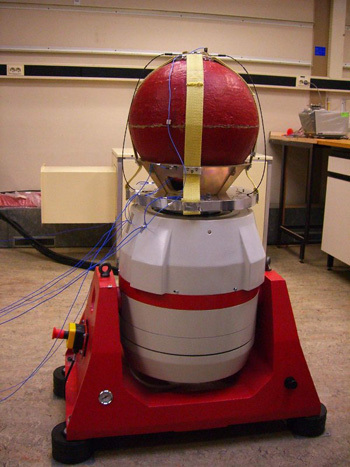
After a couple weeks offline due to an unfortunate hack, the YES2 website is back...as a blog! Yes, satellites also blog...
Finally we get to see some of the testing presently taking place on YES2 at ESA/ESTEC in order to deliver the flight hardware to ESA early next year. YES2 is scheduled for launch onboard Foton-M3 in September 2007. Keep up the great work guys...and keep that satellite bloggin'...
Stormy space weather ahead
Posted on Thursday, December 14, 2006
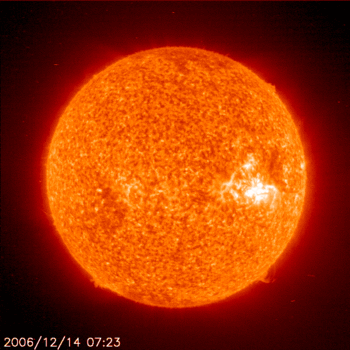
Update 18-12-06: Solar storm disrupts satellites
(via NASA Watch)
Opportunity has left the rim...
Posted on Wednesday, December 13, 2006
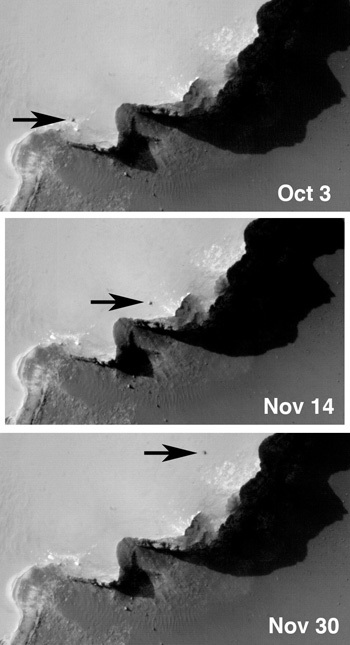
The Mars Reconnaissance Orbiter (MRO) keeps an eye out on the Mars Exploration Rovers as they scout the red planet. It has also found the landing sites of the two 1976 Viking Landers (more at NASA).
Big Brother ISS
Posted on Tuesday, December 12, 2006
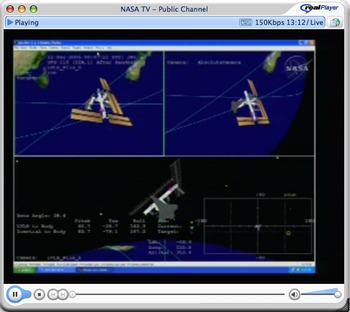
Just tuned into NASA TV (back after a couple of days offline illness), just in time for the live coverage of the hatch opening of the Space Shuttle Discovery to the International Space Station...'hatch opening...5:54 central time...6:54 Eastern' speaks the voice over...watching the two crews welcome eachother, and seeing the inside (and outside) of the space station from different camera positions, I start to wonder where I saw this before...
Its an expensive one, but its Big Brother allright...and quite an interesting one too...the only thing missing is the audio...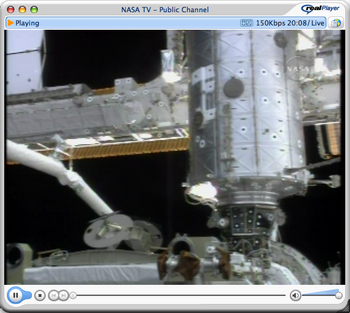
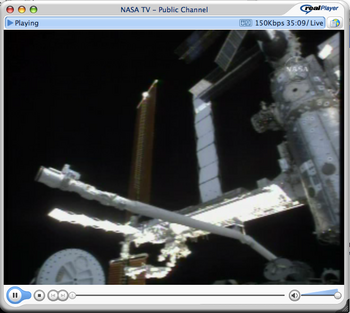
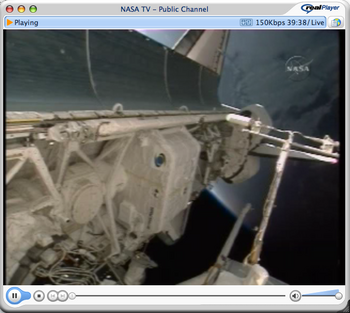
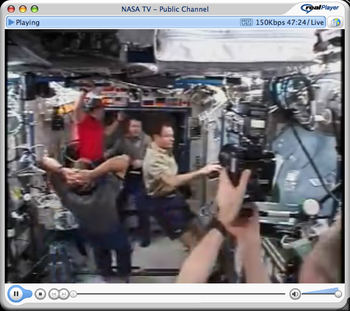
AIAA Space Exploration Conference
Posted on Tuesday, December 5, 2006
...started today in Houston. Read up-to-date blogging news from the conference at NASA Watch. One of the interesting comments sofar:
Replacement for TDRSS - and development of a comm system around the moon and then at Mars.
Virtual space exploration update
Posted on Saturday, December 2, 2006
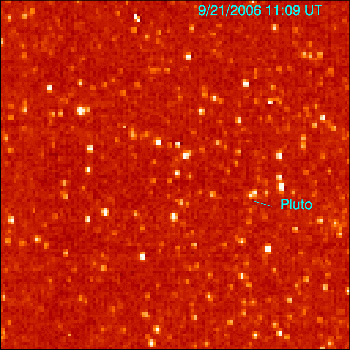
Seen at a distance of 4.2 billion kilometers, NASA's New Horizons mission captured a glimpse of its final target Pluto late September. Last week, NASA's Mars Reconnaissance Orbiter (MRO) mission located the landing site of the Mars Exploration Rover Opportunity (via Nasa Watch). By now, MRO's HiRISE team is flooding Mars images over the Internet.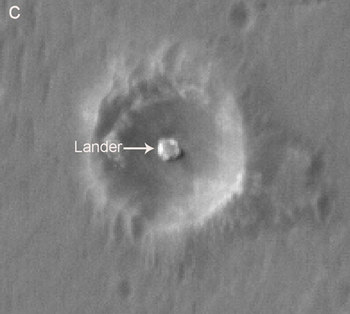
NASA moves into virtual worlds
Posted on Thursday, November 23, 2006

NASA is planning on building a virtual world for training and educational purposes. Its slashdotted here, which made it go around the world, like here at HighEarthOrbit, SlashGeo, Second Life News Network (SLNN) and KnowproSE. Daniel Laughlin, a project manager at NASA's Learning Technologies Office recently gave a presentation about it at the International Spaceflight Museum in Second Life (via OgleEarth). Here are some flickr images of the Museum.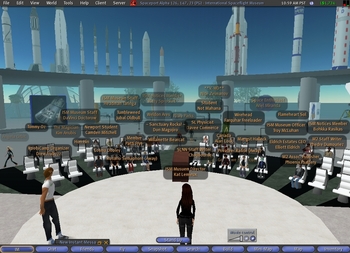
Satellites, humans, and the Internet of Things
Posted on Monday, November 20, 2006
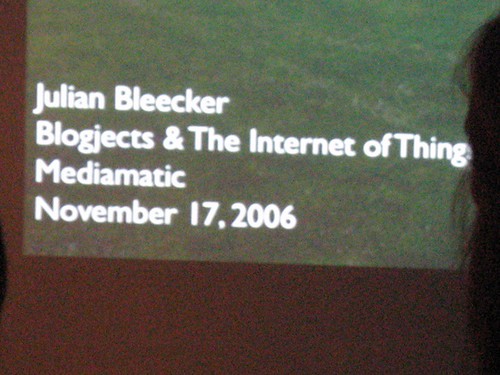
Julian Bleecker was here in Amsterdam for the RFID workshop at Mediamatic. Friday evening he gave a public talk on 'blogjects & the Internet of Things'. Made me think: what are satellites other than blogjects? (more on blogjects at Julian's techkwondo) And what about humans as presented here at Neven Vision? 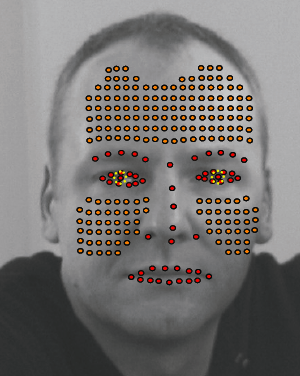
'...scroll over him with your mouse cursors...and...right-click!!'...Indeed, a good point by Julian: what do we learn that is useful from WoW 1008?
'realtime view of the Earth' widget?
Posted on Sunday, November 19, 2006
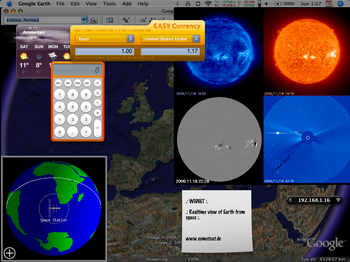
Just in: a demo video of Microsoft Virtual Earth 3D (which comes out blank on my macintosh btw) (via OgleEarth). Where do you want to go today? What about here:
(more at the SOHO website)
YES2 Google Earth
Posted on Thursday, November 16, 2006
Here is another one of my older posts (May '06) which I managed to bring back from digital oblivion by specifically interrogating The Google about my domain name and looking at the cached pages (search string 'site:tobedetermined xxxx'). Its only good for text though, cause other stuff like images is not cached (thanks for the tip Jurryt).
Recovered post:
Following up on my suggestion about the resemblance between the 3D GoogleEarth implementation of the TWA flight-800 disaster and the 2.5D visualisation currently available in YES2's Re-Entry Simulator Tool (REST), Marco Stelzer of the YES2 team at ESTEC has done a great(!) job implementing a REST2GoogleEarth output file option in REST.
The REST simulator, which is part of the larger YES2 mission simulator YESSim, is currently under development for ESA's 2nd Young Engineers' Satellite in order to study and control the landing of the YES2 'Fotino' re-entry capsule. The educational YES2 mission is designed to return a small capsule from space to the Earth using a 30 km long tether. Its launch is currently sheduled for October next year from the Russian launch base Baikonur onboard the Foton M3 spacecraft.
One of the REST2GoogleEarth output files developed by Marco provides an elegant display of the re-entry trajectory as calculated by REST, starting in this case from an initial altitude of ~253 km. Clicking on one of the dots brings up the longitude, latitude, and altitude of the capsule at that particular time in the re-entry (Directions: To here - From here ;) ). In this simulation, the time from start at 253 km to landing of the capsule in Kazachstan takes ~30 minutes. Its not so visible in this particular simulation, but I remember from an earlier one that the influence of the wind (through implemented wind models) on the final stage of descent comes out very nice in the GE visualisation.
In another section of the simulation tool, this 2nd REST2GoogleEarth output file shows the outcome of a monte-carlo simulation of the proposed landing site of the capsule, where each little dot represents a calculated landing point of the capsule. If you zoom out, you start seeing the landing ellipse of the Fotino capsule, representing the 3-sigma chance distribution of the actual landing position of Fotino.
For more on YES2, see their YES2 website (update: which is currently down I believe after having been hacked and them not having the time to bother with a website while building a satellite...). Once its back on, here is a short movie I shot & edited back in 2003 called YES2 meets...Michiel Kruijff with a brief introduction to the YESSim simulator.
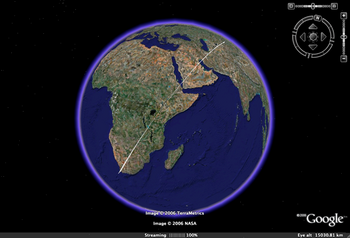
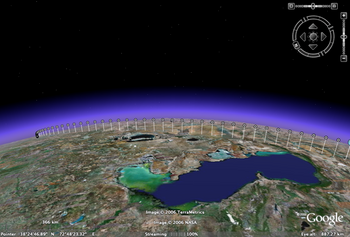
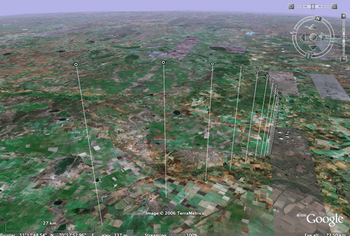
Pale blue dot update
Posted on Sunday, November 12, 2006
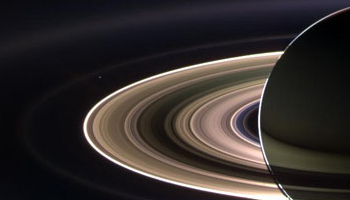
The little white pixel just above the rings of Saturn is...yep...the Earth. Here is the original Pale blue dot. More about this image at Saturn daily.
Space Atlas and more...
Posted on Monday, October 23, 2006
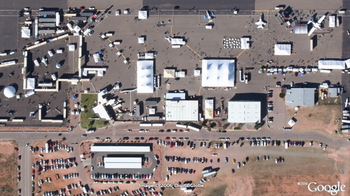
Some catching up to do. Frank Taylor at GoogleEarth Blog has been travelling to the X-Prize cup at Las Cruces Airport in New Mexico. Here are some of his posts on it:
- A Space Atlas layer in Google Earth.
- His flight to the event and back again, both displayed elegantly in Google Earth.
- An aerial photo he made of the exhibition, loaded into Google Earth the same day.
Nice!
Posted on Monday, October 23, 2006
Google buys SpaceShipOne replica (via John Battelle's SearchBlog).
The other way around
Posted on Thursday, October 5, 2006
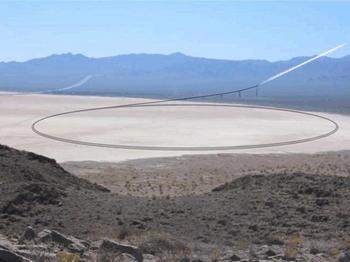
Re my post below, New Scientist just published an article about shooting nuclear warheads (aka satellites) back into space...
The future is process, not a destination
Bruce Sterling
Everything is ultimately becoming information technology
Ray Kurzweil
Data is the Intel inside
Tim O'Reilly
There is only one machine and the web is its OS
Kevin Kelly
The medium is the message
Marshall McLuhan

